Central Gabon, 2018
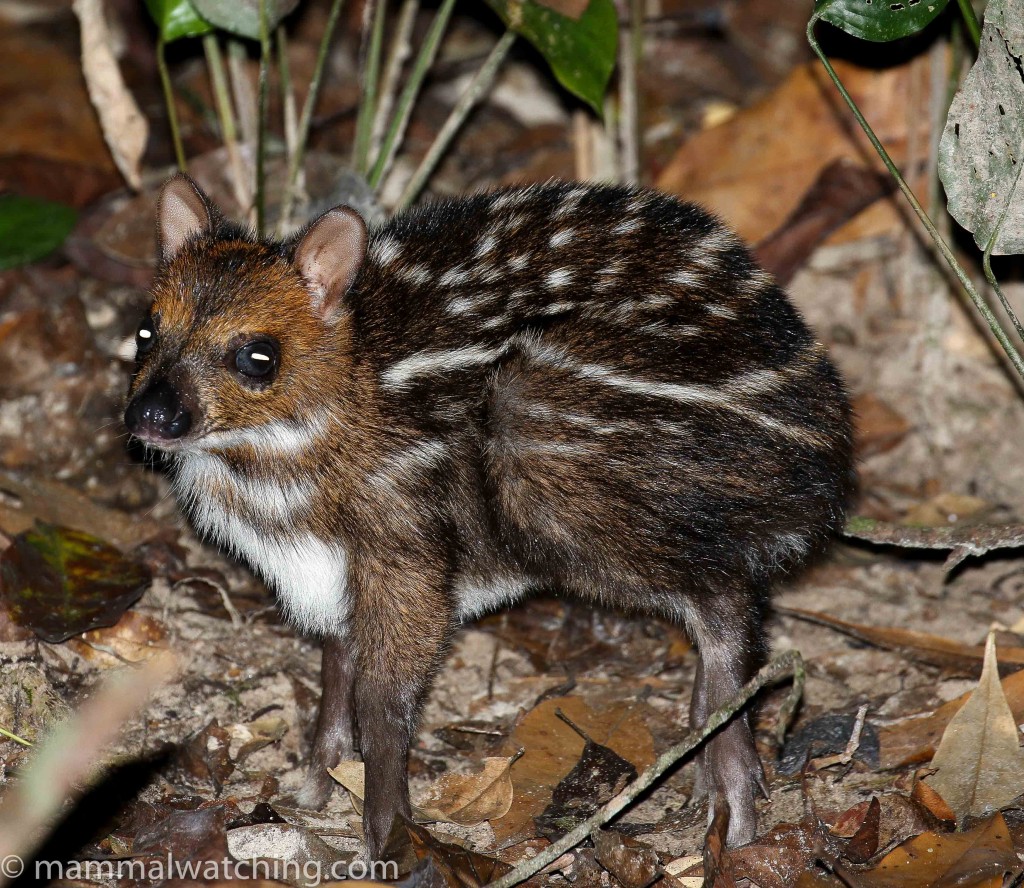
Water Chevrotain, Hyemoschus aquaticus. Mikongo Camp.
Kevin Bryan, Paul Carter, Jon Hall, Charles Hood, Sjef Ollers, Anja Palmans, Judy Parrish, Venkat & Hari Sankar and Ian Thomson.
Warning: This trip report may seriously damage your bank balance. Readers who have previously considered visiting Gabon and chosen other destinations may want to consider professional counselling services.
What makes for a great trip? Sometimes you see all of your target species. Sometimes you take an adventure into the unknown and see some cool animals. And sometimes you see a truly mega-mammal. To say that this trip scored highly on all three dimensions is an understatement. If we’d seen half as much this would have been a fantastic trip!
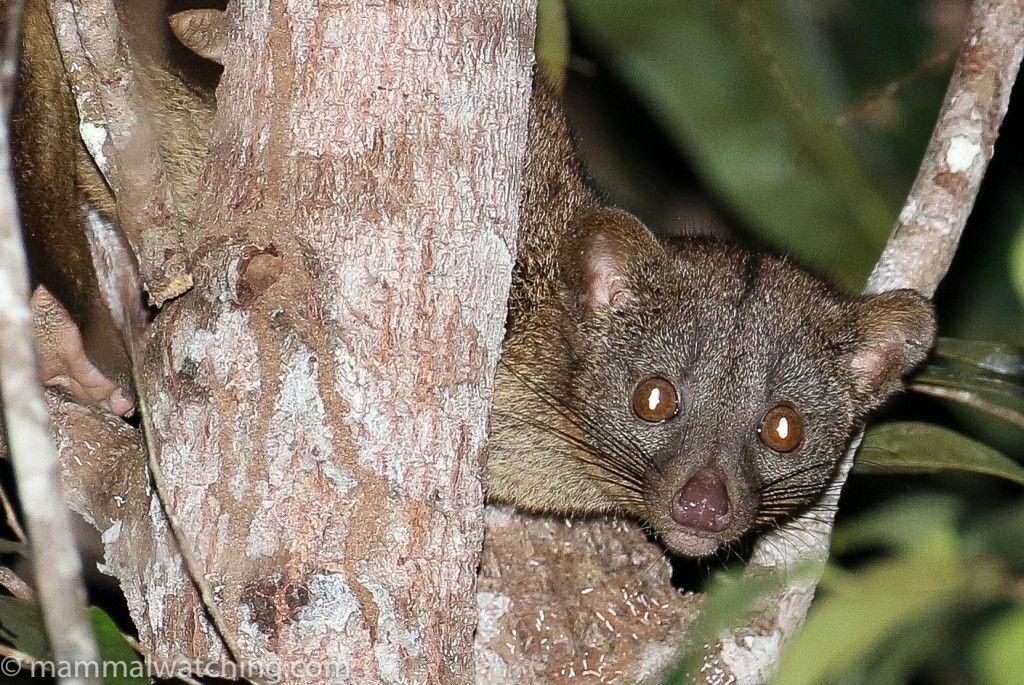
African Palm Civet, Nandinia binotata. Lope National Park.
I have long wanted to see wild Mandrills: their technicolored butts were a highlight of every visit to the zoo when I was tiny. About ten years ago I looked into a trip to Gabon; so far as I know now the only country that you have a decent chance of seeing them. But a double whammy of extreme expense and having to travel with a group of French tourists was the end of that idea. Shortly after I heard that some of Gabon’s prime mammal destinations – most notably the Mandrill tracking at Lope National Park – had closed. I shelved my plans.
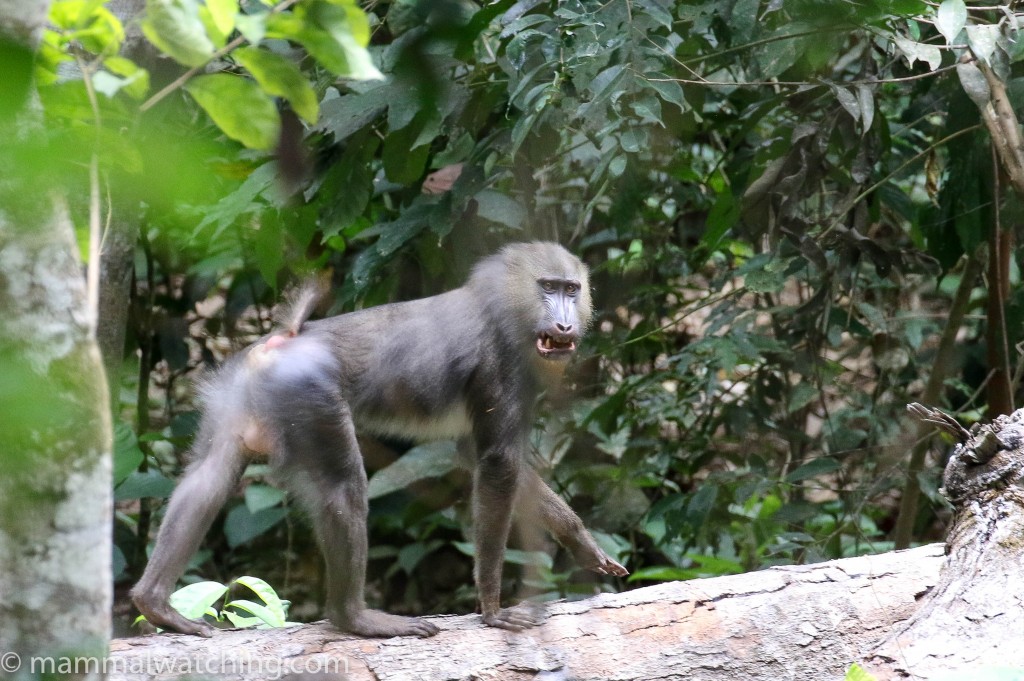
Mandrill, Mandrillus sphinx. Lope National Park.
And then in the summer of 2017 I saw Mogens Trolle’s wonderful Mandrill photos and asked him to send me a trip report. Gabon – it seems – was back in the game. I immediately began planning a trip and very quickly had a group of top notch mammalwatchers signed up.
Logistics
Like Mogens I organised this trip with Guillermo Casasnovas at Middle Africa. Guillermo, a Spaniard based in Cameroon, knows the country – and how to get stuff done there – very well. Middle Africa generally work with tour operators, rather than individuals (though I was granted special priviledges because of mammalwatching.com). I think it is fair to say that he isn’t an expert in the wildlife, beyond the well-known mammals. And so designing a mammalwatching itinerary around our hit list of mostly obscure species involved a fair amount of guesswork. The good news is that almost 80% of the country’s two million people live in cities. And so much of Gabon’s 270,000 square kilometres is undeveloped and home to a lot of wildlife. It has enormous potential for ecotourism which is an idea the government seems to have embraced. But there seem rather few sites that can realistically be accessed in a short time. I focused on places where I thought we’d have a chance to see a broad variety of species, and would also have the freedom to look for things at night. Such freedom is not always possible, especially I believe in some of the more popular tourist destinations.
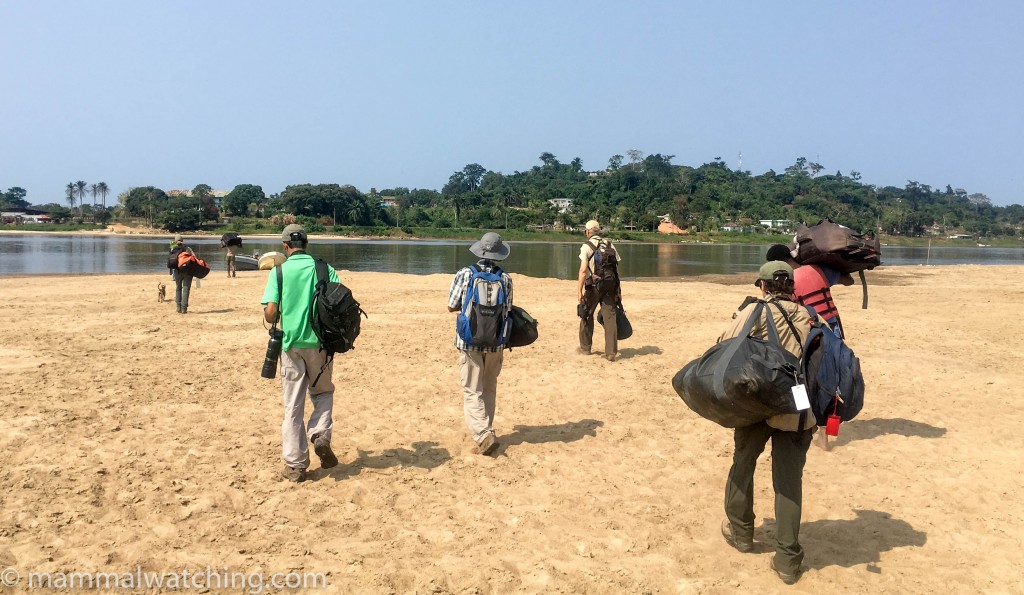
Shipping out to Tsam Tsam
Again on Mogens’ advice we requested Vianet Mihindou to be our local guide. This was a fabulous recommendation: thank you Mogens! I cannot think of enough good things to say about Vianet. He was remarkably patient, always in a good mood, had boundless energy and a genuine enthusiasm for – and knowledge of – mammals. He’s a PhD in ecology, speaks excellent English and had spent many years working in Lope National Park. So he knows every wildlife person in Gabon (and it seems pretty much every Gabonese woman under the age of 40 knows him!). All of that meant he was able to open all sorts of doors for us often at short notice. I think we may have inspired him to build up the mammalwatching portfolio of Gabonese destinations, and he is already researching other sites. He is also able to do a great deal of the local organisation for a trip. Hopefully you get the picture: hire Vianet!
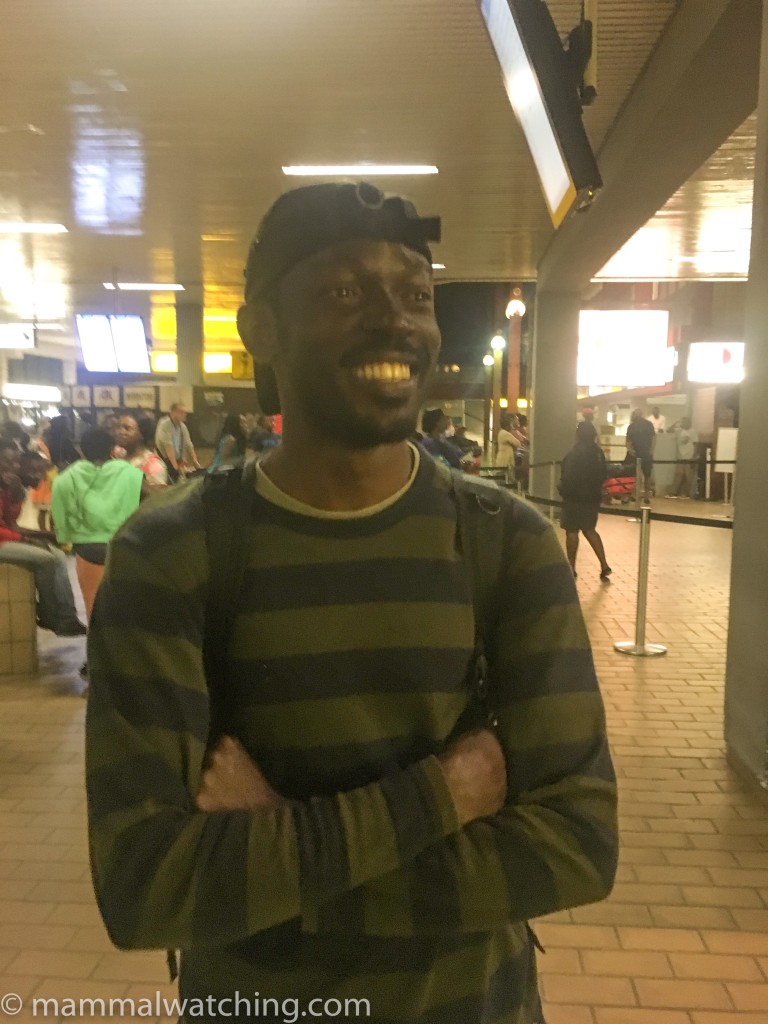
Vianet
The other local guide we used was Ghislain Ngonga Ndjibadi, who works for the Association des Eco-Guides Mikongo’Vision in Mikongo Forest. He was also very good. Quiet, enthusiastic and patient, with brilliant eyes and an almost supernatural (and I might add super annoying) ability to always find exactly the right spot to see things before I did. As a result he saw several animals that no one else managed to get on to.
The trip was priced as full board other than at Lope where we paid for our own meals. Beer and tips of course were extra. Everyone ran out of money by the end go the trip: so you might want to budget an extra 50 euros a day for food and drink if it isn’t provided.
When to go
June through September seems to be the best time to visit Gabon primarily to avoid the rains, during which access to some of the sites can become difficult to impossible. The weather in August was perfect: though we were on the equator the temperature seldom got above 25C, humidity was pretty low and the nights were cool enough to sleep well. There were very few mosquitos, flies or ants though I got hammered somewhere during my last couple of days and my insect bites are still raw and itching as I write two weeks later. I suspect this happened after I took an impromptu hike, wearing flips flops and shorts, through Mikongo forest to track down a Gorilla. Malaria is rife, even if mosquitoes weren’t so present when we were there.
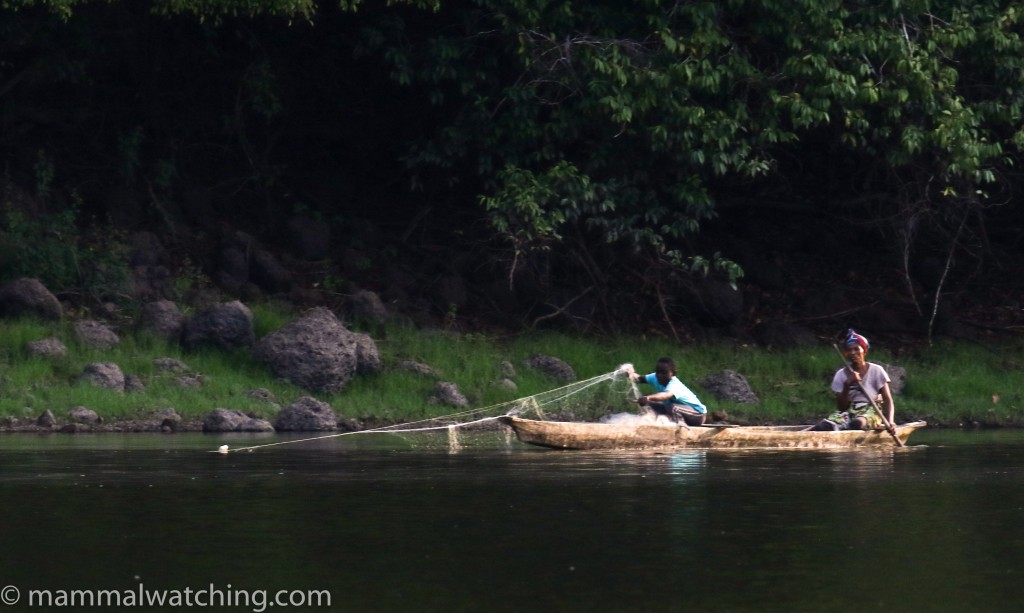
Tsam Tsam fishermen
Visas
All of us needed a visa. You can apply at your local embassy, apply online for an e-visa, or ask the ground agent to obtain an authorisation for travel document from the local police. We were advised that applying through an embassy for a visa can end up quite complicated. As can applying for an eVisa which, even if granted, could mean a long queue at the airport to have it issued. So we paid a bit extra to get an authorisation to travel: essentially a PDF form that we could wave at airport check-in to get on the plane, and then wave at the immigration officers when we arrived to get an entry stamp. Probably worth the extra expense though other people have said the e-visas can work well.
Gear
Radio tracking Mandrills with David Lehmann. Lope National Park. (Photo by Charles Hood)
We had enough optics to kit out an SAS squadron. Binoculars aside, two things were vital.
First, four of us had thermal scopes which I am certain helped us to find many more mammals than we would otherwise have done. They were useful both day and night and we tramped through the forest in formation, scanning every tree looking like murderous aliens from some film I don’t remember. In the daytime the scopes are useful for finding squirrels and duikers. My previous experience with rainforest duikers is that – in the daytime especially – they are hard to see. When you do see one you usually see just a blur of animal bolting through the trees. But we found dozens of duikers using the thermal scopes. They were typically frozen in the forest, 20 metres or so away from us. Even when we knew an animal was there it could still be extremely difficult to see it in my binoculars: they just melt into the forest background. But usually we could locate them and would get a good enough look to decide on the species.
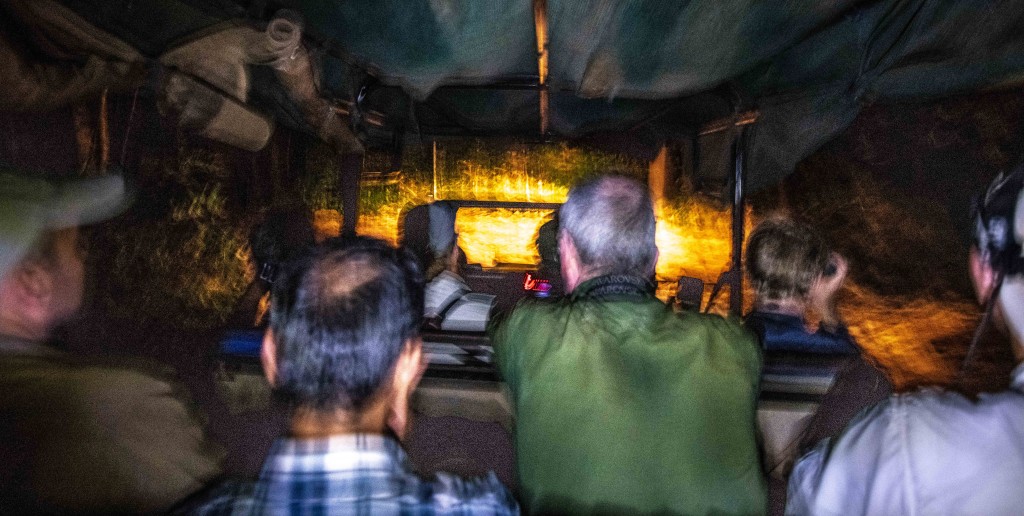
Night drive in Lope. Photo Charles Hood
Second, we had a bunch of dedicated photographers with us. In particular, Paul, Sjef and (usually) me had our cameras with us all the time and so we managed to get photographs of the vast majority of what we saw. This proved absolutely vital to being able to figure out accurate IDs for a bunch of species. In fact there are only 10 species on our final list that weren’t photographed.
Kingdon’s Field Guide to African Mammals was the only field guide we used in Gabon. It helped get most stuff down to genus at least.
Itinerary
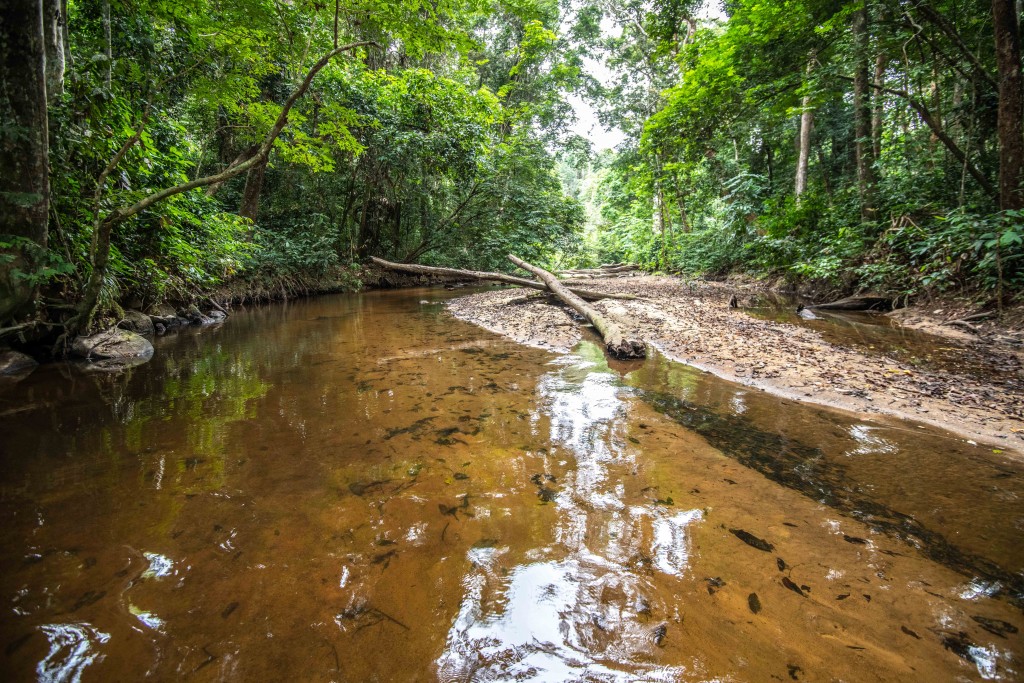
The river at Mikongo Camp. Photo Charles Hood
Our itinerary was based partly on discussion with Guillermo, partly on the few trip reports I could find, and partly on gut instinct. In the end it worked out very well and if I was to do it all again I would only tweak one or two things slightly. Our planned itinerary had us spending Saturday 24 in Lambarene: we bailed on this idea at the last minute. I would not advise spending a night there unless you don’t have any other options.
Saturday August 11: Fly late into Libreville
Sunday August 12: Day trip to Pongara National Park, stay Libreville
Monday August 13: Doing very little in Libreville, evening/night train to Lope National Park
Tuesday August 14 – Thursday August 16: three full days and nights at Lope National Park (based at the hotel)
Friday August 17: transfer to Mikongo Research Camp (two hour) drive
Saturday August 18 – Monday August 20: three full days and nights at Mikongo Camp
Tuesday August 21: return to Lope hotel then overnight train to Ndjole
Weds August 21: arrive at Ndjole at 5am then a two hour taxi to the town of Lambarene and two hour speedboat to Tsam Tsam Lodge
Thursday August 22 – Friday August 23: two full days and nights at Tsam Tsam
Saturday August 24: return to Lambarene by boat then a five hour drive to Libreville
Sunday August 25: half day trip to Akanda National Park. Depart Libreville for home that night.
Site Guide
Akanda National Park
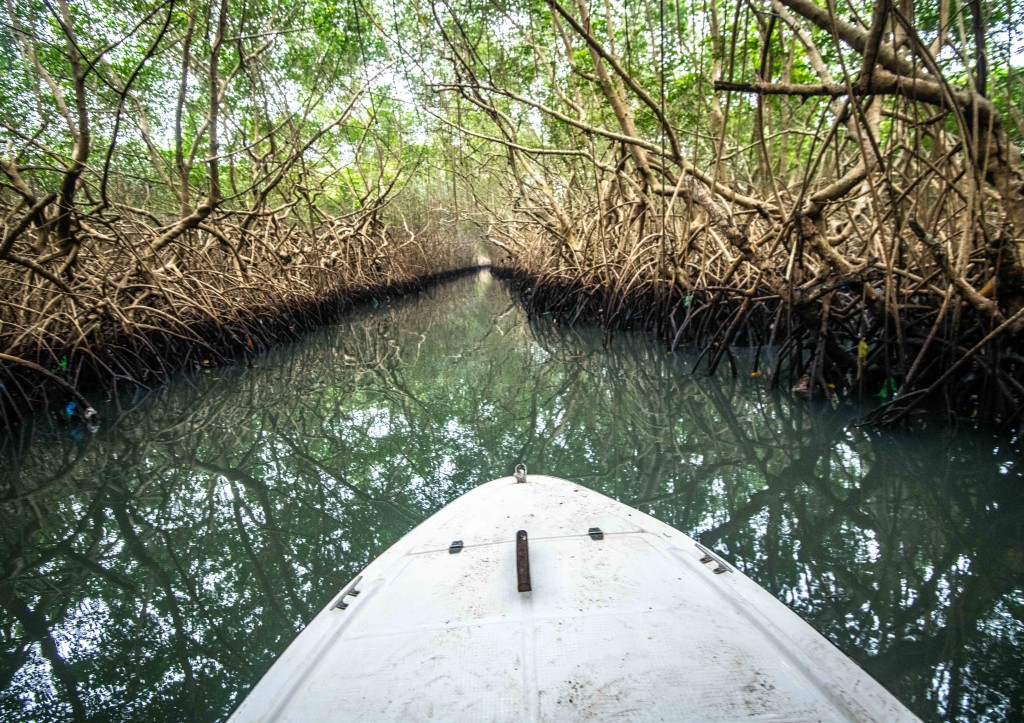
Boating into Akanda National Park. Photo Charles Hood
An hour’s boat ride from the east side of Libreville takes you to the heart of this national park. The park covers the mangroves and islands of Corisco Bay. We spent a morning here on our last day but – with some planning – it might be possible to spend a night at a ranger station here. The main mammalian draw are the Northern Talapoins. But, after talking with the rangers, there ought to be a decent chance of seeing African Manatees from the ranger station on a falling tide.
Lope National Park
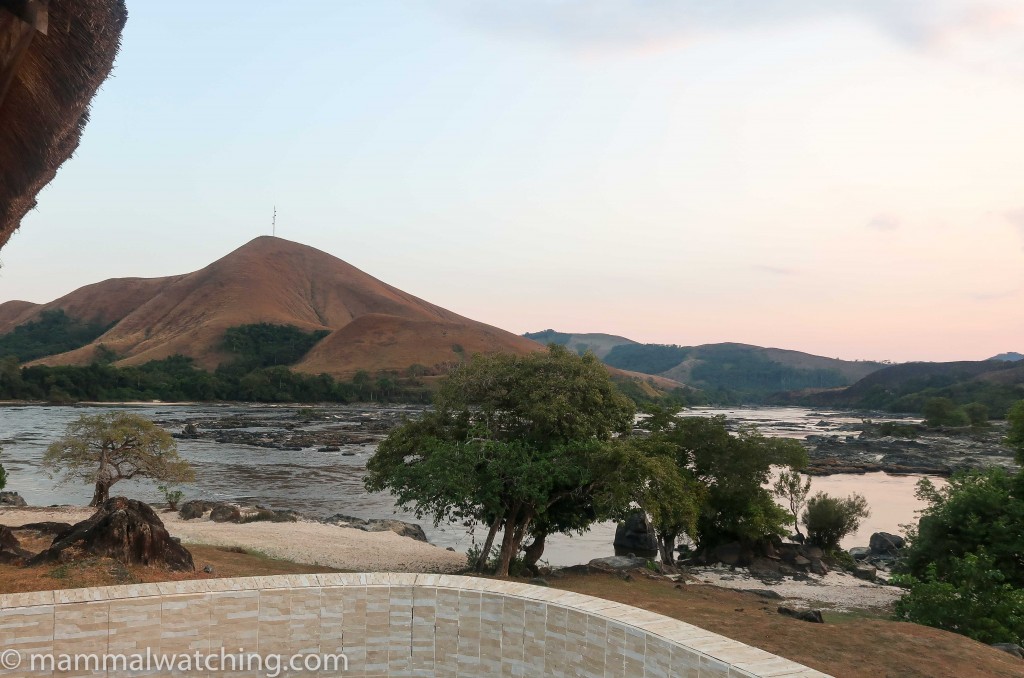
The view from the pool at the Lope Hotel.
We spent 4 days here based at the Lope Hotel. The hotel is comfortable. There’s a pool overlooking the river and nice rooms in small cottages scattered across the property (complete with dwarf epauletted bats in residence). The food in the restaurant was largely OK (at least the spaghetti bolognese was which I lived off), though would often take hours to arrive and then would often not be what had been ordered. The electricity was usually only turned on between 6pm – 8am. There was no WiFi but good cell service.
Game drives are in open backed hotel Landcruisers. When all 10 of us – plus guides – were in just one vehicle it was a bit of a squash but manageable. We’d been led to believe that we’d largely be restricted to daytime drives but – perhaps because of Vianet’s charm and connections – we were able to stay out until well after dark.
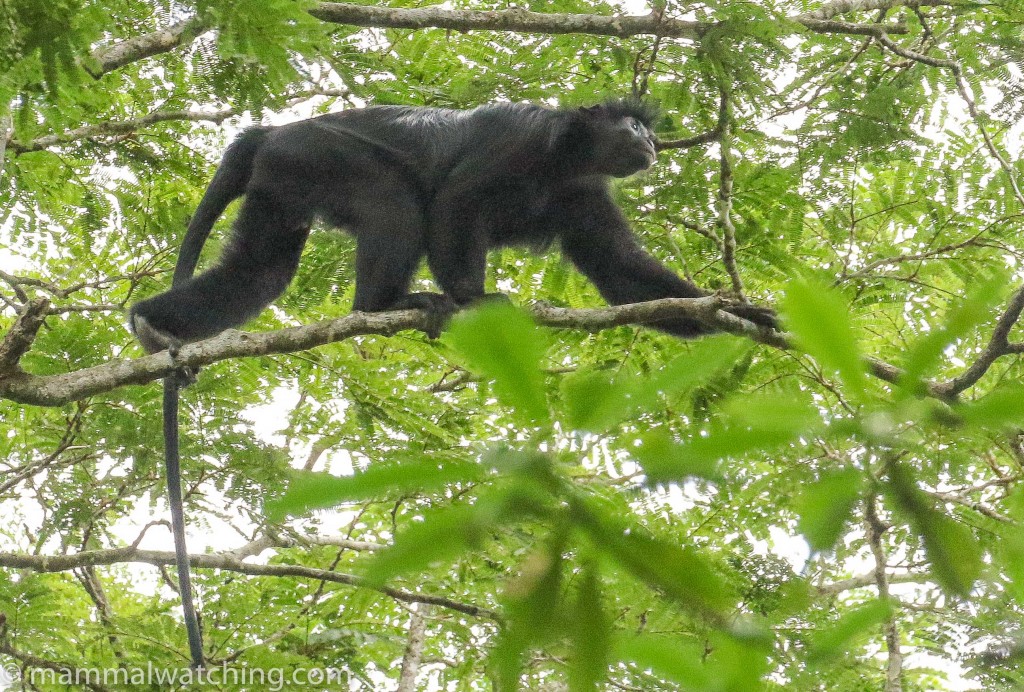
Black Colobus, Colobus satanas
The landscape here is a mix of savannah and fragments of dense gallery forest and so there is a good diversity of species. It is the place to see Mandrills and more.
Mikongo Research Camp
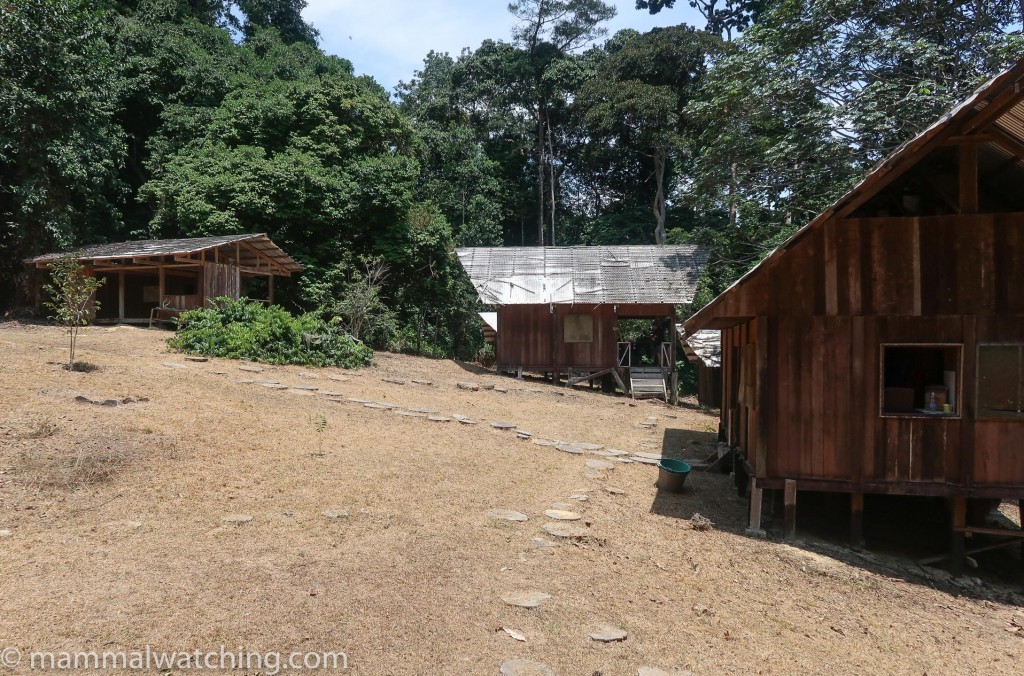
Mikongo Camp
The disused Mikongo Research Camp is in the south of Lope National Park about 2 hours’ drive from the Lope Hotel. The camp is basic. There’s no power, no running water, no bathrooms and no cell service. The one toilet is an open pit on the edge of a clearing. Not really the sort of loo to relax with a book. There are a number of wooden rooms on platforms around the clearing. We slept in them, inside tents on mattresses.
The camp staff cooked basic food and we washed in the river. Although there is some excellent mammalwatching around the camp itself it is important to have a vehicle here, both in case of emergency and to drive the 10km back to the main road (I use the term “main road” loosely): back on the road you can look for the highly localised Sun-tailed Guenons which apparently do not occur near camp. Black Colobus, Gorillas, Chimps and much more are fairly common here too.
Pongara National Park
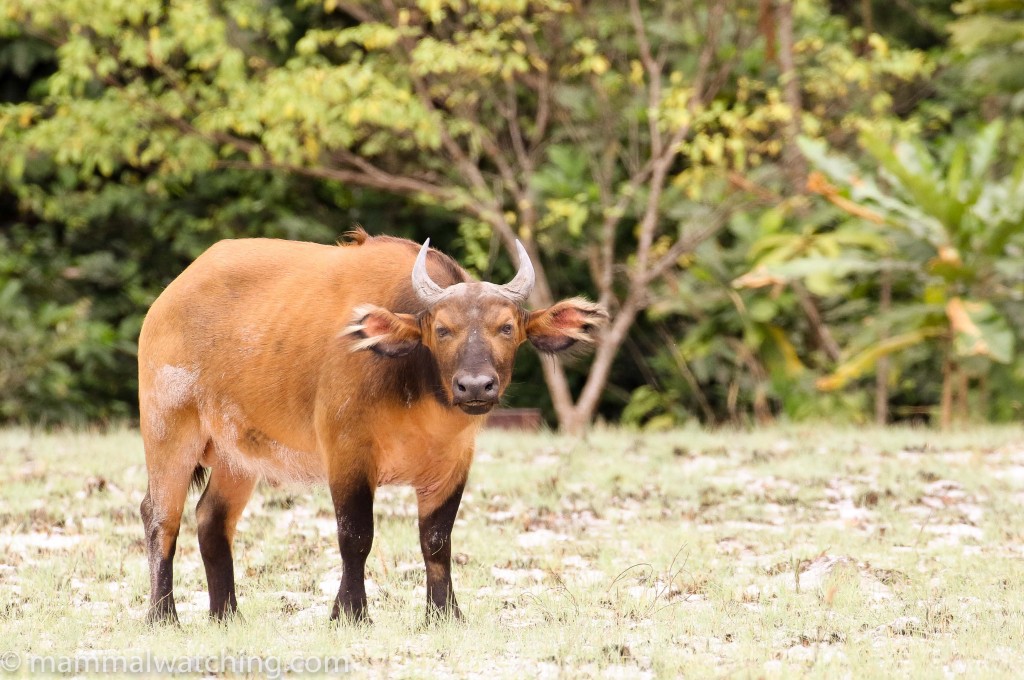
African (Forest) Buffalo, Syncerus caffer
Pongara Point is just across the Gabon Estuary from Libreville: a 30 minute boat ride from the city. The park is supposed to be home to a lot of nice mammals but access is difficult. We spent a free day at start of our trip at the very fancy hotel resort here, having a good lunch and taking a (very expensive) 4WD tour into the park for an hour. This was largely because we couldn’t find anything else to do after the whale watching boat we wanted broke down. The hotel is pleasant for sure, and there was a small chance of running into Atlantic Humpback Dolphins on the boat ride to and from Libreville. But in retrospect it would have been better to have spent our time at Akanda National Park.
Tsam Tsam Lodge
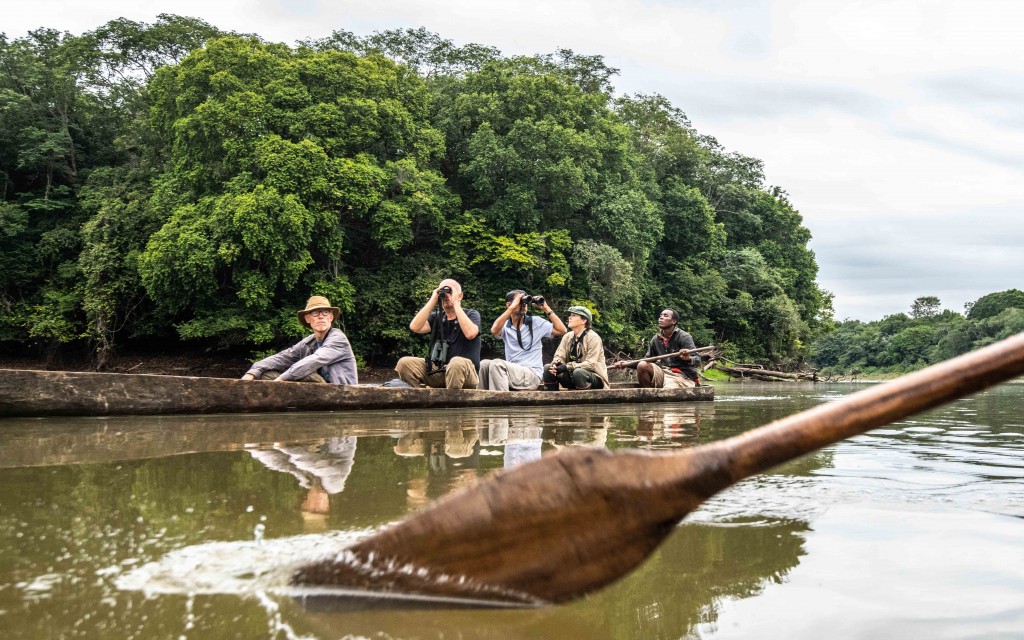
Mammalwatching from the pirogues. Photo Charles Hood
Tsam Tsam is a simple but lovely lodge on a small island in the middle of the Lake Oguemoué ecosystem, a 2 hour speedboat ride from the town of Lambarene. The lodge, run by an American woman and her Gabonese partner, is an integral part of a community run ecotourism project working to help the local community and protect the wildlife. Although Tsam Tsam has no power, running water or cell service it was the nicest accommodation of the trip and we slept in comfortable tents set on platforms overlooking the lake. The food was excellent. It would have been even better if I liked fish! But it is fair to say that the place is more of an eco-getaway than a hard core wildlife watching destination. There were no well-marked trails and it took some negotiation before we were allowed to take night walks. This is partly because few people have ever wanted to walk at night I suspect, and partly because of the risk of running into an Elephant. This is a genuine risk, though lower here than at Lope or Mikongo I think.
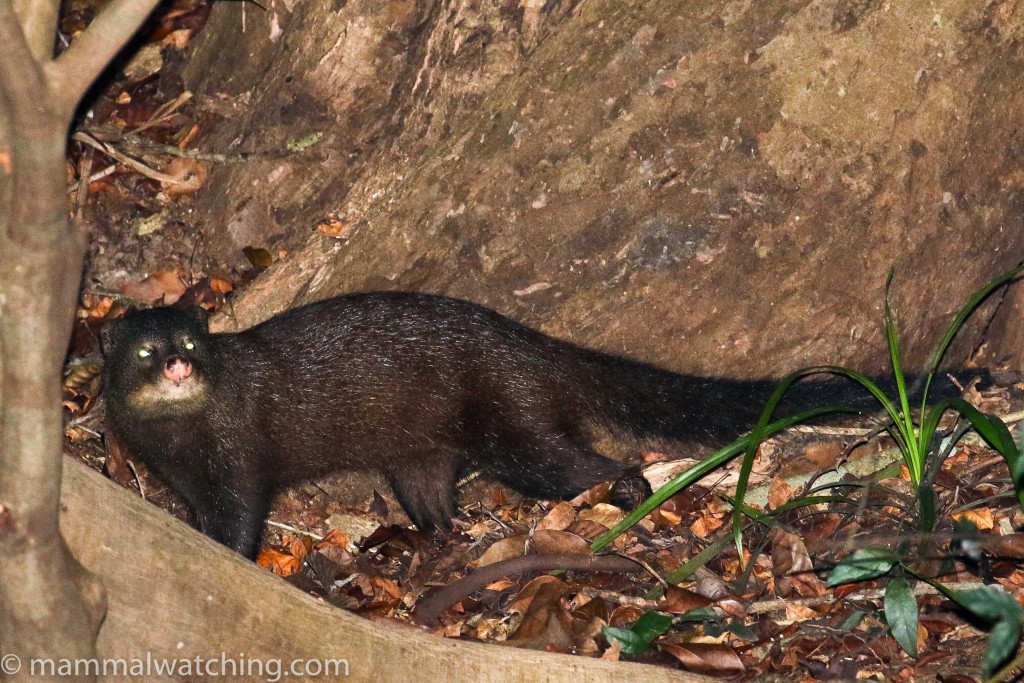
Marsh Mongoose, Atilax paludinosus
There seems to be some hunting pressure in the area too (so all the more reason for an eco-project) and we heard several gunshots ringing out across the water. That said, when we did take a guided night walk here we saw very little, until we ran into a Giant Pangolin! Spotlighting trips from the speedboat were more successful and Marsh Mongoose seem reliable here. The key species for us were Red-capped Mangabeys which do not occur in Lope or Mikongo. There’s also a chance – though not a big one – for African Manatees.
Other Possible Destinations
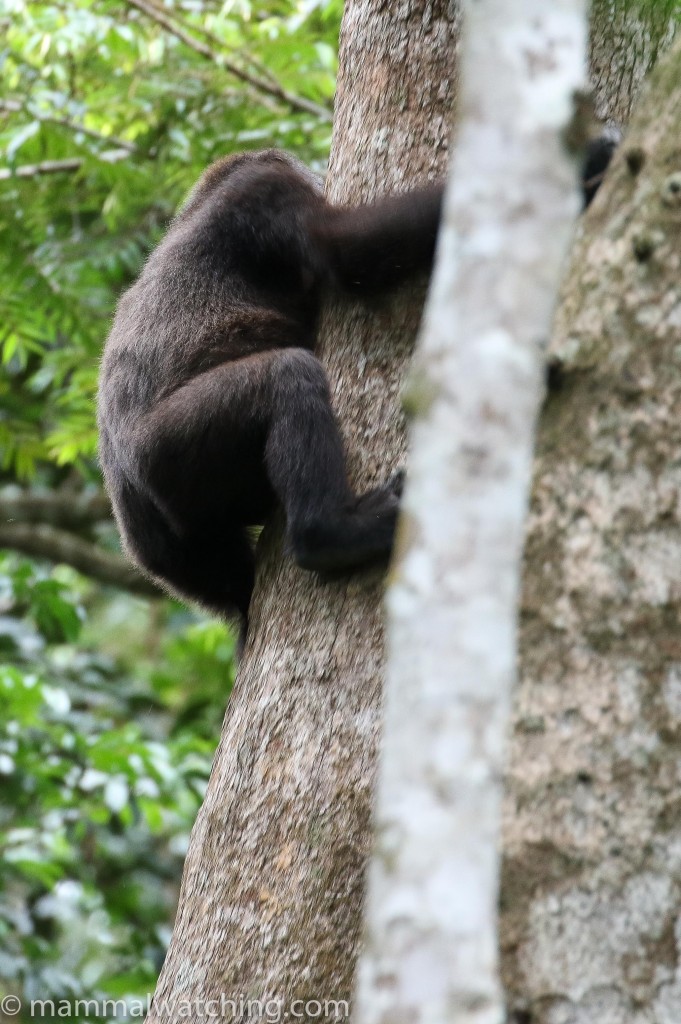
Western Lowland Gorilla, Gorilla gorilla. Lope National Park.
I considered visiting three other sites, the only three places I could get much information on.
Ivindo National Park’s highlight is Langoue Baï, a forest clearing, frequented by Gorillas and Red River Hogs amongst other species. I didn’t include this on the itinerary because it was expensive, time consuming to get to and I understood that we would not be able to look for things at night, other than very close to the lodge. Mogens Trolle’s report covers this spot. Though we would likely have had stellar views of Red River Hogs here, I am not sure we would have seen any more than we saw at other sites. One road into Ivindo used to be a relatively reliable place to see African Golden Cats. When I say reliable I know of 2 people who saw them there. But that road has long since closed.
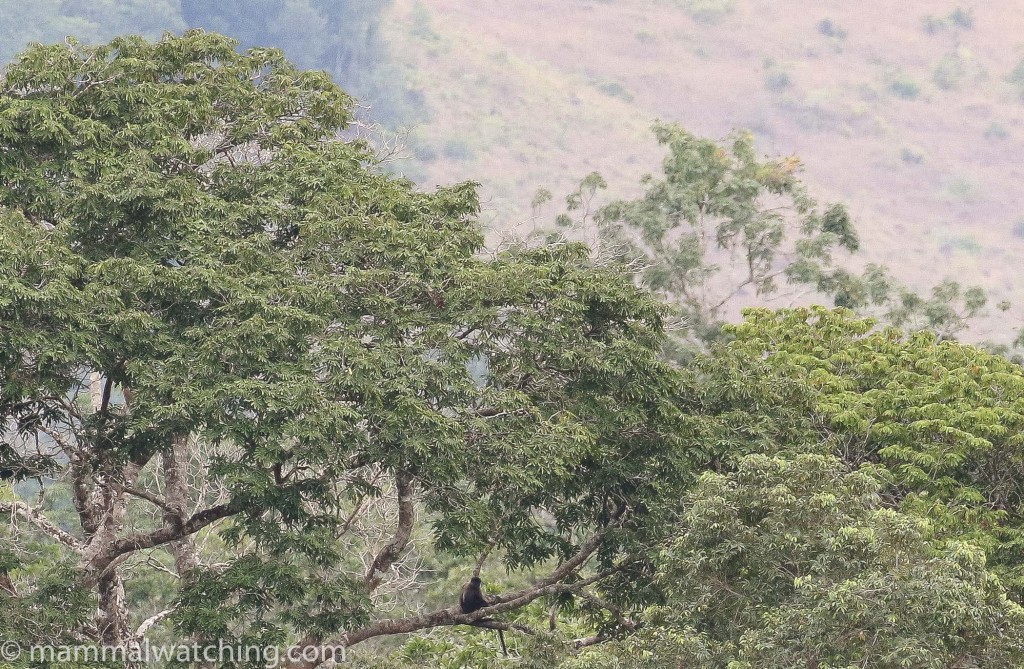
Grey-cheeked Mangabey, Lophocebus albigena. Lope National Park.
Lekedi Park is also covered in Mogen’s report. If you want to get up close and personal with the Mandrills then this is one place to do it. A colony of animals was reintroduced here and are apparently habituated. I haven’t been but am not sure that they would count as wild if you are a purist. You can – we were told – “feed them bananas”.
Loango National Park is on the coast south of Libreville. It sounds like a great park, with a lot of wildlife that is well protected: this is where Hippos famously come onto the beach and enjoy the ocean surf. Again I am not sure we would have seen anything different here and it sounded like quite expensive a destination, though certainly somewhere to consider visiting.
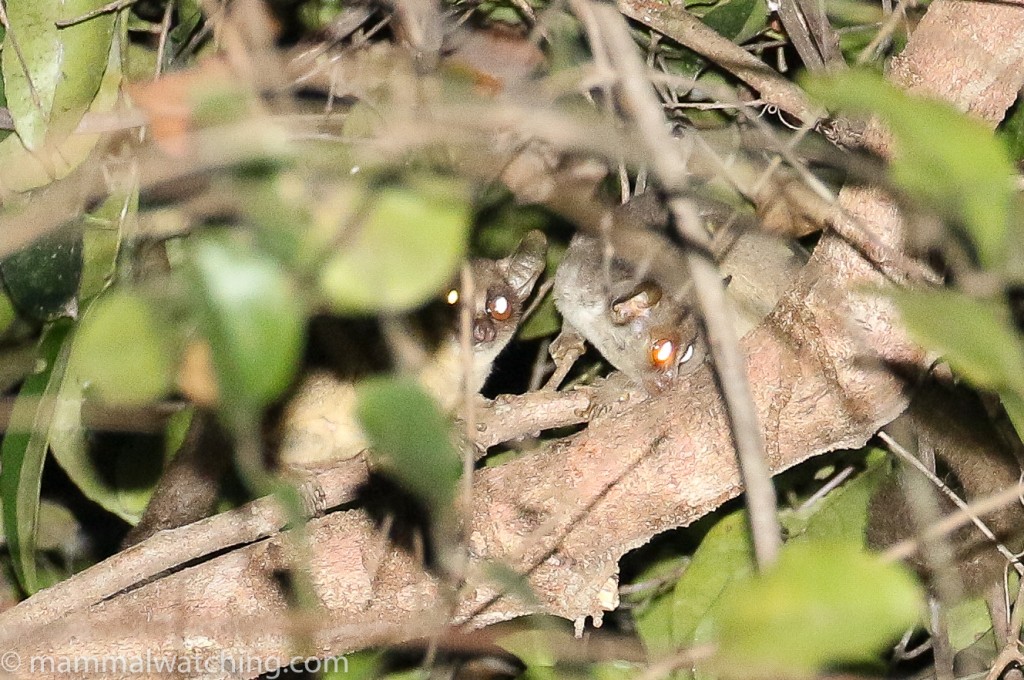
Makandé Squirrel Galagos, Sciurocheirus makandensis. Lope National Park.
The Trip Report
Saturday 11 August – Libreville
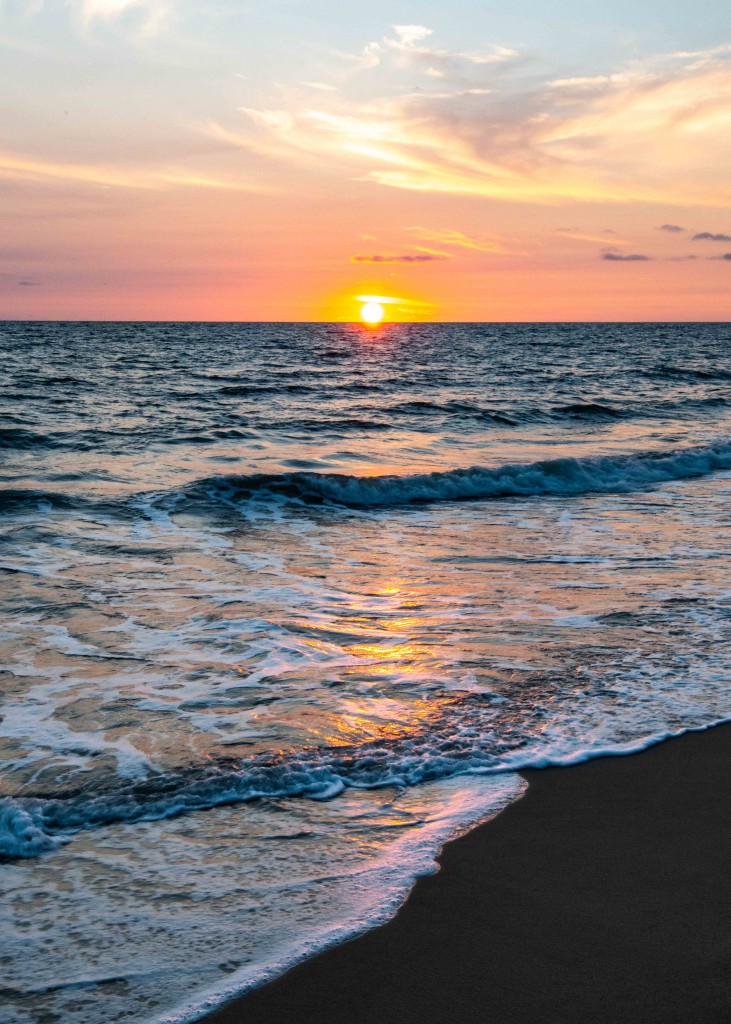
Hotel Tropicana beachfront. Photo Charles Hood.
Most of us arrived into Libreville airport early Saturday evening. Our authorisations for travel documents worked OK, though it took a good hour for the person on duty to stamp our passports. We spent the night at the Tropicana Hotel on the beach. A nice location, decent food and cold beer and mediocre rooms.
Sunday 12 August – Point Pongara
We weren’t leaving Libreville until Monday night so naturally wanted to spend our first day looking for wildlife. But options around Libreville were quite limited according to Guillermo. After considerable discussion we had left it very late to take a decision. One possibility was the Raponda Walker Forest, close to Libreville. But Guillermo didn’t rate our chances for seeing anything there. So we decided to try chartering a boat for the day to go whale watching. Humpback’s aside, there are some interesting cetaceans in these waters including Atlantic Hump-backed Dolphins, Clymene Dolphins and Bryde’s Whales. But, by this stage it was impossible to find a boat that was available, affordable and not broken down: one guy wanted 2500 euros for a day trip for the 9 of us.
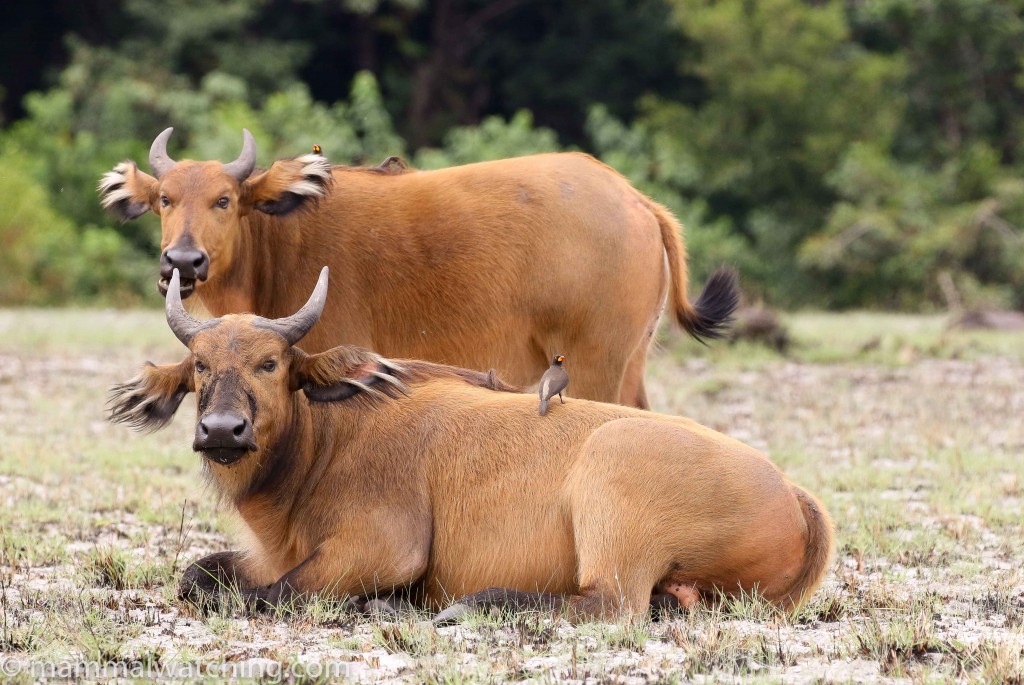
African (Forest) Buffalo, Syncerus caffer
And so at the very last minute we arranged a day trip to Point Pongara, a fancy hotel resort, across the estuary from Libreville on the edge of Pongara National Park. The 30 minute boat ride did not produce any dolphins, though they are sometimes near the point we were told. An hour’s game drive in the park (250 euros an hour per vehicle!) got us close to several groups of Forest Buffalo. And a few of us saw a lone Moustached Monkey cross the road. Lunch at the hotel was good.
It was a nice enough day but had we known about Akanda National Park (which we visited on our last morning) we would have gone there instead.
Monday 13 August – Libreville to Lope National Park
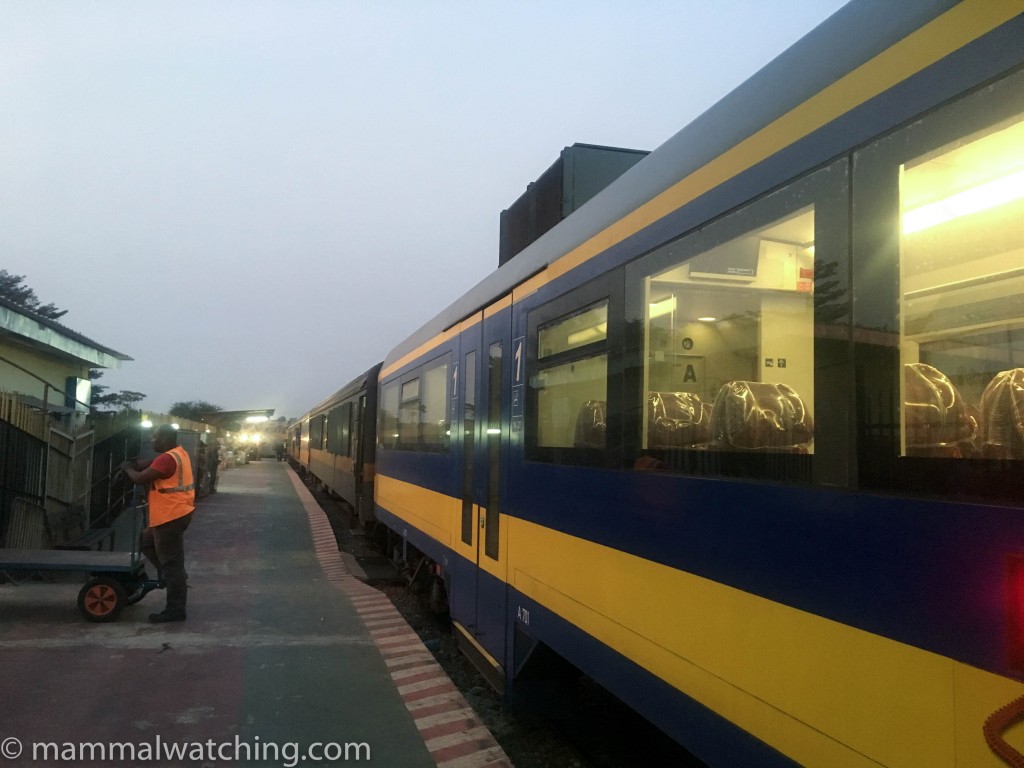
Night train to Lope.
Most of us spent the morning and early afternoon in and around the Tropicana Hotel before heading to Libreville Train Station (far earlier than needed) to catch the night train to Lope National Park. According to the timetable, trains run from Libreville to Lope each night and take about 5 hours. In reality… trains leave some nights and are often (always?) late. Some don’t leave at all. Guillermo explained that there were two types of train. The “good train” which leaves on Monday (and presumably some other nights) – while problematic – is more reliable than the … “bad train” I guess.
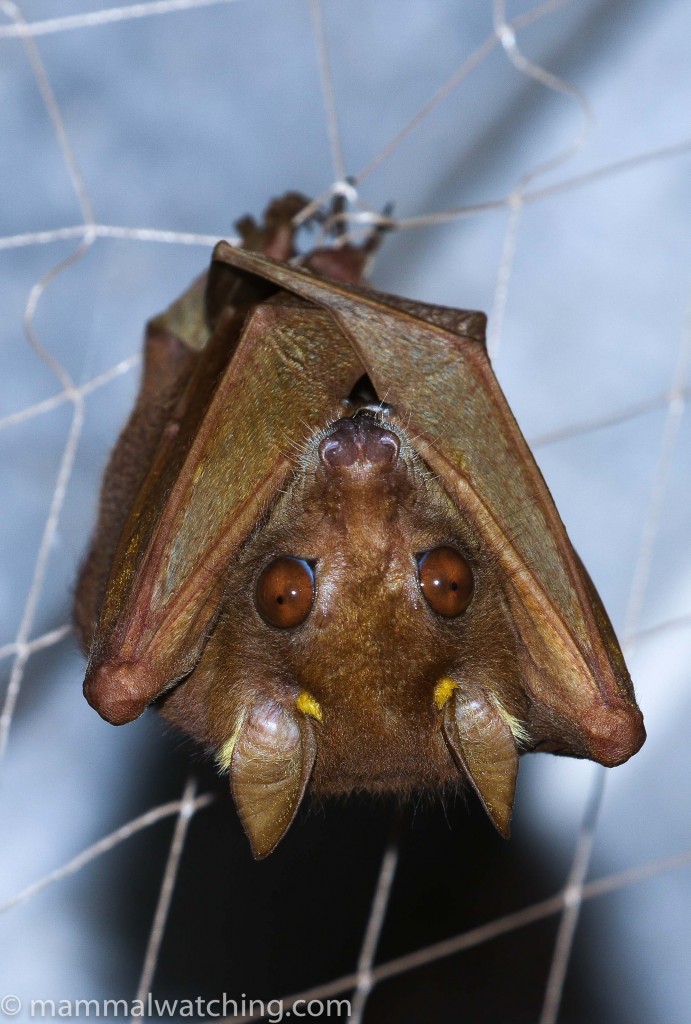
Peters’ Dwarf Epauletted Fruit Bat, Micropteropus pusillus
Our train was supposed to leave around 7 p.m. but eventually left at 9 p.m. The train itself was comfortable: reclining seats, power outlets and (powerful) AC. It should have taken five hours to reach Lope. But the actual journey, involving many mysterious stops in the middle of nowhere, took closer to seven hours. This, when coupled with our late departure, meant it wasn’t until 5 a.m. that we were standing in the lobby of the Lope Hotel looking up at the Peters’ Dwarf Epauletted Fruit Bats hanging from the ceiling and wondering how we were going to get up at 7 a.m.
Tuesday August 14 – Thursday August 16: Lope National Park
Life at the Lope Hotel is largely spent taking morning and afternoon-into-evening game drives. The rest of the time is spent waiting in the restaurant for your food to arrive, realising it isn’t what you are ordered, and trying again.
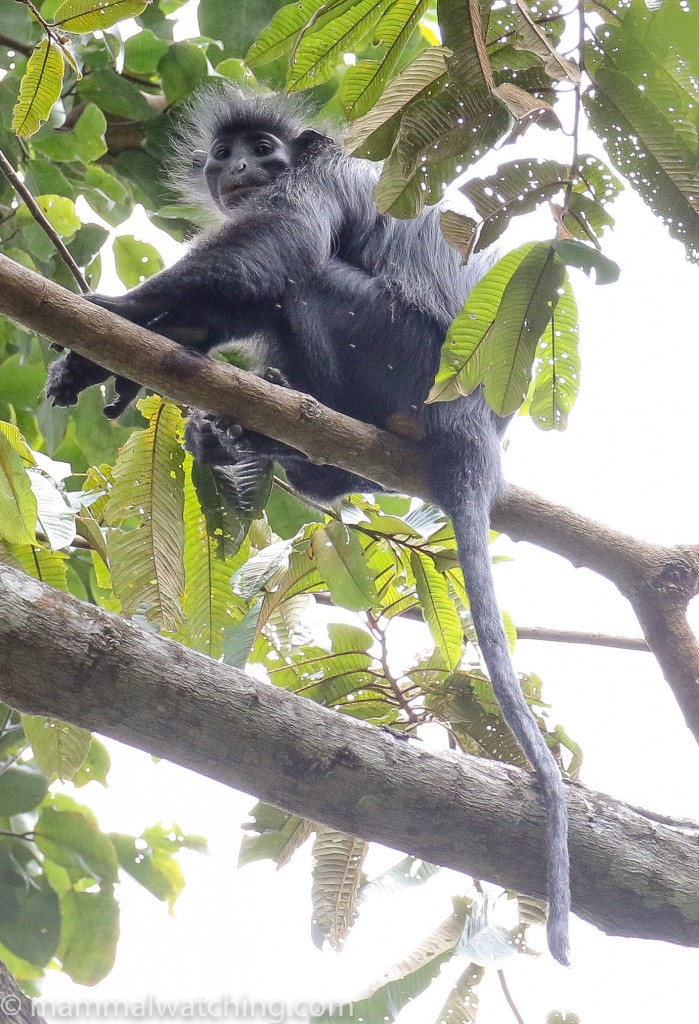
Black Colobus, Colobus satanas
We had exclusive use of one of the hotel’s open safari vehicles, along with a friendly driver and local guide. In theory game drives are run at 8 a.m. til late morning, and at 4 p.m. until dusk. But we seemed to have carte blanche in coming and going as we pleased. We spent the mornings driving to the forest and then exploring it on foot. We would spend more time in the vehicle in the afternoons and evenings, returning well after dark. The driver and park guide seemed to thoroughly enjoy being out at night and seemed genuinely fascinated to look at all the bats, rats and anomalures we were spotting. One park official was less than impressed with our late return one evening. But as he was drunk and waving around a picture of a naked woman on his cell phone it was hard to take his yelling seriously. But if looks could kill we would all be long since dead from the reception we’d receive walking into the hotel restaurant at 10 p.m. looking for dinner. But, with gritted teeth, they fed us.
Mandrill Watching
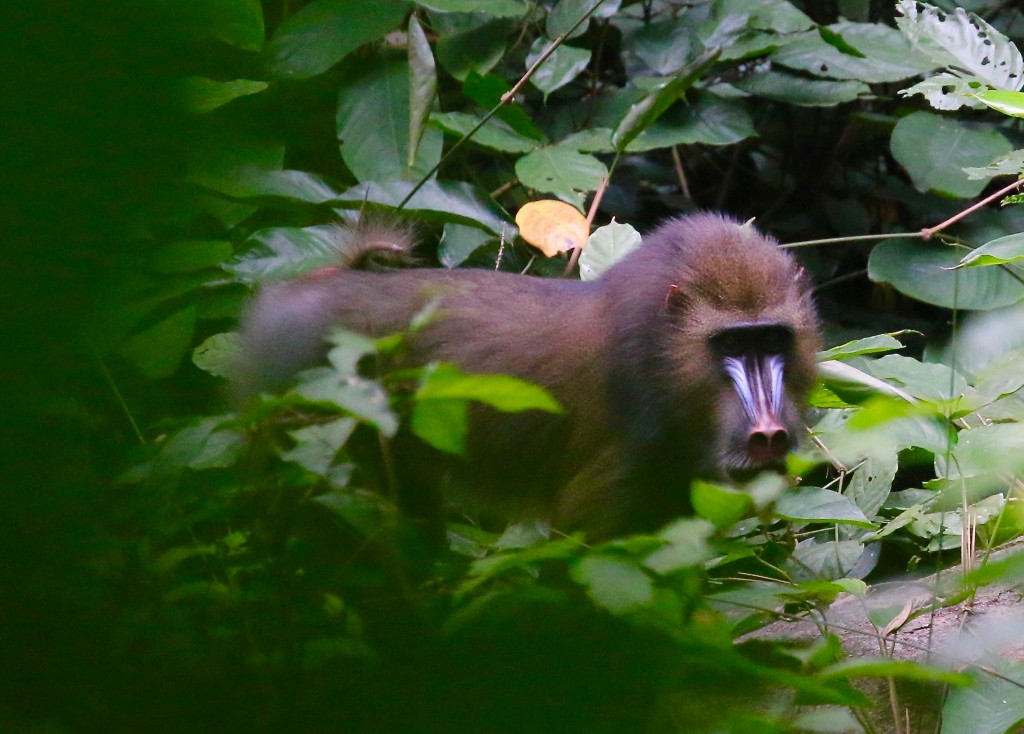
Mandrill, Mandrillus sphinx. Photo Sjef Ollers.
For many the key reason to visit Lope is to spend time with wild Mandrills. David Lehmann, a French researcher, has been working with the monkeys for a couple of years, and has several females wearing radio collars and GPS tags. These females are a part of a troop of 1,000 animals. Yes, 1000! David offers visitors the chance to go out with him to see the Mandrills. This is quite expensive: he charged us 250 euros a person, and that price was double what it had been a month earlier. But it was money very well spent in my opinion: the experience was fabulous. He took us in small groups of 3 or 4 each morning. The proceeds help fund his research project.
David Lehmann
After two years the animals are semi-habituated. It is extremely likely you would see them during a morning with David, but each day was very different for us. David picked up my group from the hotel on the first morning at 8.30am. By 10 a.m. he had tracked down the animals and we could hear them from the road side. Five minutes later we were in fairly open forest surrounded by a parade of Mandrills. Fantastic stuff!
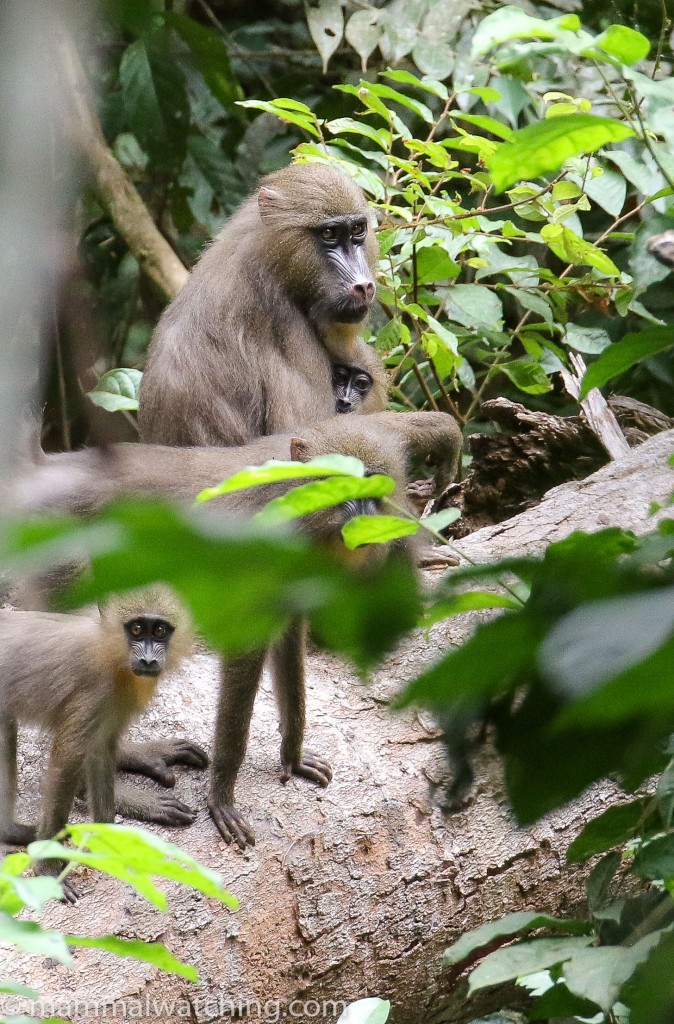
Mandrill, Mandrillus sphinx
The main troop is 1,000 strong , but a pair of Leopards had recently arrived in Lope and were hunting the Mandrills: this may be why the troop had split in two. So we were likely in amongst just 600 animals. They were everywhere, moving slowly along the ground through the forest, feeding and interacting. But always moving: photographic opportunities were not so easy.
We saw and heard several large breeding males in the group. Their loud calls carry through the forest and their technicolour bums literally glow in the shadows as if they carry their own light source. The animals seemed cautious in our presence, but not scared. A youngster came to within 4 metres of us.
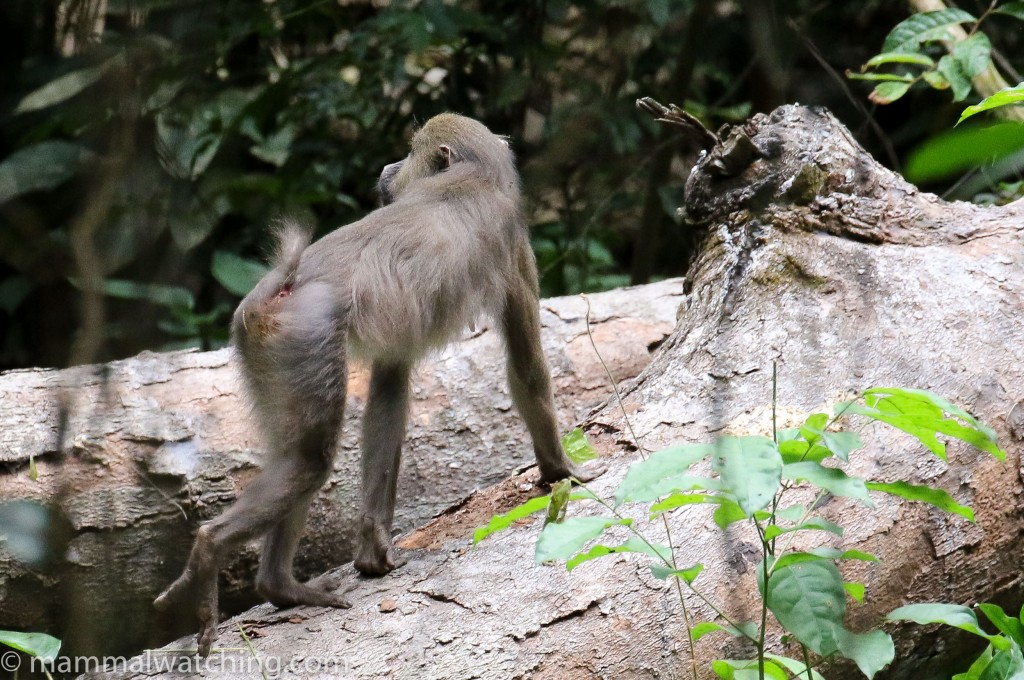
Mandrill, Mandrillus sphinx
After an hour with the Mandrills we needed to leave when David felt they were changing their behaviour to avoid us. On the way out we came far too close to a Forest Elephant – incredible how those things can just materialize metres away – which led to a very hasty retreat. Charging elephants are a very real risk here and David encounters them often. That, I imagine, is why we all needed travel insurance and – for the over 60s – a fitness certificate to take part in the activity.
The other groups had different experiences. One group found the Mandrills almost as easily as us, but the animals were spooked by the alarm calls of a Putty-nosed Monkey and so were much less relaxed. On the upside they got a great look at a Yellow-bellied Duiker in among the Mandrills. The other group had to walk for a couple of hours before they reached the monkeys.
Red River Hogs and Giant Pangolin Tracking
David is also working to expand his portfolio of mammalwatching experiences. A few weeks before we arrived he collared a Red River Hog (more of a harness really) and seems to be the first person ever to have done so. Three of us were the first group of tourists to try to track them down. This was much more difficult than seeing the Mandrills. The pigs were in fairly dense forest patches and were skittish. Although we got close to a sounder of hogs several times they were always a few steps ahead of us. Four people inevitably make a lot of noise walking through that forest. We eventually saw the collared animal out in the open, but she appeared to be sick – though not because of the collar – and so David decided to put a halt on the hog tracking for the time being.
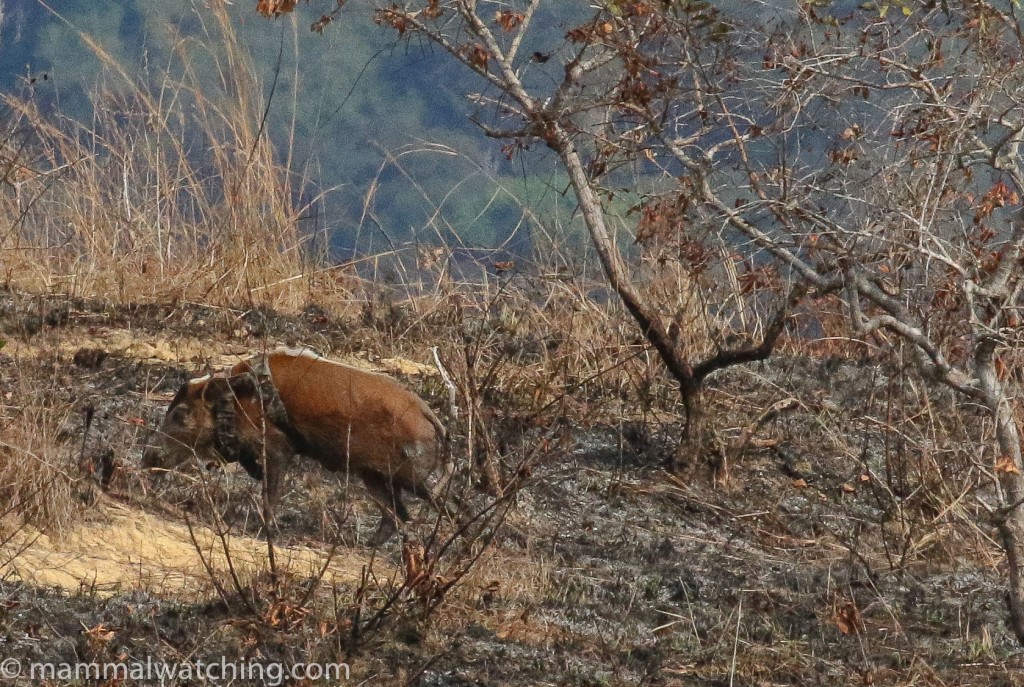
Red River Hog, Potamochoerus porcus
Hopefully he will continue to perfect this program and develop a strategy for better viewing opportunities. Red River Hogs are not uncommon in Lope but are hard to see and we were fortunate to watch a group out in the open the following day. Langoue Bai in Ivindo National Park seems a much more reliable spot for these animals.
Even more exciting are David’s plans to collar a Giant Pangolin (doubtless another world’s first). He had found an active burrow and was determined to try to collar an animal before the end of 2018 and then offer people the chance to see it at night. Given elephant numbers it would require some pretty careful management, but David was optimistic it would work.
If you are planning to go to Lope then it is very important to check that David is available and you can email the project here. I am not sure anyone else would be able to offer these activities.
Mammal List for Lope
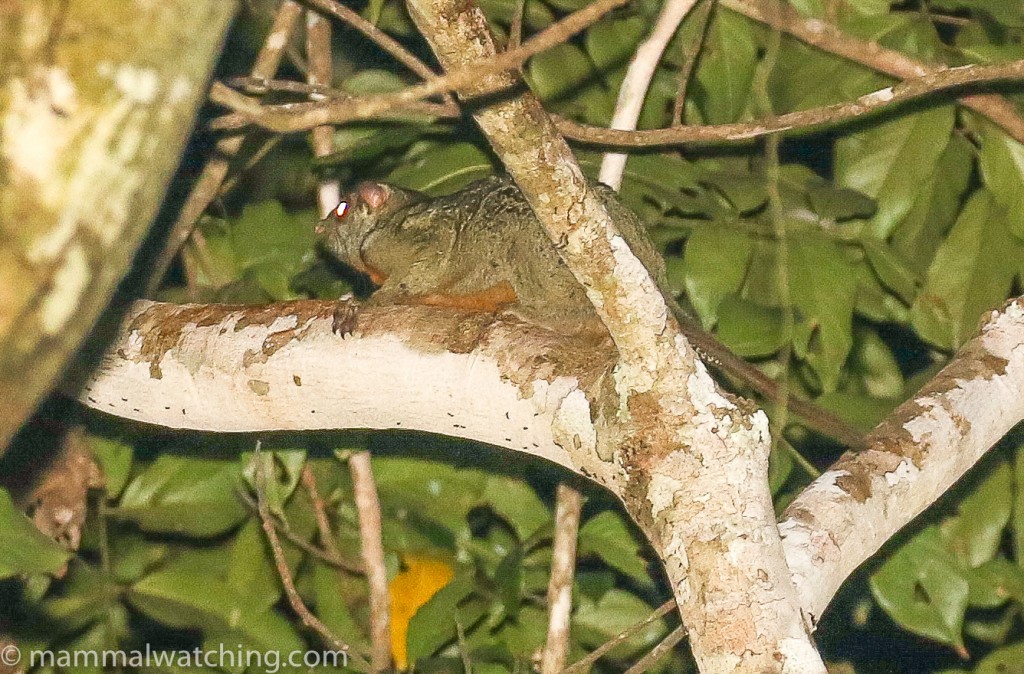
Beecroft’s Anomalure, Anomalurus beecrofti
Over the course of three days and nights some or all of the group encountered the following mammals. More details are in the annotated mammal list later in the report. Mandrill, Moustached Monkey, Putty nosed monkey, Grey-cheeked Mangabey, Chimpanzee, Lowland Gorilla, Makandé Squirrel Galago, Blue Duiker, Bay Duiker, Peter’s Duiker, Ogilby’s Duiker, Yellow-backed Duiker,
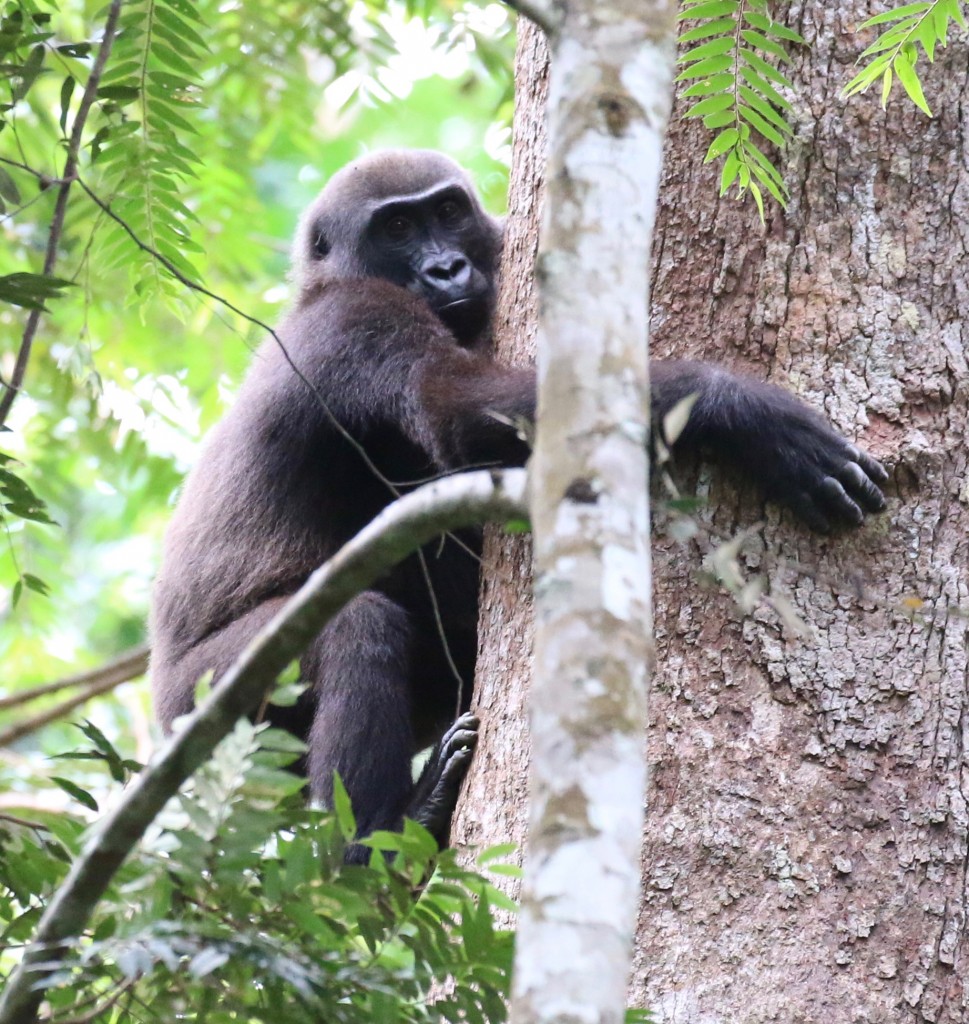
Western Lowland Gorilla, Gorilla gorilla. Photo Sjef Ollers.
Red River Hog, Western Bushbuck, Forest Elephant, Forest Buffalo, Leopard, Blotched Genet, Servaline Genet, Marsh Mongoose, African Palm Civet, Green Squirrel, Western Palm Squirrel, Striated Grass Mouse, Lorraine Dormouse,
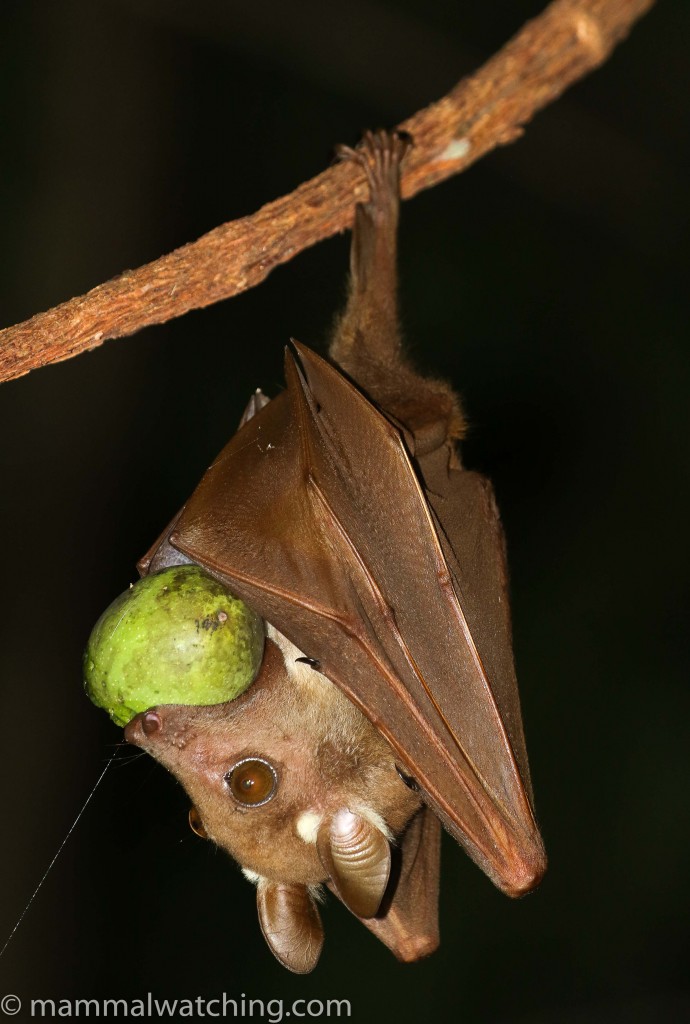
Franquet’s Epauletted Fruit Bat, Epomops franqueti
Beecroft’s Anomalure, Hammer Bat, Franquet’s Fruit Bat, Peter’s Dwarf Epauletted Fruit Bat, Slit-faced Bat species, Benito Roundleaf Bat, and Cyclops Roundleaf Bat. When we returned to Lope – later in the trip – we added Greater Cane Rat, Demidoff’s Galago and Egyptian Rousette to the list.
Friday August 17: transfer to Mikongo Research Camp
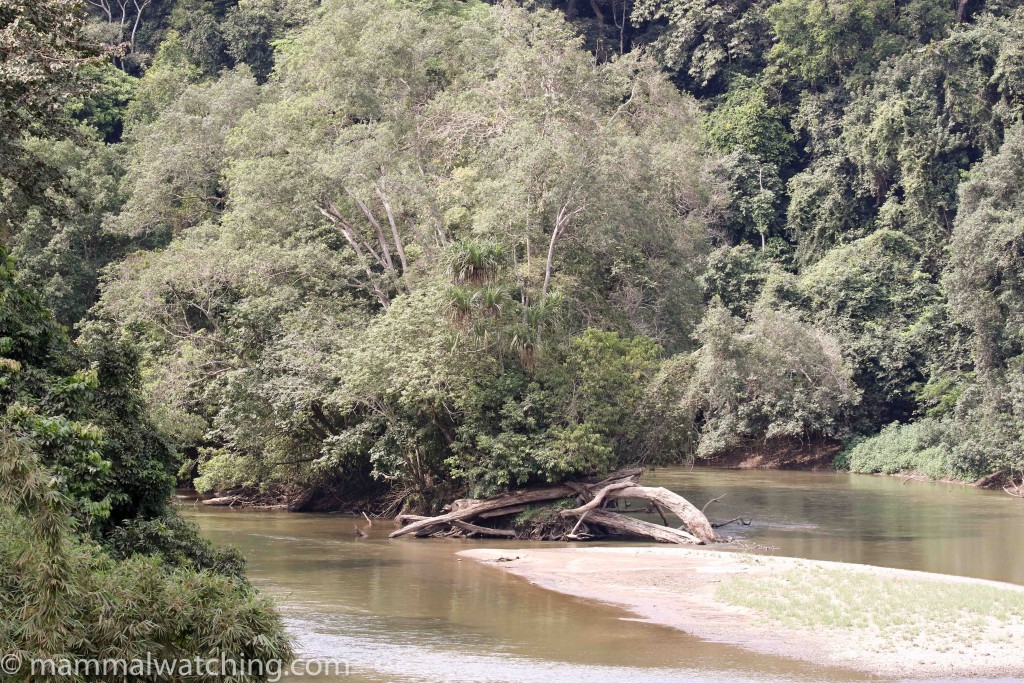
The river at Mikongo Camp: Water Chevrotain habitat
Today was a very African Day. Our itinerary had us leaving the Lope Hotel for the two hour transfer to Mikongo at 9 a.m. But today – we discovered – was Gabonese Independence Day and a national holiday. The chances of vehicles arriving at 9 a.m. were slim to non-existent so Vianet rescheduled our departure to 1 p.m. This meant a very welcome extra few hours in bed for me.
The vehicles didn’t arrive at 1 p.m. But then again nor had lunch. By 3 p.m. the last of the lunch, and the first of the vehicles, arrived: an ancient Landcruiser Troopy, loaded down with bags of water and food for our trip to Mikongo. Half of us climbed in to the car as the other car was “just behind”. We arranged to rendezvous with the other vehicle, the rest of our group and our bags, at the little shop in town where we could stock up on batteries, chocolates and beer.
Two hours later there was no sign of the other vehicle and – after a couple of phone calls – we found out why. The car had arrived with 7 people inside, all determined to get a ride to Mikongo. Cue argument. The driver decided to leave all our luggage at the hotel, and prioritise the passengers of our stuff. But even this was no solution: the hopelessly overladen car ground to a halt before it had left the hotel driveway.
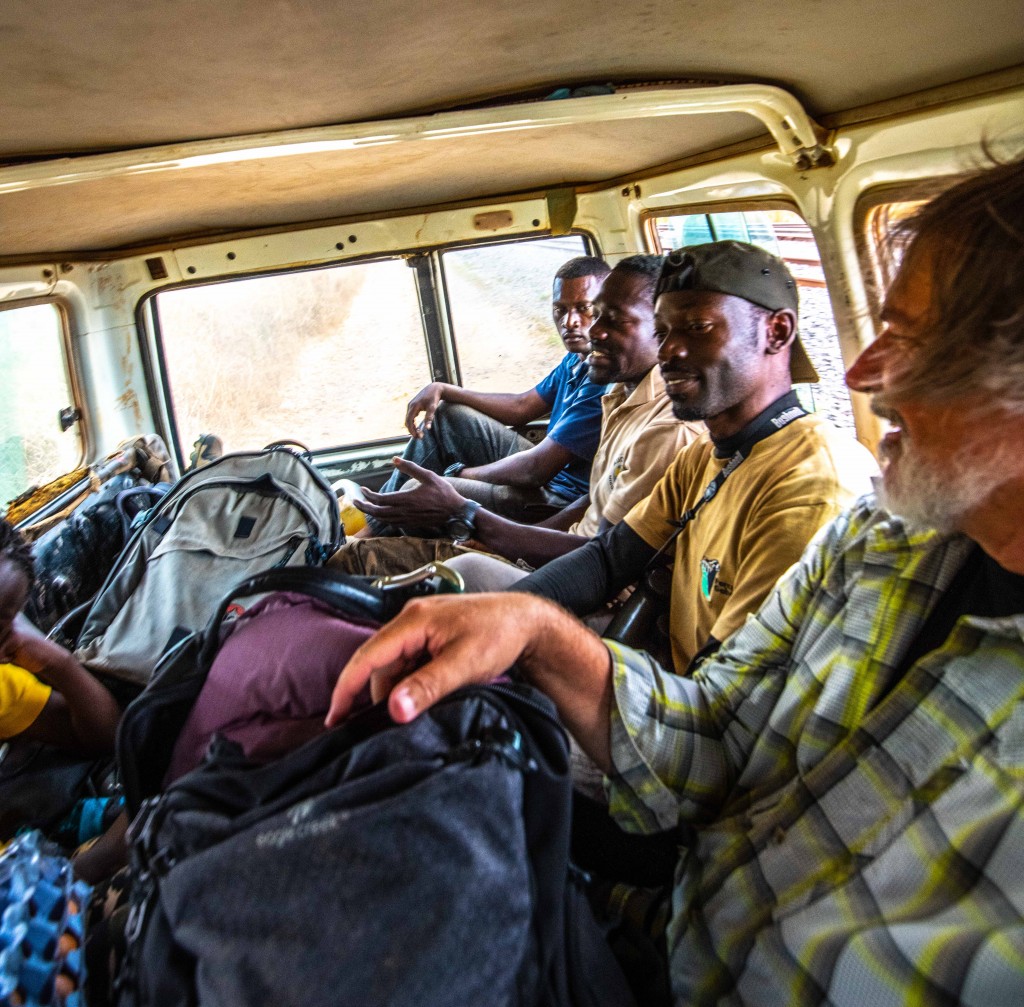
Two cars full of people. One car full of luggage. One car full of food…. Two cars. Photo Charles Hood.
After an hour of heated discussion all but one of the surprise passengers had been removed, our luggage was back in the car and most of the food had been left at the hotel to be collected later. The one remaining hitchhiker was possibly the oldest woman in Gabon. She was most certainly the loudest. She announced she was the Chief of Mikongo Village and was going home. When our ears stopped ringing we explained there was no space. She held fast. We eventually removed her cooking pot from our vehicle – with her attached to it – while muttering our apologies in broken French. Seconds later she had materialised in the back of the other car, smiling from behind her pot. Tenacious doesn’t come close. We gave up protesting (well the other vehicle gave up – we were much less tolerant) and so they endured a little additional discomfort for the two hour drive to Mikongo. But it was never going to be a pleasant drive in any case.
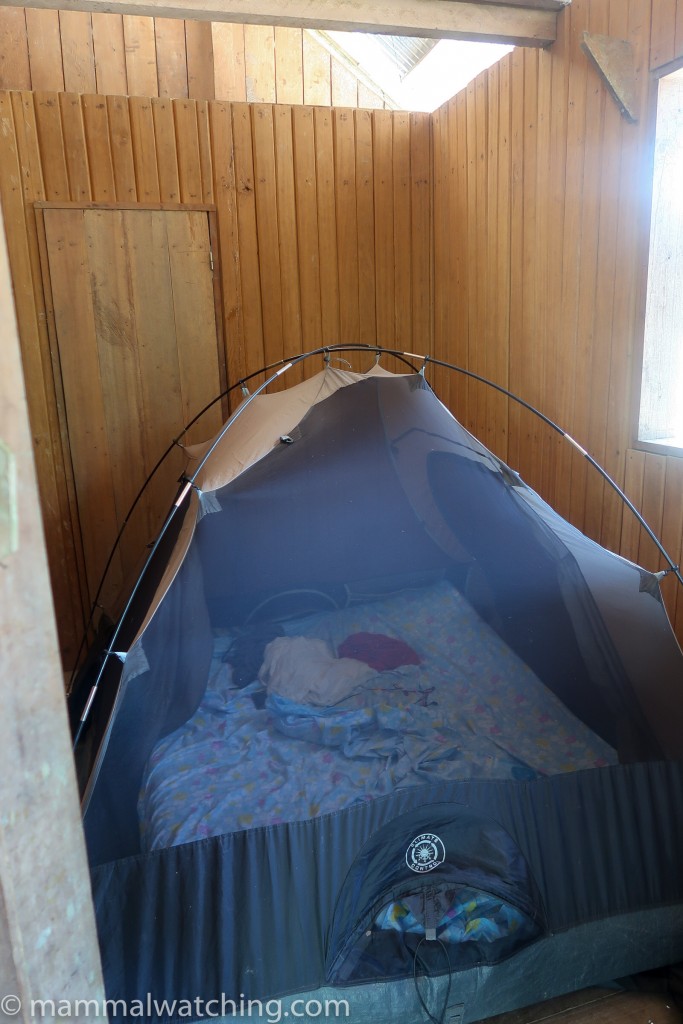
Mikongo accommodation
We got into camp at 9 p.m. The camp were expecting us. Nothing had been prepared. So we spent another 90 minutes looking for tents and mattresses and trying to figure out which huts we would sleep in. Vianet and Ghislain had it all under control but were too polite to tell the mammalwatchers to stop interfering: each of us had a better plan than the next on how it ought to work. And then it was time for rice, tinned carrots and warm beer. The mammals would have to wait for the morning.
Saturday August 18 – Monday August 20: Mikongo Camp
We had three full days and nights at Mikongo. We spent our first morning on a longish walk through the forest in front of camp. The highlights were my first decent look at a Bay Duiker plus a wonderful encounter with a Western Palm Squirrel: a fabulous animal!
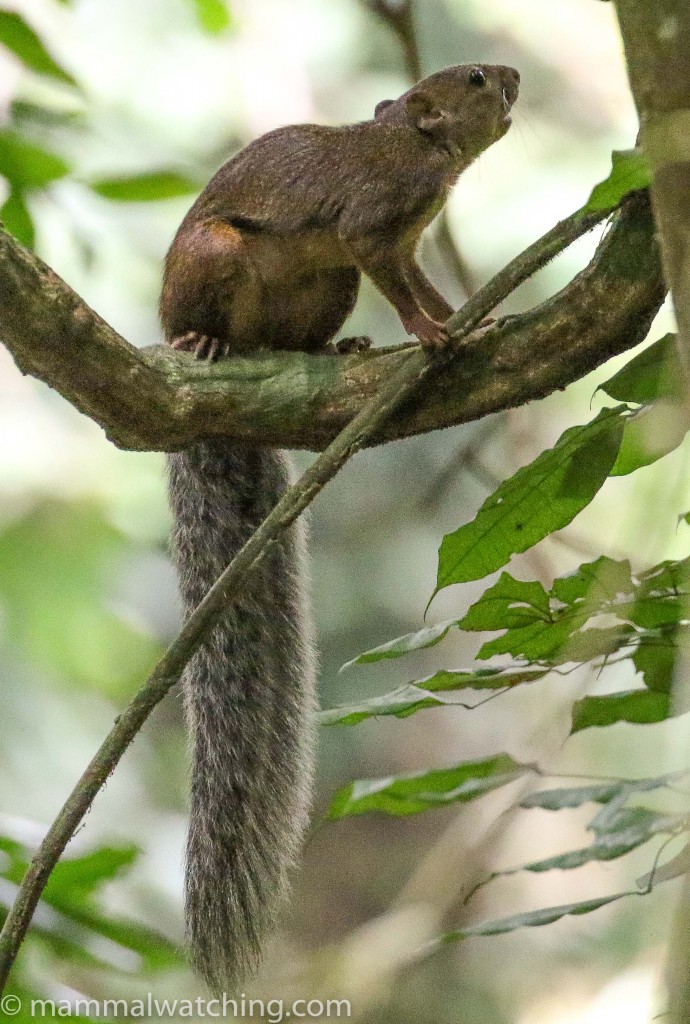
Western Palm Squirrel, Epixerus ebii wilsoni
We spent most of the other days at Mikongo looking along the road for the highly localised Sun-tailed Guenons. Although they don’t seem to occur at Mikongo Camp, they are seen regularly around the villages and along the “main” road south. We tried looking for them on foot several times. They are a shy species, that stays close to the ground and will typically descend to the forest floor when startled. Looking in a group, off trail, is hopeless unless you are able to make a lot less noise than we were. And we were pretty quiet. A better plan might be to follow the wide trail around an electric fence that had just been erected at Mikongo Village. But we gave up on that strategy after we heard that the guenons hadn’t been seen for the past few days, which coincided with when the village had started chain-sawing trees.
So I figured we should look for them from our car along the road. This was by far the least comfortable strategy but also the most successful. Using this tactic we saw three or four groups of guenons in an hour or two. By rotating people through the front seats of the truck we all ended up having good views.
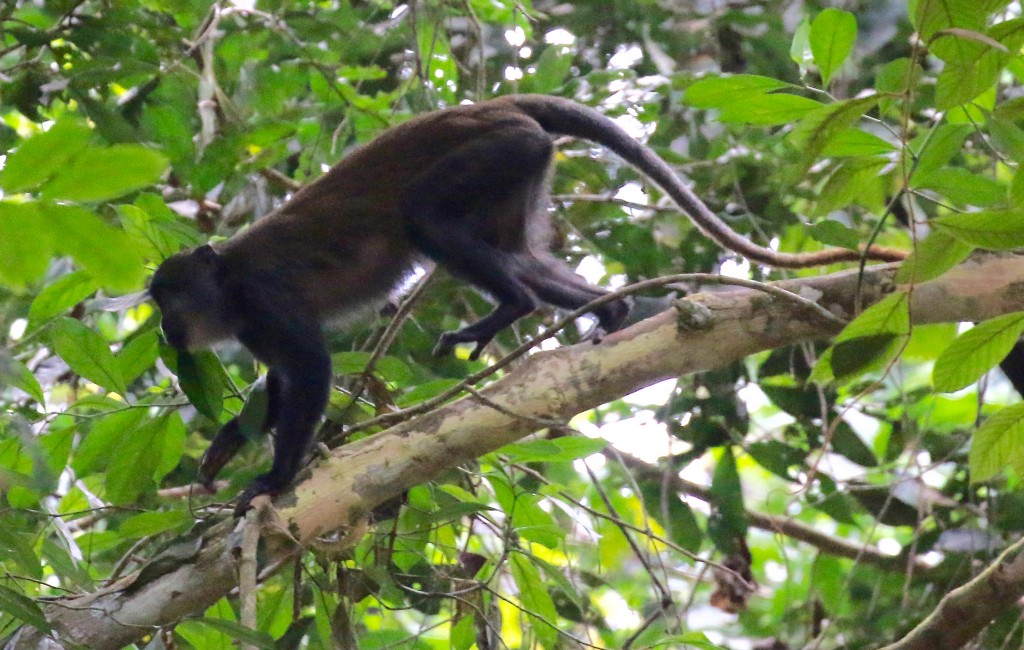
Sun-tailed Guenon, Cercopithecus solatus. Photo Sjef Ollers.
We spotlit around Mikongo Camp each night. Though the forest looked identical we saw virtually at night nothing along the road to the camp or the tracks leading from behind camp. But the trail that began immediately at below camp – from the bottom right hand corner of the clearing (when looking from the river) was spectacular two nights running.
This narrow trail follows the river for 100 metres then turns sharply for another 100 metres or so before reaching a swinging bridge across the river and continuing. We walked this track two nights running and saw many – and many different – animals. Some of the best spotlighting I have ever done in African rainforest, or any rainforest come to that (other perhaps than the wet tropics of northern Queensland).
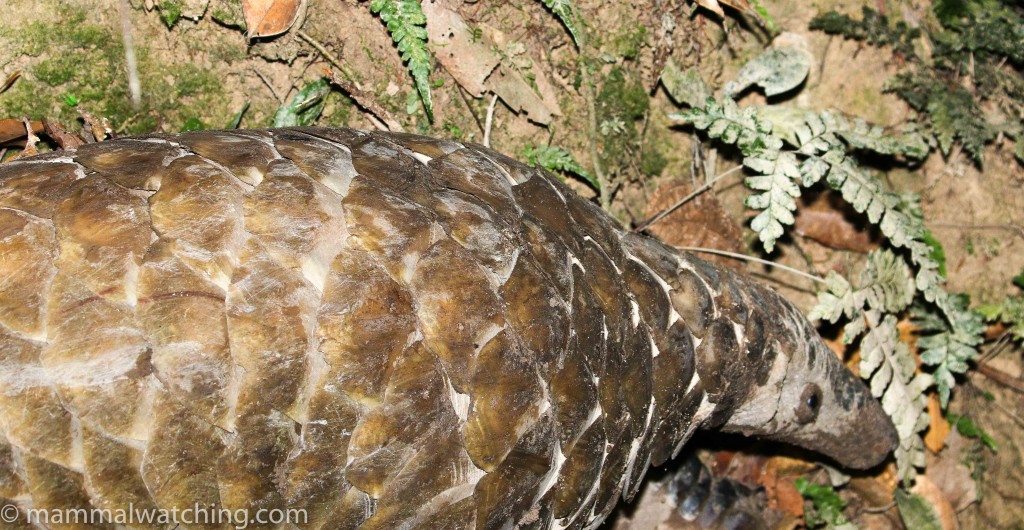
Giant Pangolin, Smutsia gigantea
Over the course of three days and nights some or all of the group encountered the following mammals. More details are in the annotated mammal list later in the report. Yes this is a pretty spectacular list!
Moustached Monkey, Grey-cheeked Mangabey, Black Colobus, Sun-tailed Guenon, Crowned Guenon, Chimpanzee, Mandrill, Gorilla (heard), Milne-edwards Potto, Bay Duiker, Ogilby’s Duiker, Blue Duiker,
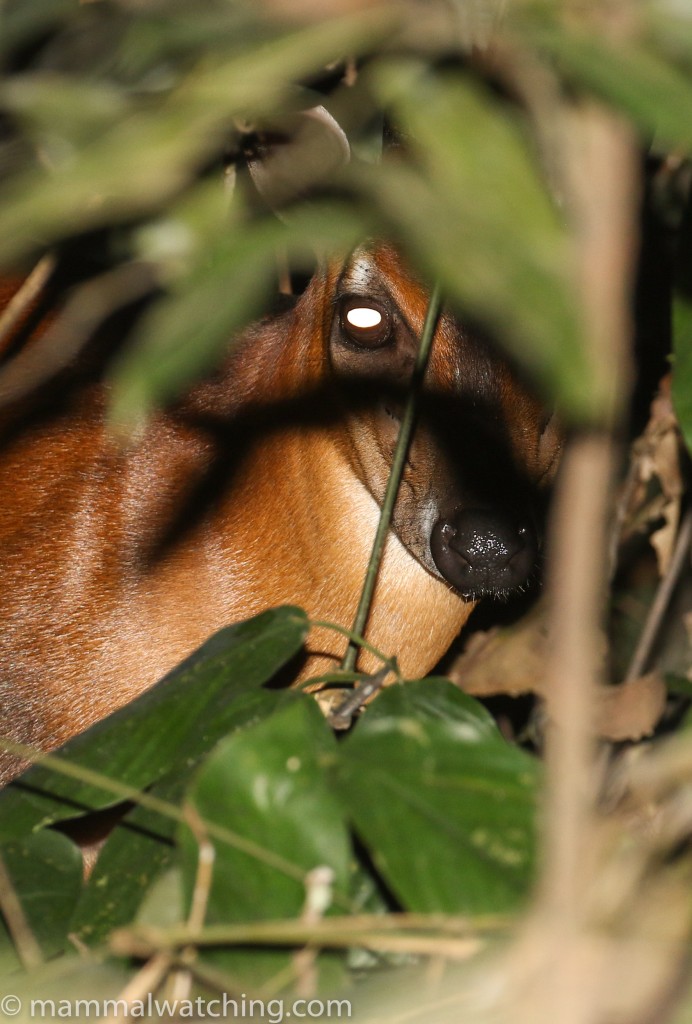
Bay Duiker, Cephalophus dorsalis
Red River Hog, Water Chevrotain, African Palm Civet, otter species (Spotted-necked Otter probably), Giant Pangolin, Lord Derby’s Anomalure, Dwarf Anomalure,
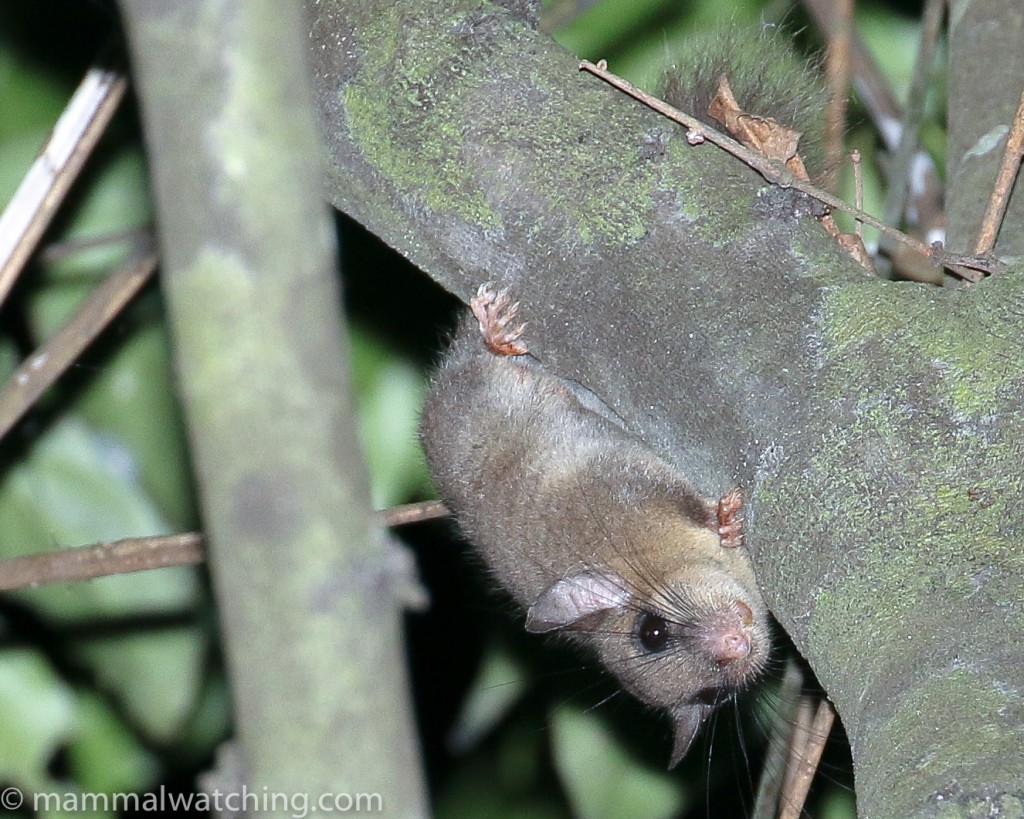
Cameroon Scaly-tail, Zenkerella insignis
Large-eared Flying Mouse, Cameroon Scaly-tail, Western Palm Squirrel, Green Squirrel, Red-legged Sun Squirrel, Rope Squirrel species, Giant Squirrel, Brush-tailed Porcupine, Franquet’s Fruit Bat, Cyclops Roundleaf Bat, freetailed bat species (either Mops brachyerus or Mops thersites), slit-faced bat species (from the Nycteris–Arge group), Walter Verheyen’s Mouse (probable).
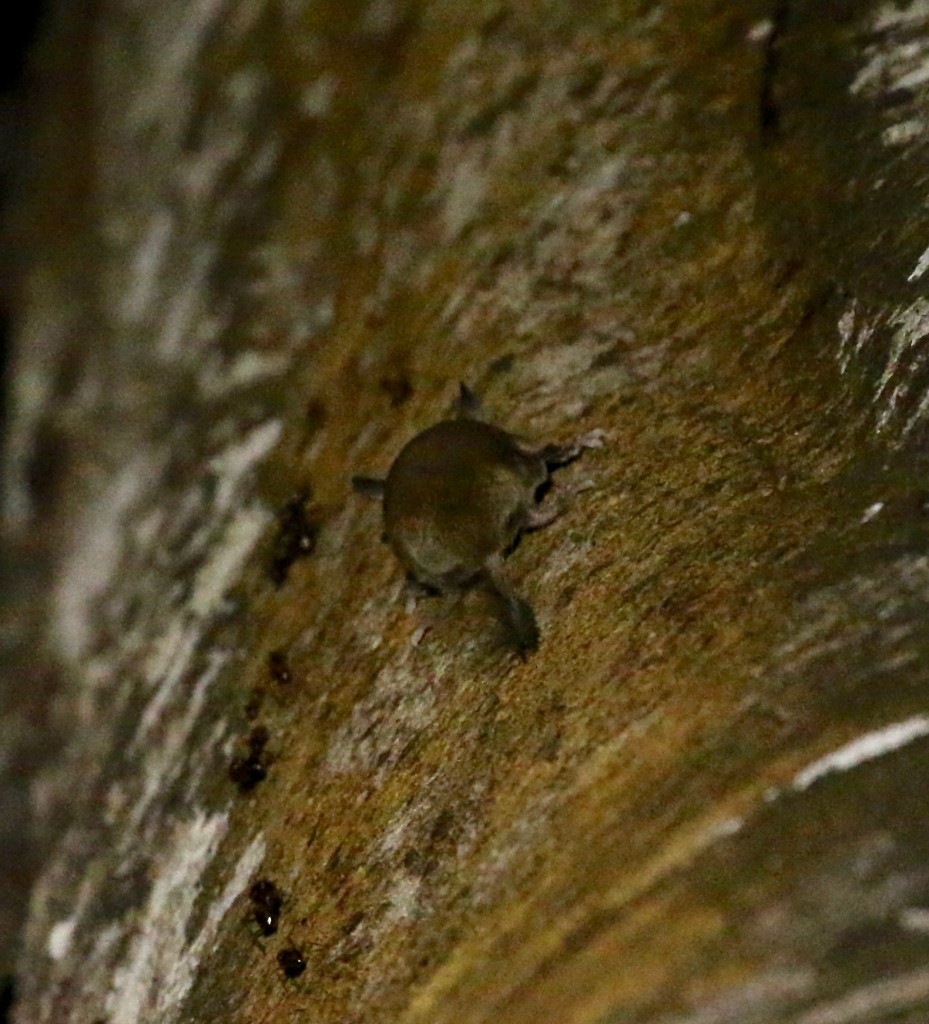
Long-eared Flying Mouse, Idiurus macrotis. Photo Sjef Ollers
Tuesday August 21: return to Lope then depart for Ndjole
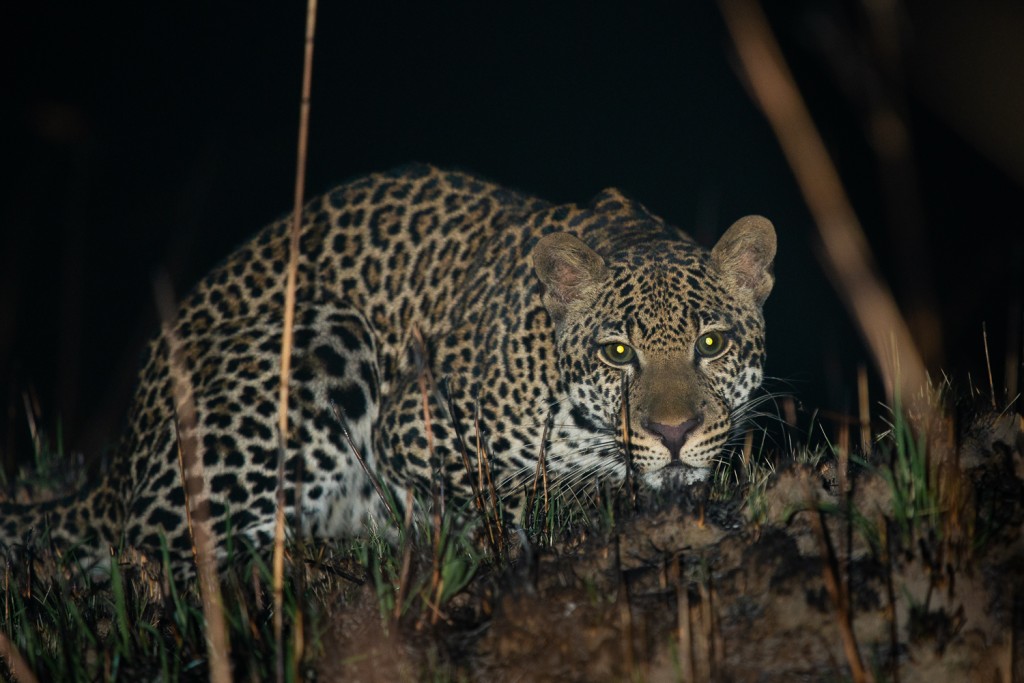
Leopard, Panthera pardus. Photo Paul Carter.
We spent the morning looking – successfully – for Sun-tailed Guenons along the main road (see above) before driving back to the Lope Hotel, where Guillermo had reserved us rooms for the day. After lunch and a chance to recharge our batteries (both literally and figuratively) we set out to visit a bat cave near Lope Village. A half hour drive, followed by a 45 minute walk up hill, took us to a cave filled with thousands of fruit bats. At first I thought these large yellow bats were Straw-coloured Fruit Bats, though I thought it was odd to see them roosting in a cave.
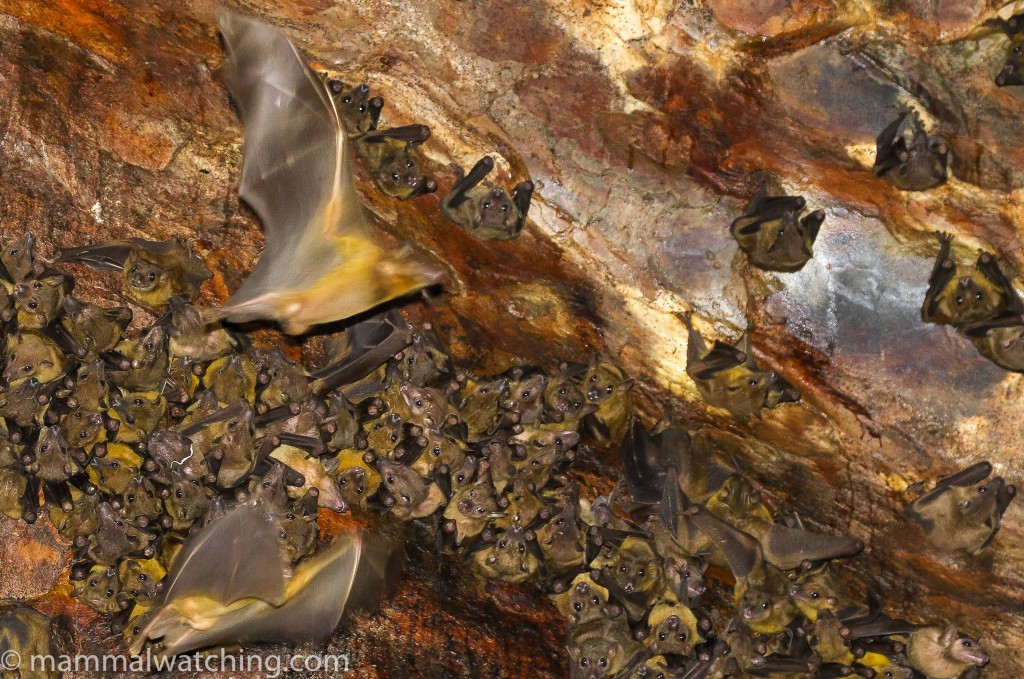
Egyptian Rousettes, Rousettus aegyptiacus
Afribats corrected me: these were pollen-tinted Egyptian Rousettus. Straw-coloured Fruit Bats do not – ever – live in caves.
Heading back to the lodge at dusk we saw – once again – the local Leopards and had a nice encounter with a pair of Greater Cane Rats at the roadside next to the bridge just before the hotel.
A night drive after dinner – from 9-11.30pm gave us great views of a Demidoff’s Galago and a long look at a group of Makandé Squirrel Galagos moving through some trees. Their behaviour and movement style is totally different to the Demidoff’s Galagos.
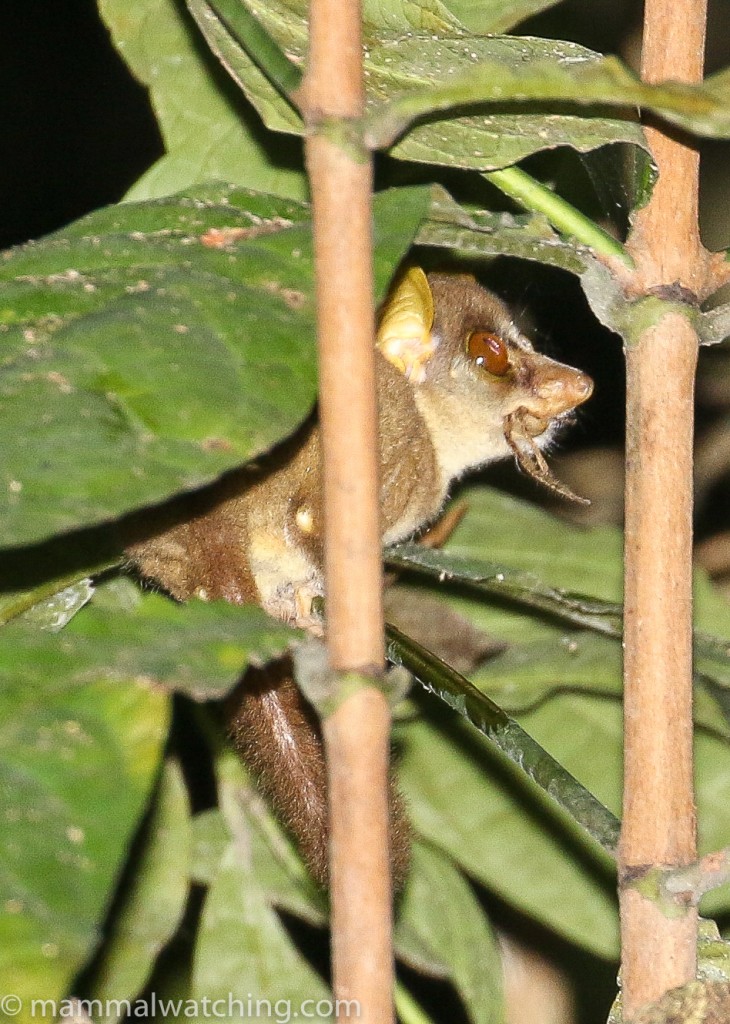
Demidoff’s Galago, Galagoides demidovii
We got back to the hotel just before midnight, collected our bags and drove the five minutes to the train station. The train scheduled to depart at 1.30am eventually left at 3.30am.
Weds August 21: Ndjole to Tsam Tsam Lodge
Some of us managed two hours’ sleep on the train before arriving into Ndjole Station at 5.30 a.m. where we were herded into waiting taxis. I slept the two hours to the town of Lambarene, only waking up at a police checkpoint where a fat cop tried to extract a very few dollars “administration fee” from us. He soon gave up: we weren’t worth the effort.
Breakfast was at the Albert Schwizer Hospital in the Lambarene. The food was what you might expect from a hospital. Venkat spotted a Hammer Bat in some trees in the grounds and Charles saw a Red-legged Sun Squirrel.
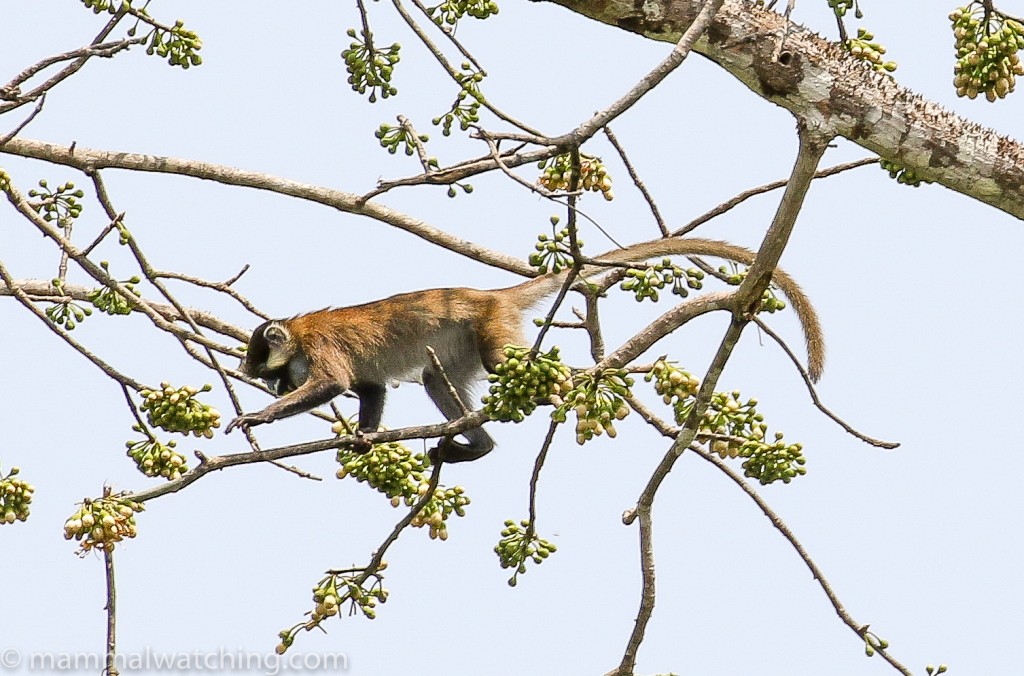
Moustached Monkey, Cercopithecus cephus
Heather, the manager of Tsam Tsam, picked us up in the boat at 10 a.m. from the river in front of the hospital. After cruising under the Lambarene bridge to see the Egyptian Rousette colony we continued down the river for two hours to the lodge, seeing a few Moustached and Putty-nosed Monkeys on the way, as well as some of Gabon’s last Hippos. They often see Red-capped Mangabeys along the river, and occasionally Northern Talapoins.
After lunch – the first of many delicious Tsam Tsam meals – we took a short pirogue trip from the lodge. This is a slow and seemingly hopeless way to look for mammals. A speedboat trip after dinner was more successful.
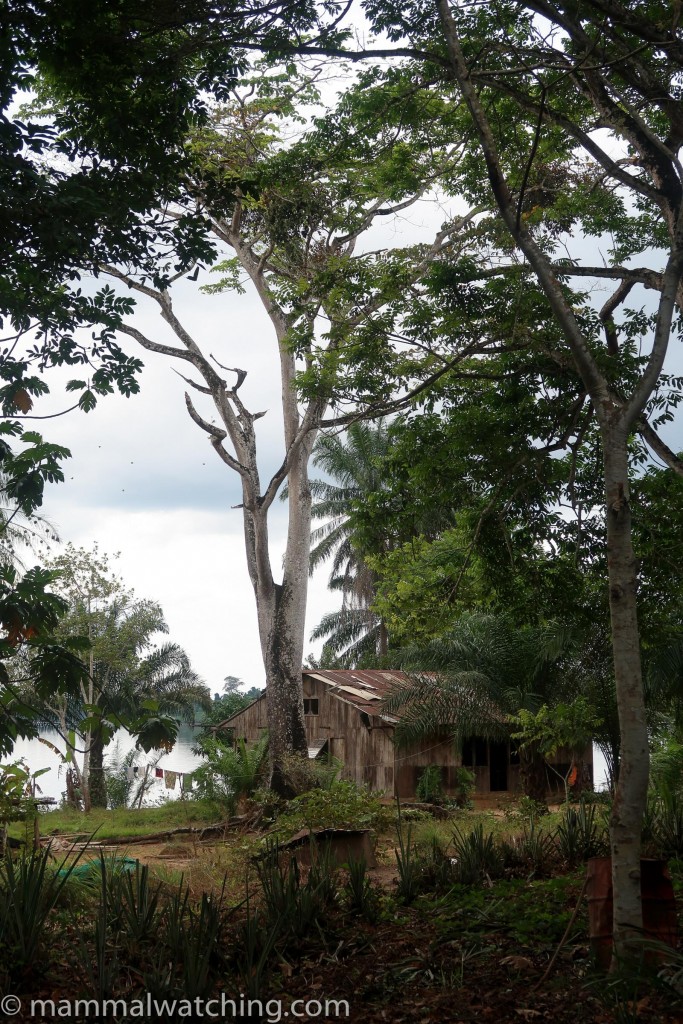
Tsam Tsam Village
Thursday August 22 – Friday August 23: Tsam Tsam
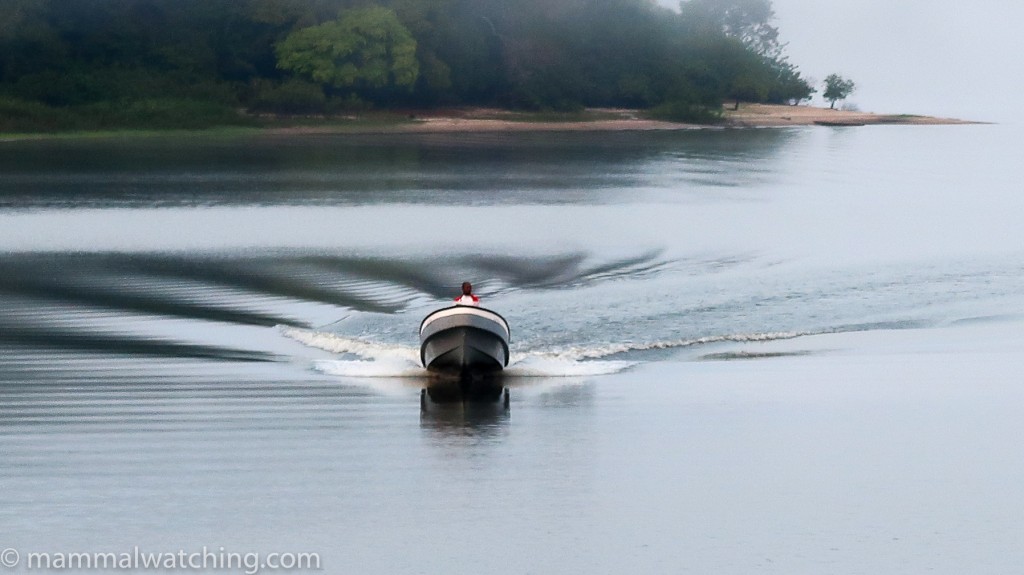
We spent both our mornings in Tsam Tsam hiking through the forest and savannah patches. We spent the late afternoons on the speedboat. First, chasing Red-capped Mangabeys. Then looking for African Manatees. We set small mammal traps around the lodge and caught a lot: trap success was around 50% and we caught at least two species. One group of animals were Praomys species: likely Praomys misonnei or Praomys petteri (or possibly both). The other were one of the Wood Mice I think. We ate very well … or did I mention that five times already?
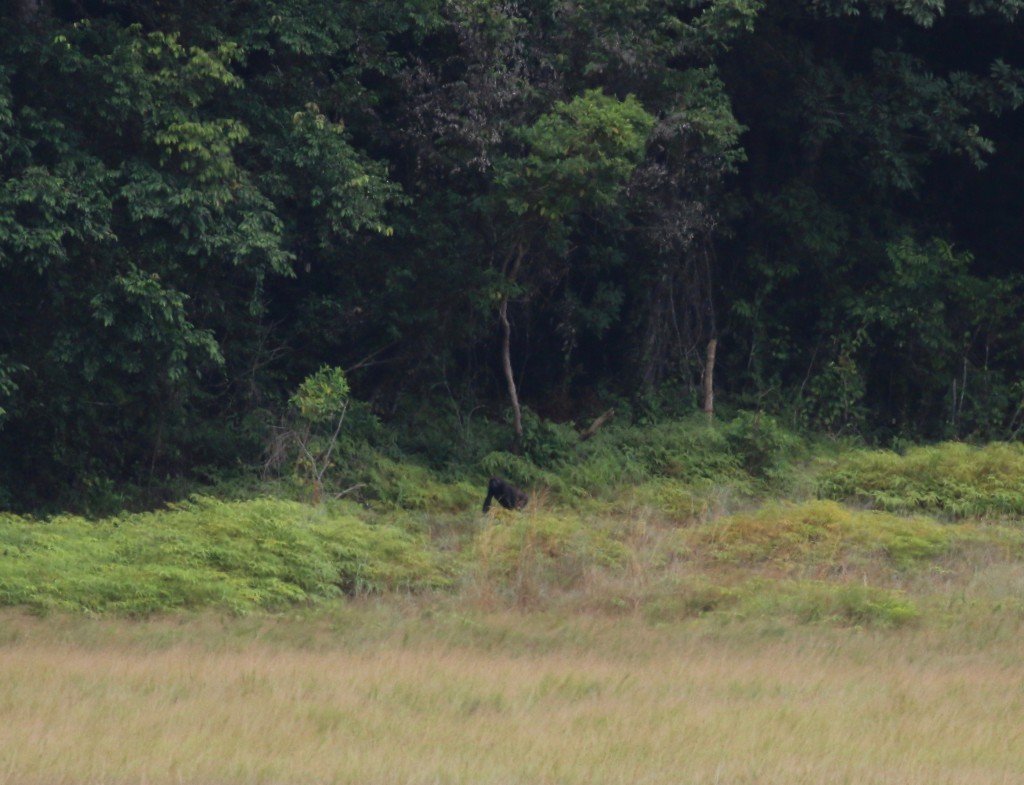
Western Lowland Gorilla, Gorilla gorilla. Photo Sjef Ollers.
Over the course of three days and nights some or all of the group encountered the following mammals. More details are in the annotated mammal list later in the report: Green Squirrel, Lord Derby’s Anomalure, Putty-nosed Monkey, Crowned Guenon, Western Lowland Gorilla, Red-capped Mangabey,
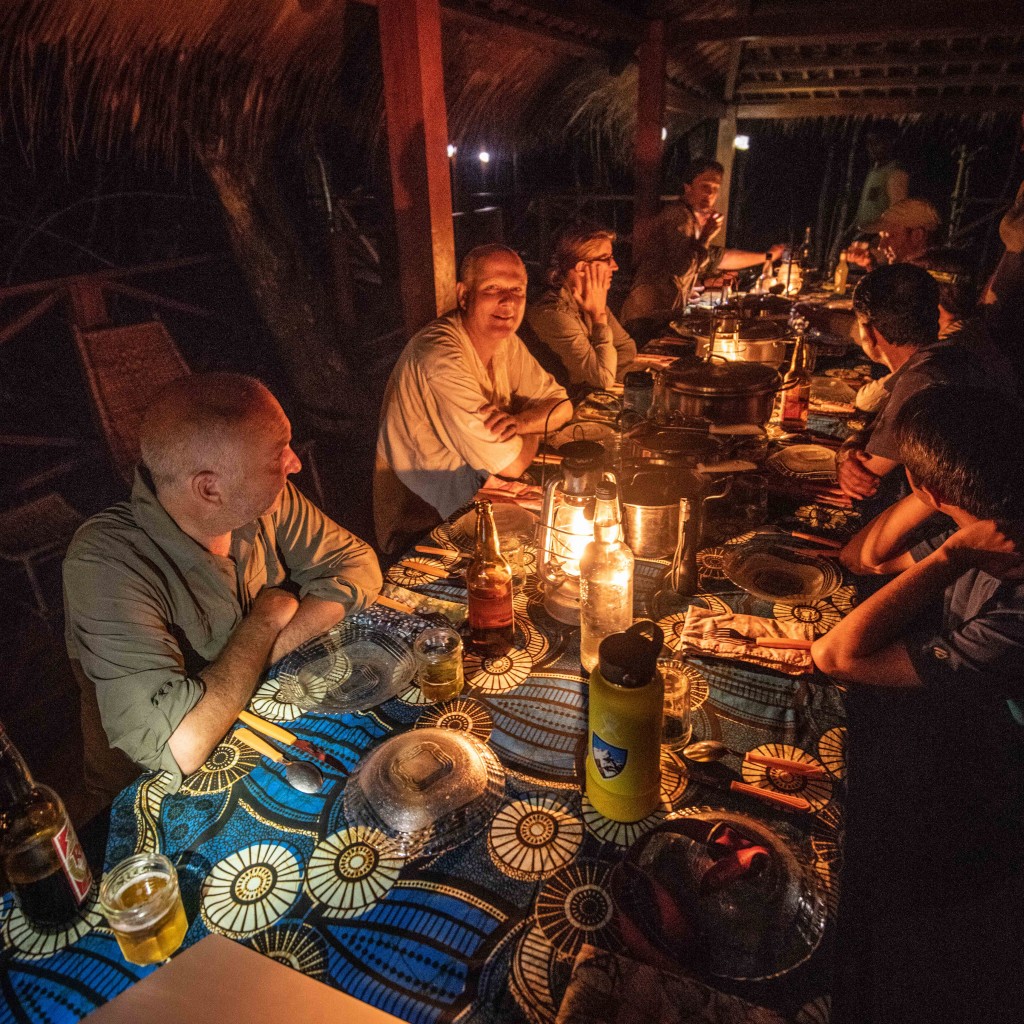
Tsam Tsam dinner. Photo Charles Hood.
Demidoff’s Galago (probable), Blotched Genet, Marsh Mongoose, Hammer Bat, Egyptian Rousettus, unidentifiable roundleaf and slit-faced bats, Sitatunga, Giant Pangolin, and (probable) Soft-furred Mice and Wood Mice.
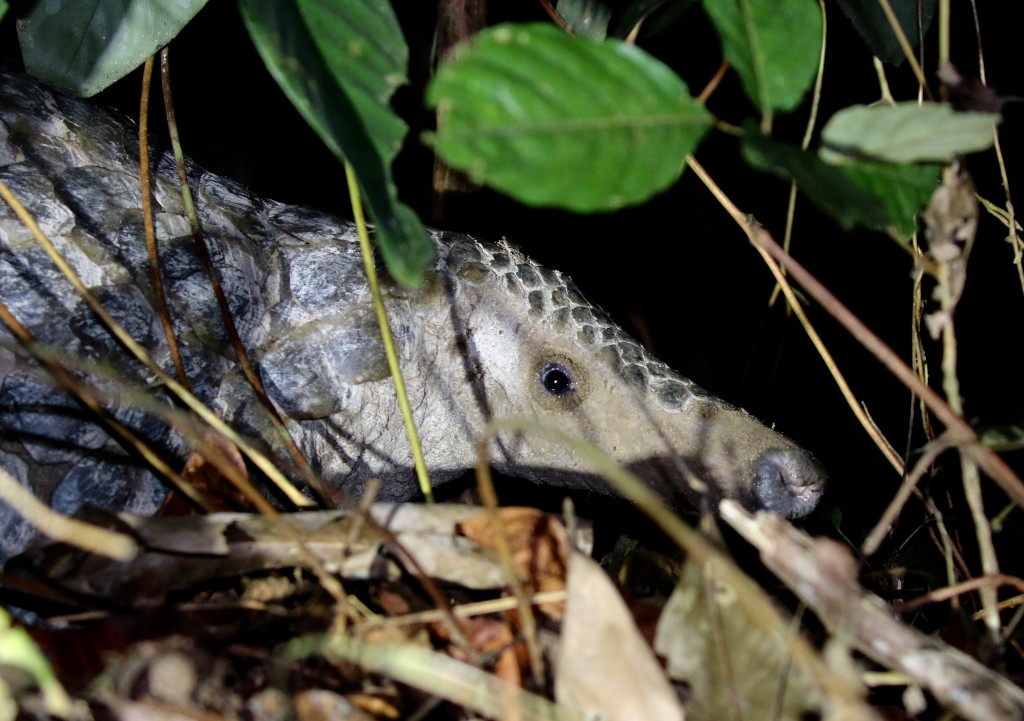
Giant Pangolin, Smutsia gigantia. Photo Sjef Ollers.
Saturday August 24: Tsam Tsam to Libreville
We left Tsam Tsam after breakfast for the river trip back to Lambarene. Our itinerary had us staying the night at the Albert Schweitzer Hospital there and traveling back to Libreville on Sunday. But our brief introduction to the hospital a few days earlier meant none of us was keen on spending a night there: there seemed little prospect of doing much other than spending a mammalless night in a crappy hotel.
So the previous night we had asked Vianet about other options. He muttered something about going to see the Talapoins near Libreville. Wait! What?! Talapoins?! You can imagine the uproar. And so as soon as we landed at Lambarene poor Vianet was making phone calls to arrange immediate transport back to Libreville while we ate lunch. We spent 30 minutes in our rooms trying to siesta through the noise of the construction site and then a bus arrived. Yes, Vianet had somehow conjured up transport. And at 3 p.m. our philosophical bus driver was loading our bags into the back of his ever-expanding minibus. Six hours later we were checking into the last empty hotel rooms left in Libreville.
Sunday August 25: Akanda National Park

En route to Akanda
Vianet had assured us that there are Northern Talapoins living in Akanda National Park on the north-east edge of Libreville. He also reckoned he could arrange a trip at short notice to a tiny island that was home to some monkeys. We met at 8 a.m. to take a short taxi ride to the smelly market on the edge of town and the mangroves where we met a ranger and his boat.
It took about an hour cruising, first through mangroves and then along a wider river, to reach the ranger station in the estuary. A handful of talapoins had indeed established themselves on this handkerchief sized island years earlier.
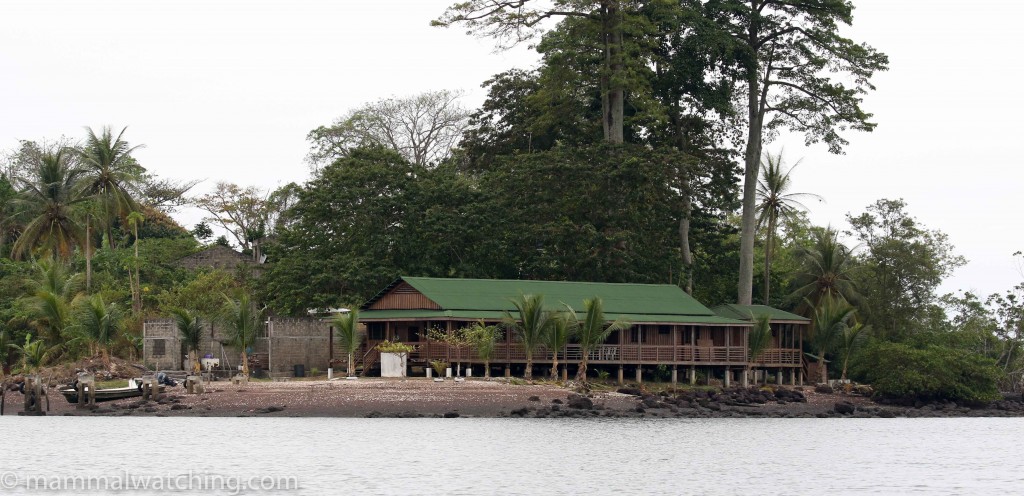
Talapoin island
But, thought it was probably smaller than a soccer pitch, it still took an hour or two for us all to see these small shy monkeys. Quite how they avoided us for so long I don’t know.
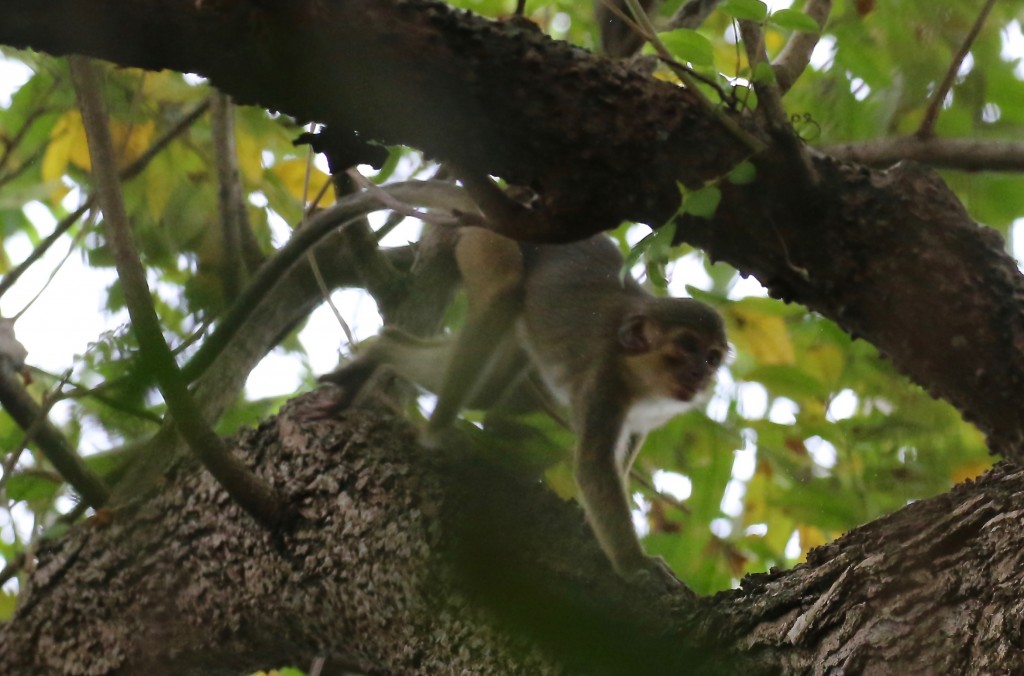
Northern Talapoin, Miopithecus ogouensis. Photo Sjef Ollers.
We also kept half an eye open for African Manatees. The rangers said they has seen one that morning and that they often saw them around high tide. Had we known about this in advance Vianet could probably have arranged for us to spend a night on the island and I suspect we would have seen a manatee. But perhaps we were just getting greedy. So it was back to the Tropicana Hotel for a tasty – and let’s be honest smug and very self-satisfied – lunch. Most of us flew home that evening.
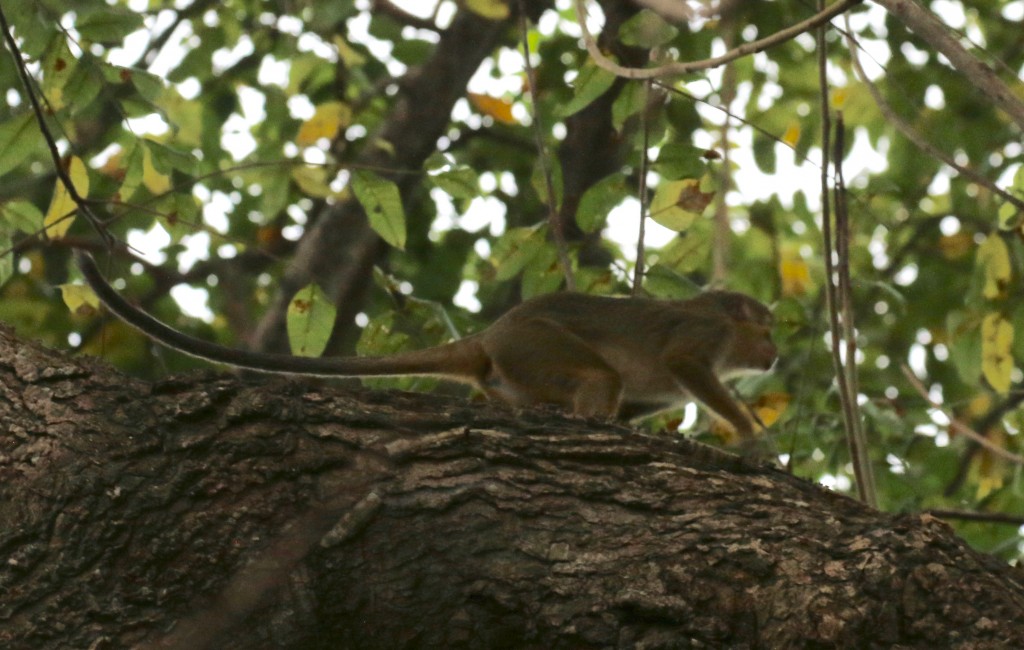
Northern Talapoin, Miopithecus ogouensis. Photo Sjef Ollers.
The Mammals
1. F Lorrain Dormouse, Graphiurus lorraineus
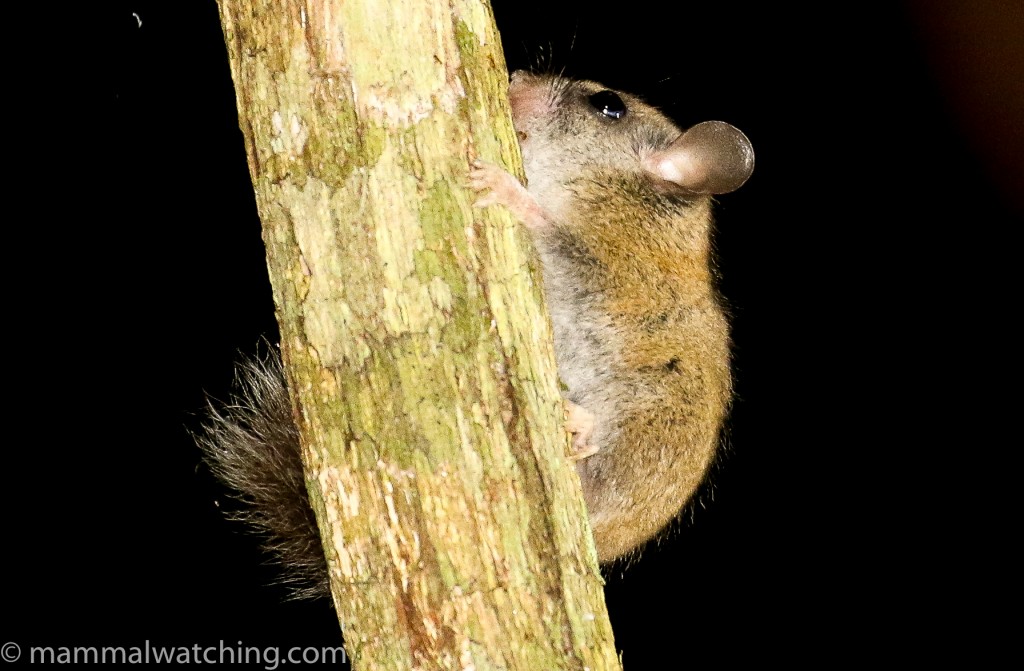
Lorrain Dormouse, Graphiurus lorraineus
We picked up this tiny dormouse in the thermal scope. It was frozen on a vine over a creek in Lope National Park at night. It didn’t flinch when we waded through the water to within two metres. The animal cannot have been more than 8cm long and on the basis of size and colour I think it was a Lorrain Dormouse. The other species in Gabon – Natglas’s, Jentink’s and Silent Dormouse – are all quite a bit larger.
2. Red-legged Sun Squirrel, Heliosciurus rufobrachium
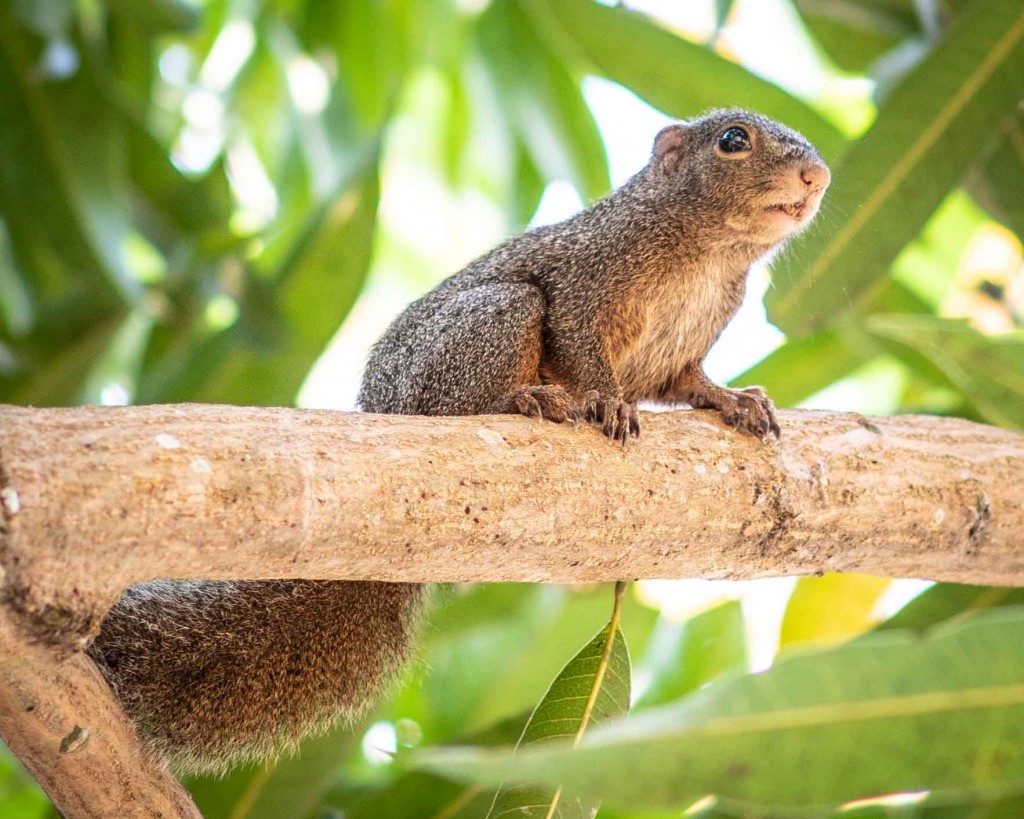
Red-legged Sun Squirrel, Heliosciurus rufobrachium. Photo Charles Hood.
We saw at least three of these during forest hikes: one in Lope, one in Mikongo and one in Lambarene (in the hospital grounds). Most of the squirrels we positively identified were Green Squirrels, but, inevitably, several squirrels went unidentified and could have been Red-legged.
3. Forest Giant Squirrel, Protoxerus stangeri
Only one confirmed sighting, while we were walking along the road near Mikongo Village looking for Sun-tailed Guenons. Seen only briefly by a few of the group and not photographed.
4. F Western Palm Squirrel, Epixerus ebbi
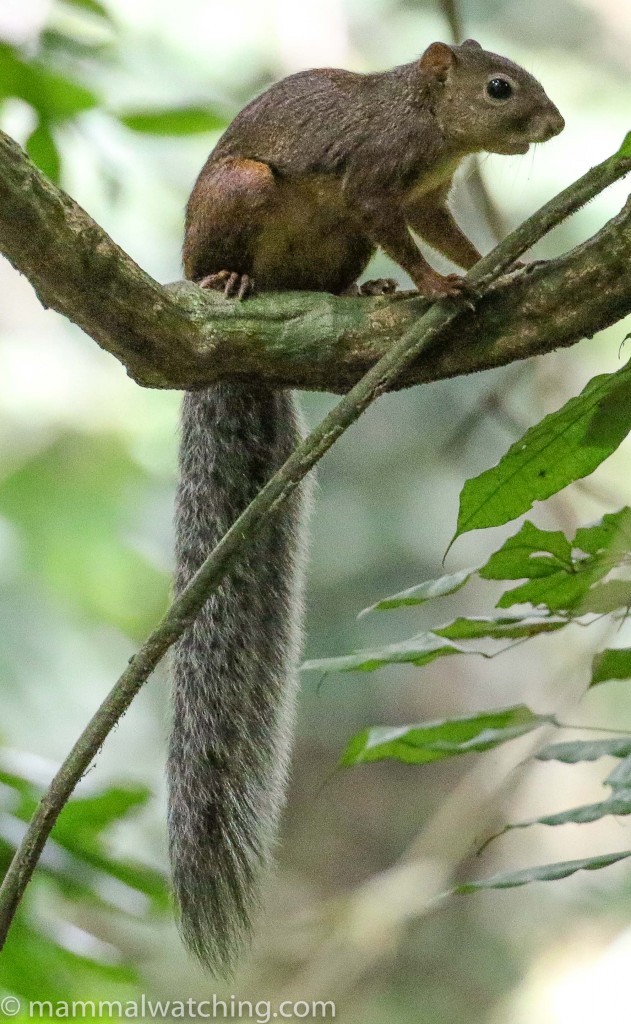
Western Palm Squirrel, Epixerus ebii wilsoni
A fabulous squirrel and one of the mammals of the trip for me: just look at that tail! Most of the group saw one during a forest hike in Lope while my group was out Mandrill watching. We all had good views of an animal in the forest at Mikongo Camp. And some people saw another squirrel, in a palm plantation near Mikongo Village, that was likely this species.
5. Green Bush Squirrel, Paraxerus poensis
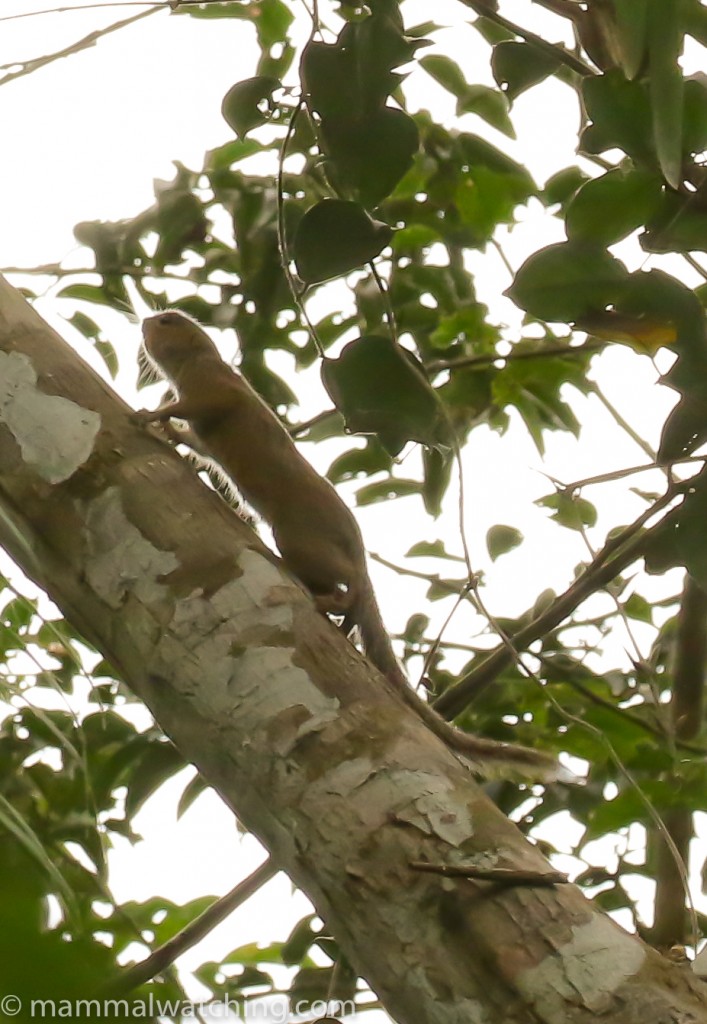
Green Bush Squirrel, Paraxerus poensis
The commonest squirrel of the trip, we spotted several in Lope and Mikongo and another in Tsam Tsam. All were seen while we were walking in the forest.
6. Rope Squirrel Species
We got glimpses of another squirrel on the ground in Mikongo. It ran across the trail and disappeared into thicker vegetation and an upturned root system. Venkat got a better look than most of us and thought it was a rope squirrel, but it seems impossible to determine which of the several species occurring there.
7. F Typical Striped Grass Mouse, Lemniscomys striatus
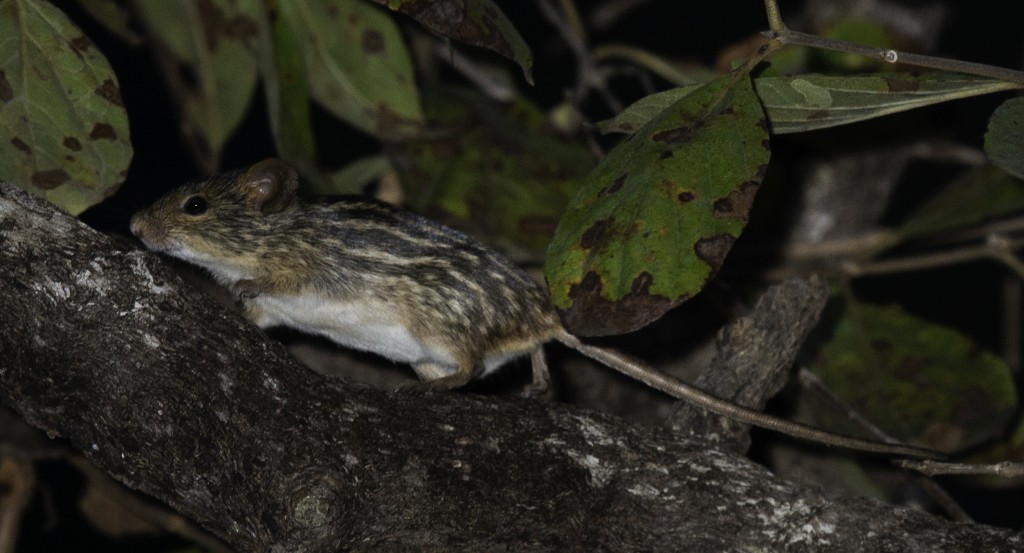
Typical Striped Grass Mouse, Lemniscomys striatus. Photo Paul Carter.
The thermal scope struck again with this one, picked up – from a fast-moving vehicle – on a bush in the late afternoon. The driver and guide were impressed! The only leminiscomys occurring in Gabon I think.
8. Wood Mouse species, Hylomyscus sp²
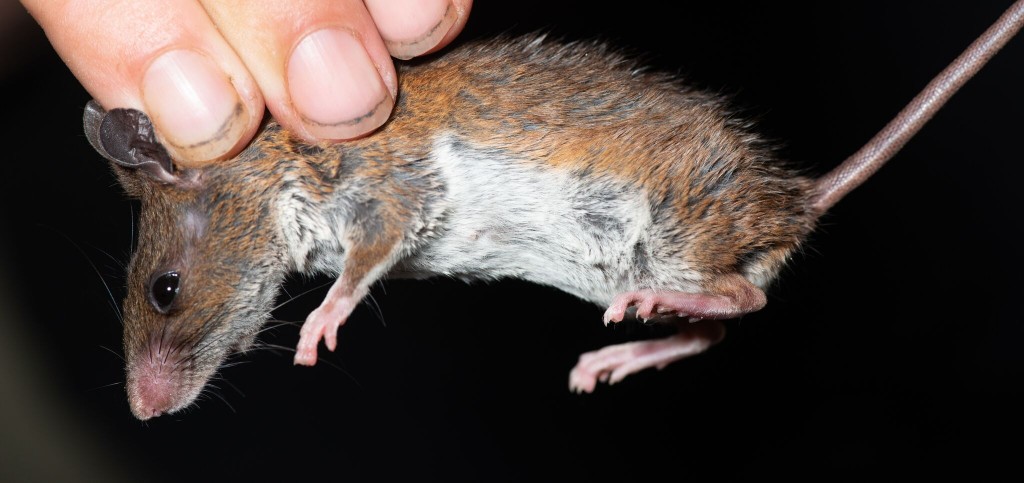
Wood Mouse species, Hylomyscus alleni or H. walterverheyeni. Maybe. Photo by Paul Carter
We caught quite a few of these around the lodge at Tsam Tsam where small mammal trapping was very productive. A couple of experts thought they were either Praomys or Hylonyscus species: but on the basis of the long tail (often more than %140 of head body length) and overall size (with a head body of around 100mm and a tail of over 140mm) I think they were most likely Wood Mice.
9. F Walter Verheyen’s Wood Mouse, Hylomyscus walterverheyen²
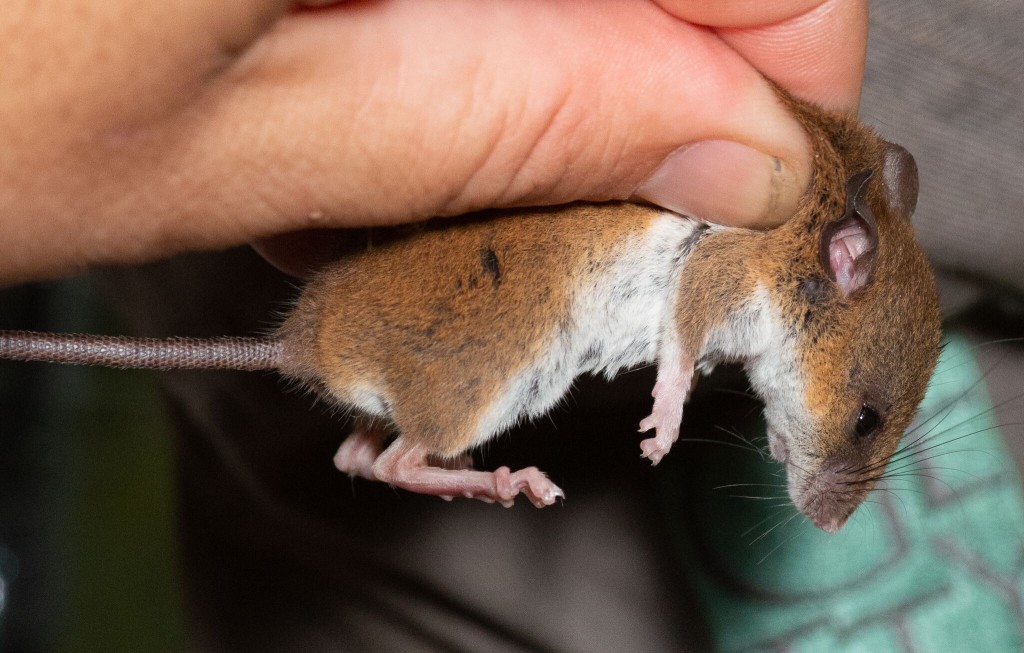
Walter Verheyen’s Wood Mouse, Hylomyscus walterverheyeni. Photo by Paul Carter.
We caught one of these around the cabins at Mikongo. Kevin saw a mouse in his room that might also have been this species. Expert opinion from French researchers is that this is either Hylomyscus walterverheyeni or H. alleni. And on the basis of other studies in this forest, Hylomyscus walterverheyeni is more likely. It has been caught in the area before. H alleni has not.
10. F Missone’s or Peter’s Soft-furred Mouse, Praomys misonnei or P. petteri²
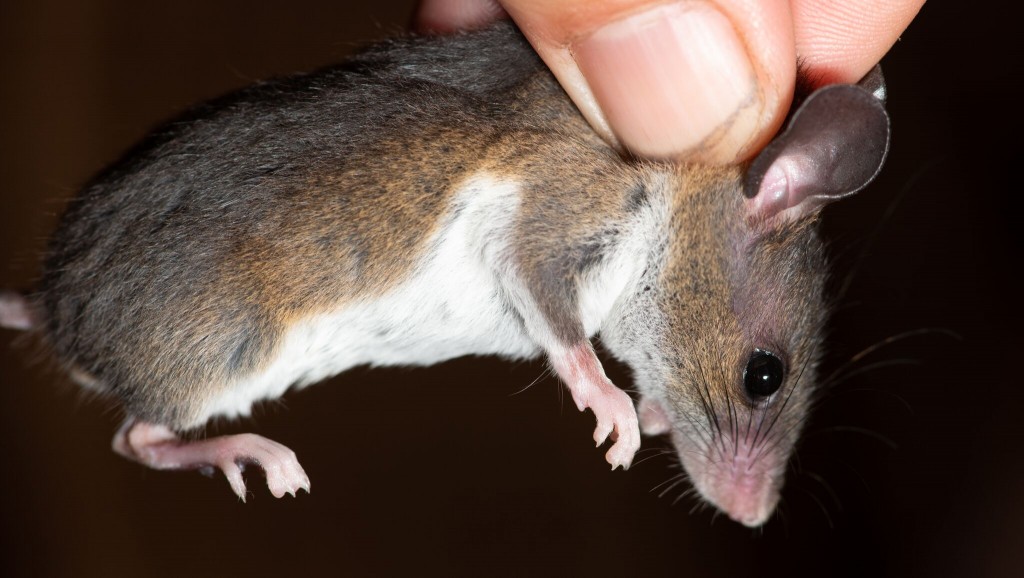
Either Missone’s or Petter’s Soft-furred Mouse, Praomys misonnei or P. petteri. Photo Paul Carter.
We caught quite a few of these around the lodge at Tsam Tsam where small mammal trapping was very productive. Experts in France believe these animals were one of the Soft-furred Mouse (Praomys) species, and both Praomys misonnei and P. petteri are quite common in Gabon. We may well have caught both species in fact.
11. Beecroft’s Anomalure, Anomalurus beecrofti
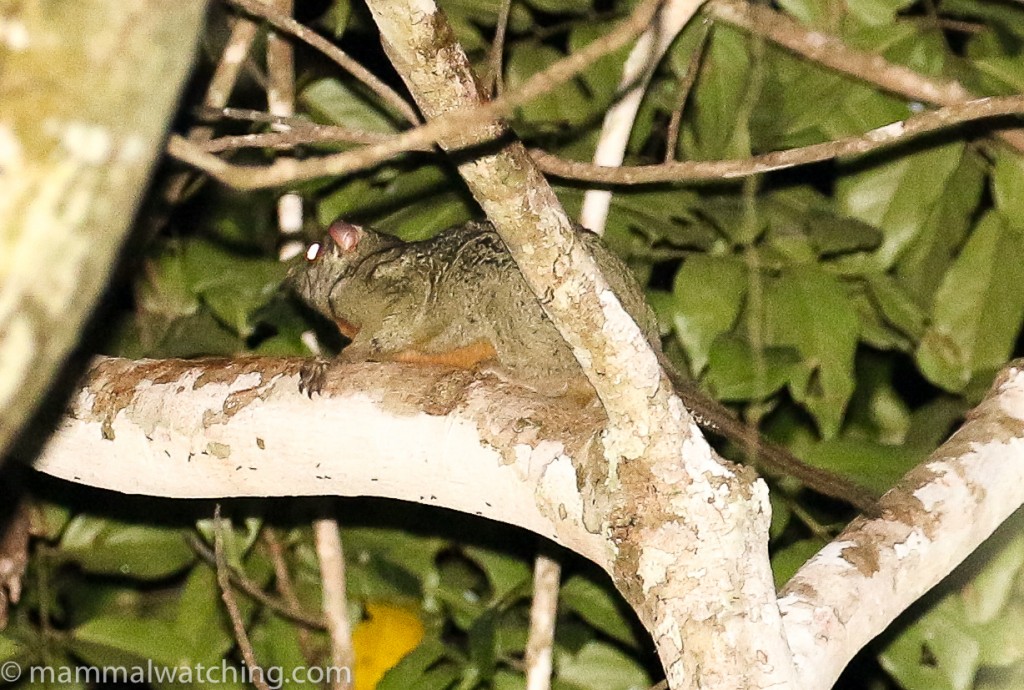
Beecroft’s Anomalure, Anomalurus beecrofti
My thermal scope picked up one of these quite high – and far from us – during a night drive at Lope. After much discussion, spotlight pointing and photography we were coming to the conclusion that it was probably an anomalure when it glided across a clearing to put our minds at rest. We initially though it might have been a Dwarf Anomalure because it was so differently coloured to the Beecroft’s Anomalure I saw in the Central African Republic. But it had colouring consistent with the Gabon subspecies.
12. Dwarf Anomalure, Anomalurus pusilus¹ ²
Venkat and Sjef got a decent look – but no photos – of an anomalure during our first night in Mikongo Camp. It was close to the campsite about 100 metres along the trail that runs to the swinging bridge. They were pretty confident it was a Dwarf, rather than Beecroft’s, Anomalure. One of two lifers for me on this list that I dipped on.
13. Lord Derby’s Anomalure, Anomalurus derbianus
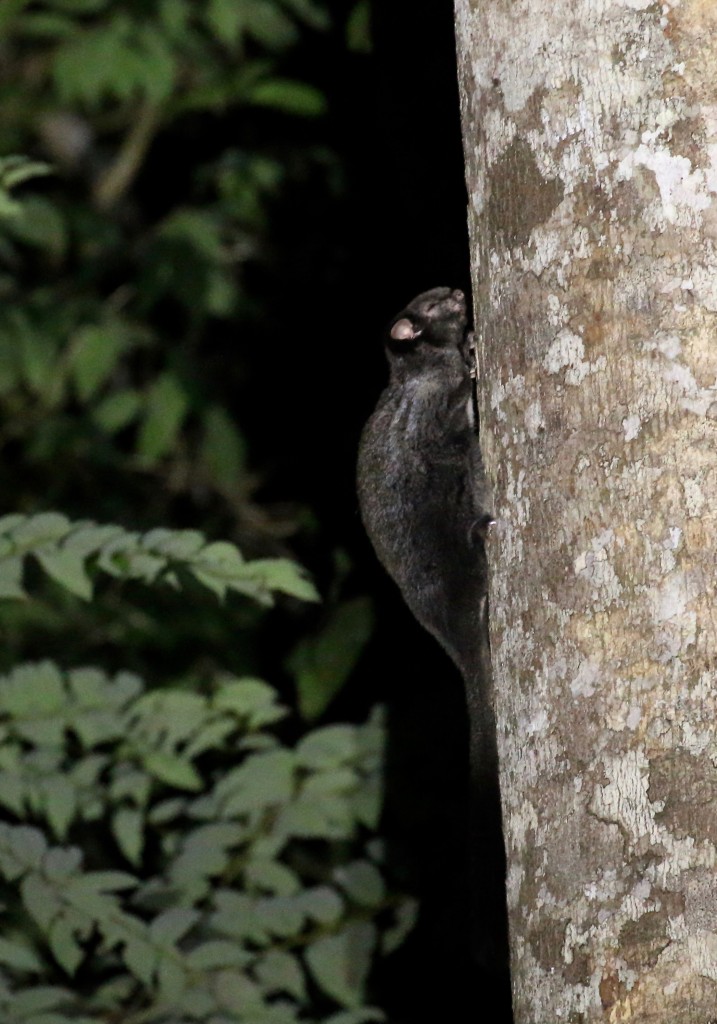
Lord Derby’s Anomalure, Anomalurus derbianus. Photo Sjef Ollers.
We had good views of this species at Mikongo along the trail near camp two nights running and saw several animals. Paul found another roosting in a hollow tree at Tsam Tsam.
14. F Cameroon Scaly-tail, Zenkerella insignis
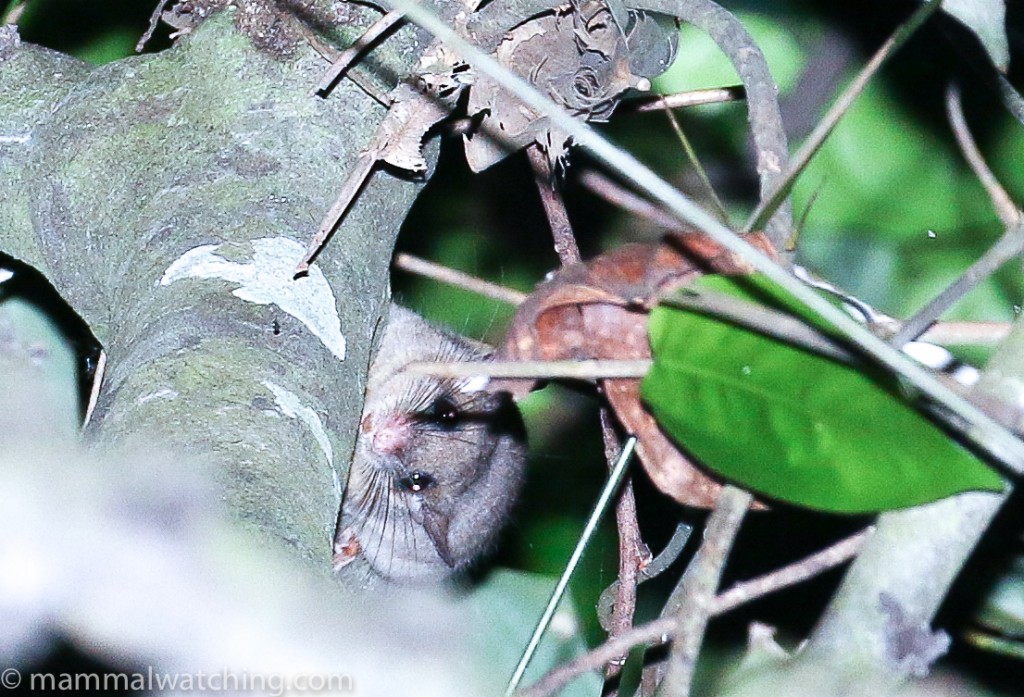
Cameroon Scaly-tail, Zenkerella insignis
We picked up one of these in the thermal scope in Mikongo on a tree trunk about 7 metres up, once again along the trail near camp. As soon as I shone a light on it scuttled high into the tree and sat looking at us. I think another animal was close by, though it was even more obscured and was little more than a white spot in the thermal scope. Unfortunately none of us managed to get a photo – or look – at the base of the tail.
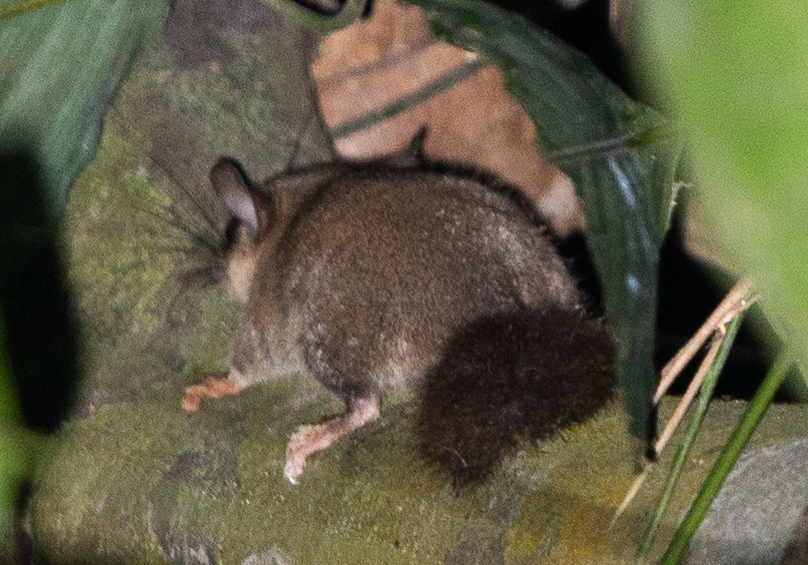
Cameroon Scaly-tail, Zenkerella insignis. Photo Paul Carter.
I had a nagging doubt this might have been a large dormouse but cannot see any Gabonese dormouse species with a black tail. That, coupled with the noticeable black hairs on the ankles, lack of a facial mask and sharp facial features (relative to a dormouse at least), convinced me that this was a Cameroon Scaly-tail. It is somewhat more colourful than the illustrations I have seen but this is, remember, a species know from only a handful of specimens.
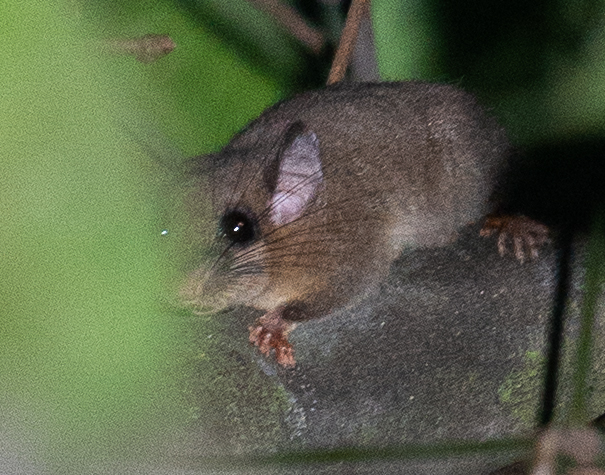
Cameroon Scaly-tail, Zenkerella insignis. Photo Paul Carter.
That said, I suspect they are not uncommon at Mikongo. Just hard to see without some nocturnal searching preferably with thermal scopes. Which is presumably not a common activity in Mikongo. Louise Emmons, a small mammal expert who is familiar with Zenkerella in Gabon, was also confident in our ID. Phew.
15. F Long-eared Flying Mouse, Idiurus macrotis
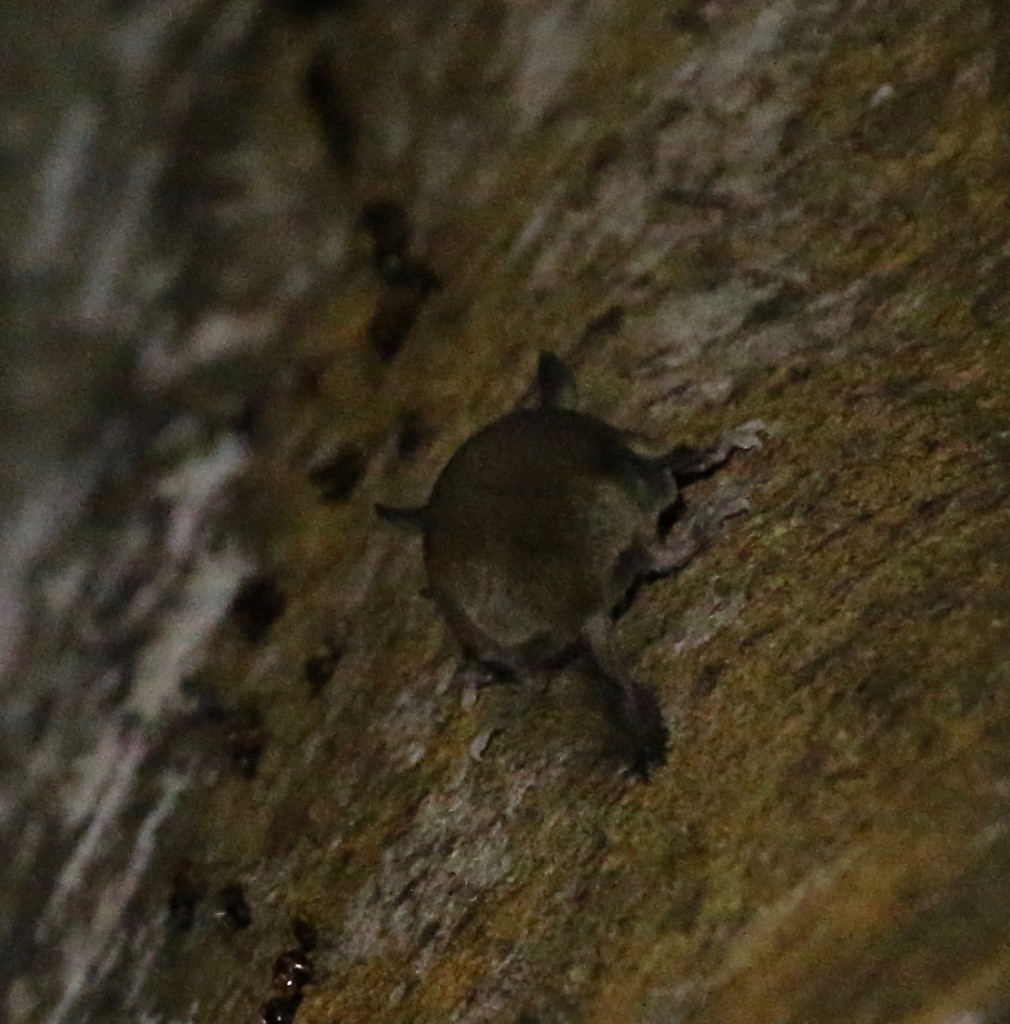
Long-eared Flying Mouse, Idiurus macrotis. Photo Sjef Ollers.
Another exciting species that seemed quite common in Mikongo. We saw several two nights running along the trail near camp. They appeared to be feeding on sap flowing from a particular (large) tree species. They were pretty shy of the lights though: usually running around the tree to the shaded side. Only Sjef managed to get a decent picture.
16. Greater Cane Rat, Thryonomys swinderianus
We were lucky to see two of these large rats on the roadside at dusk. They were on the roadside by the long grass at the end of the last bridge you cross before reaching the Lope Hotel (coming from the national park).
17. Brush-tailed Porcupine, Atherurus africanus¹
Only Ghislain saw this though most of us heard it rustling at the side of the road near Mikongo early in the morning. Ghislain – somehow once again – managed to be in the right place to see it climbing the bank. Yes. I was envious of his superpowers! It would have been a lifer for me.
18. F Giant Pangolin, Smutsia gigantea
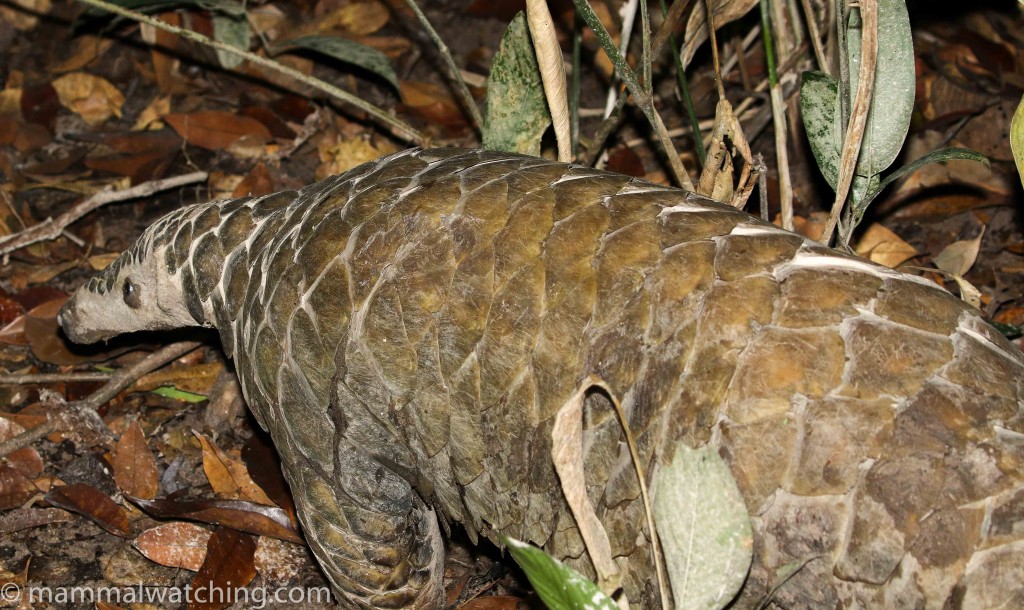
Giant Pangolin, Smutsia gigantea
Without doubt the mammal of the trip for all of us. When I left for Gabon I hoped to see two of my 25 most wanted mammals: Mandrills and Red River Hogs. And though I knew there was a chance of seeing Giant Pangolins (pretty much my most wanted species in the world) I did not hold out much hope. That started to change when we learned that tourists had seen a Giant Pangolin in Mikongo the month before we were there. But still, from what we could gather, the species is rare and hard to see in Gabon. Vianet had only seen a handful despite spending many years in Lope National Park. And yet we saw them twice, in separate locations.
I will not give a lot of detail on where we saw them, though to be honest I doubt whether doing so would be giving much new information to anyone with a desire to poach. David said pangolin poachers in Gabon typically lay out a net through the forest that might be a kilometre or more long, catching pangolins and just about anything else unfortunately enough to walk into it. But please do get in touch with me direct if you are going to Gabon and not planning to eat one.
The first animal was around Mikongo Camp, in exactly the same place that tourists had seen one a month before. We had planned to spend our last night in Mikongo staking out a pangolin burrow if we could find an active one. But on the second night as we were starting to return to camp, Ghislain – the talented local guide – asked us to “Attendez ici” and wandered off. Some of us started to get restless, thinking we were lost. A couple of minutes later he started yelling “Venez ici. Vite! Vite!” My French – as both my children will laughingly tell everyone – is appalling but I knew that venez meant come here, not run away (unlike some of the group who I later discovered were wondering if we needed to flee a charging elephant). I did not hang around to explain. Let’s be honest, I would have trampled over blind orphans to have gotten to Ghislain quickly. I am not proud of this. Just self-aware. So, yes, I was first off the blocks charging through the mud, my camera and bins swinging wildly around me, with nine other mammal watchers in hot pursuit. Usain Bolt eat your heart out. You’d never have caught me.
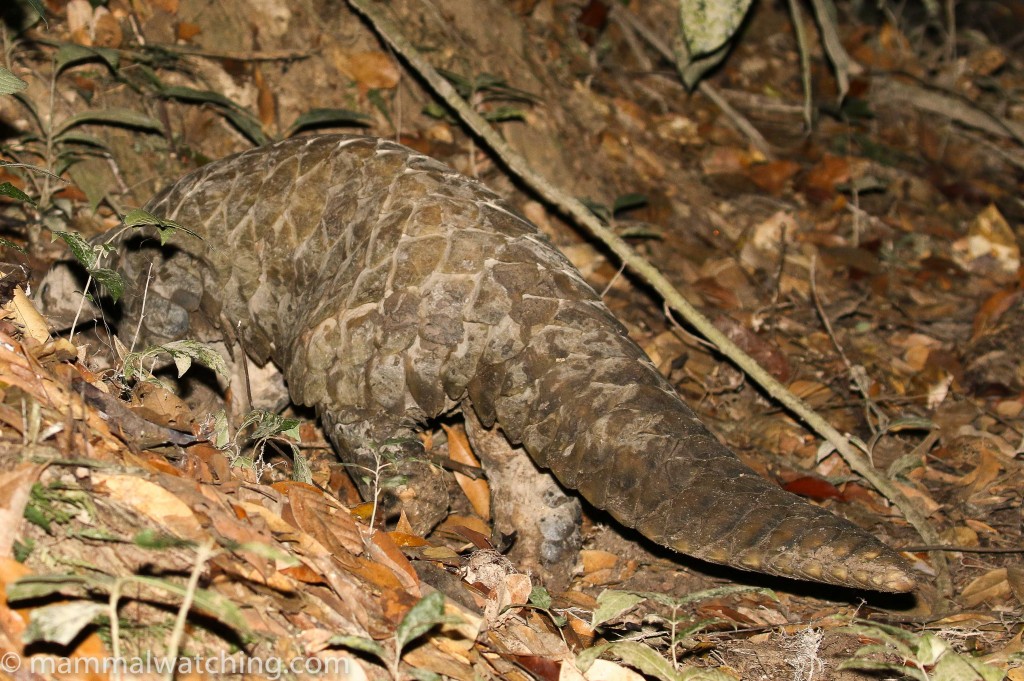
Giant Pangolin, Smutsia gigantea
Sure enough, as I hurdled a log and entered a clearing, there was Ghislain, lying on his face, fastened onto the tail of a Giant Pangolin that was slowly pulling him through the mud and into the undergrowth. I don’t remember my exact words, but I am pretty sure they would have involved holy and shit. An absolutely magical moment for all of us. Perhaps it was less magical for the pangolin, but to be honest the animal did not seem particularly upset with the intrusion and I am pleased to say all of us were pretty considerate of the animal’s wellbeing, even though this was a Giant f**ing Pangolin. So after a minute or two of breathless wows, oohs and ohmygodafuckinggiantpangolins we left the animal to trot into the forest as we tried to stop shaking.
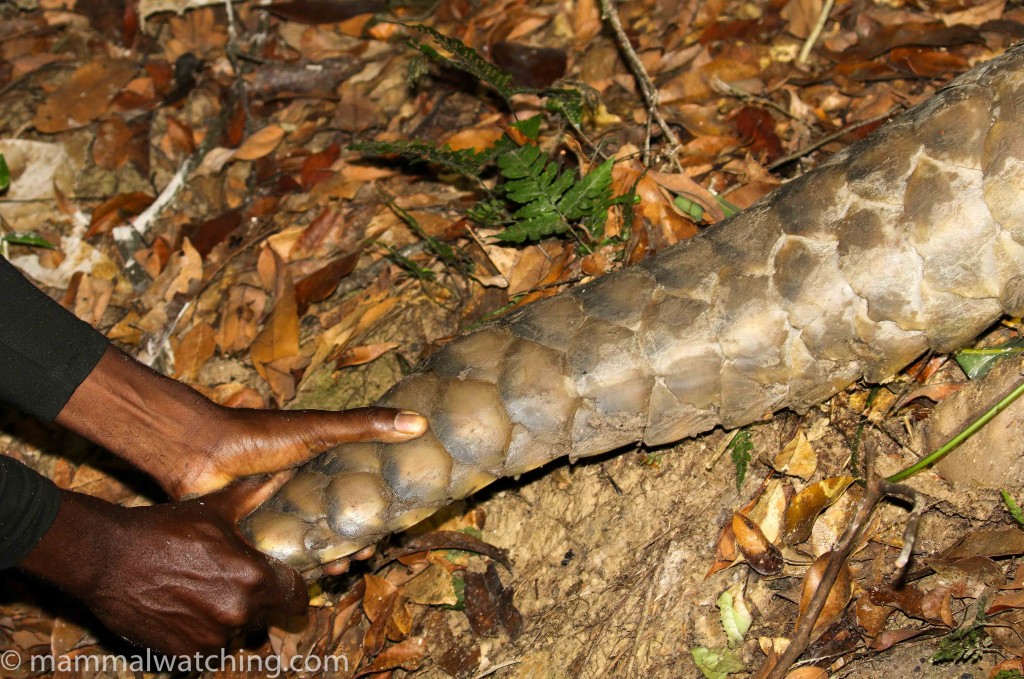
Giant Pangolin, Smutsia gigantea
And then we saw a second animal at Tsam Tsam. In some ways I wish we hadn’t. There was me thinking that we were especially lucky … apparently Giant Pangolins are ten a penny! In fact they are extremely rare at Tsam Tsam. From what I could tell neither of the lodge owners (one of whom has lived his whole life in the area) had seen one there before. They don’t spend much time walking at night but all the same….
All this, coupled with David Lehman’s plans to radio collar a Giant Pangolin in late 2018, mean that Gabon has got to be the best bet going to see a Giant Pangolins right now. I will be really interested to see if this is as reliable an area as I hope it is.
19. African Palm Civet, Nandinia binotata
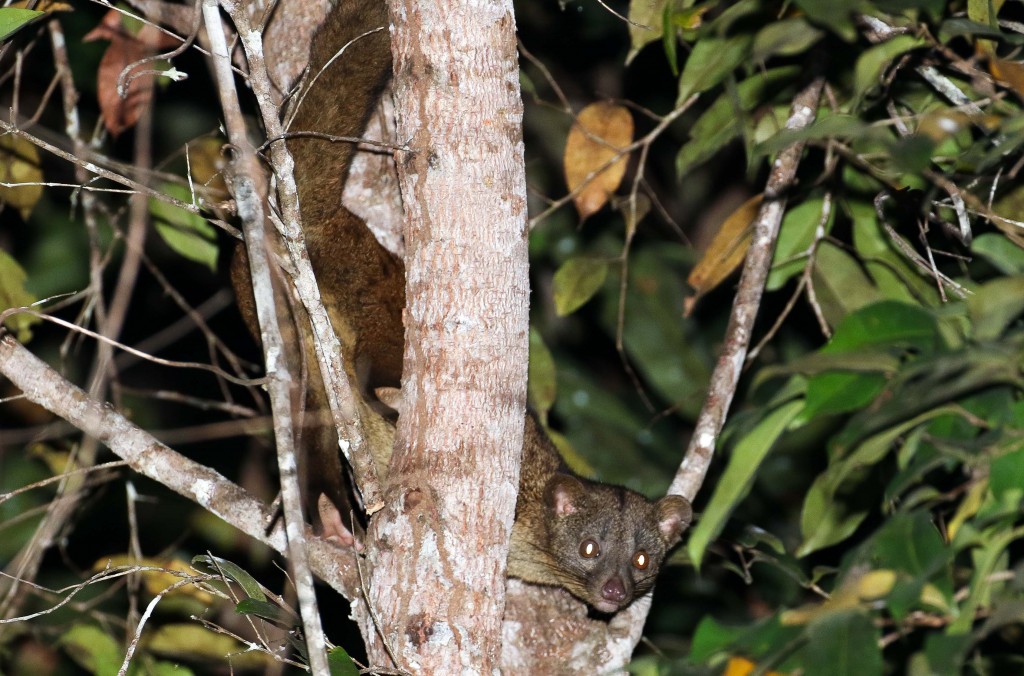
African Palm Civet, Nandinia binotata
A pretty common species. Animals seen most if not all nights in Lope, Mikongo and Tsam Tsam.
20. Spotted-necked otter, Hydrictis maculicollis ¹ ²
Kevin and Sjef were the only people who briefly saw an otter near a bridge on the road close to Mikongo Village. On the basis of size it seems most likely Spotted-necked though might have been Congo Clawless.
21.Rusty-spotted (Panther) Genet, Genetta maculata
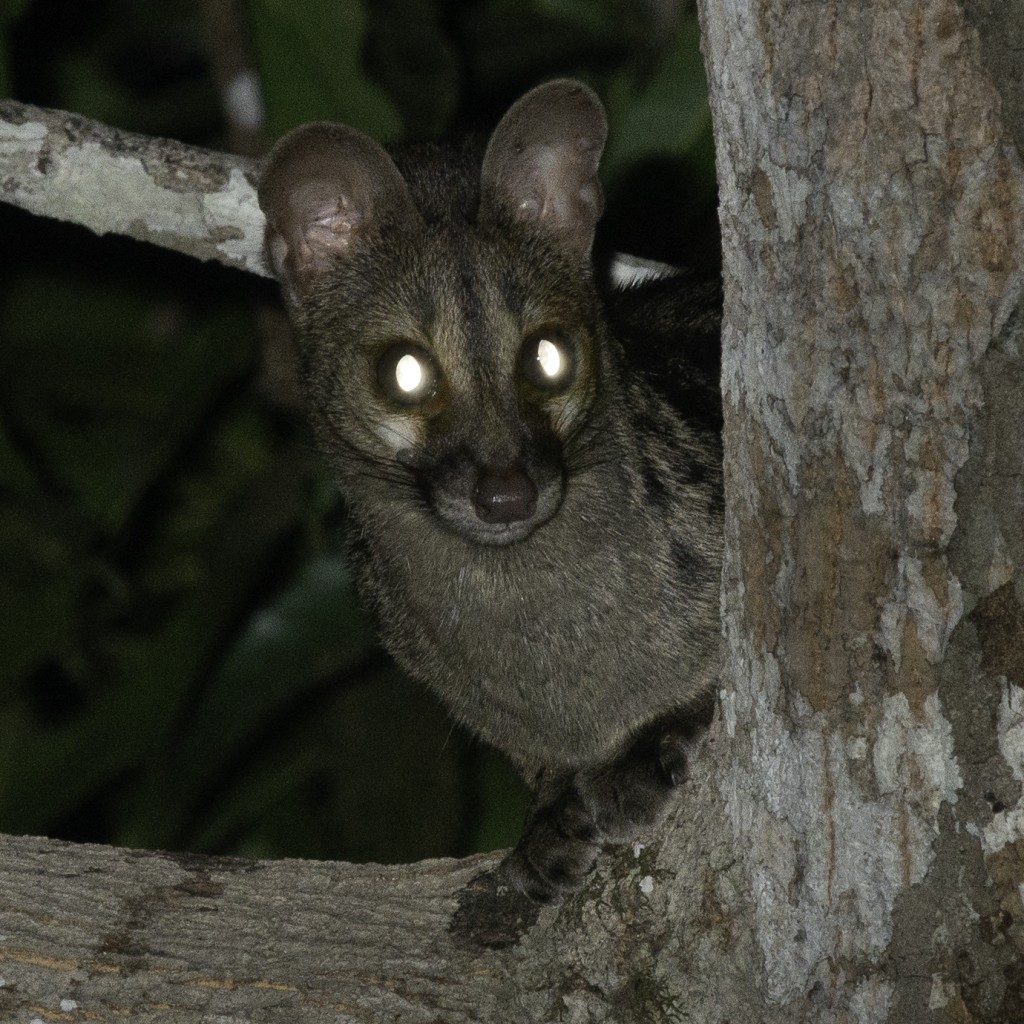
Rusty-spotted Genet, Genetta maculata. Photo Paul Carter.
Some people had partial views of genets in the grounds of the Lope Hotel that were probably this species. During a Tsam Tsam spotlighting session from the speedboat we had a good look at one walking by the edge of the water.
22. F Servaline Genet, Genetta servalina
We saw a Servaline Genet trotting along the road through a patch of Lope savannah two nights running. Beautiful things, and long-legged for a genet. Almost like… like a Serval… d’uh.
23. Leopard, Panthera pardus
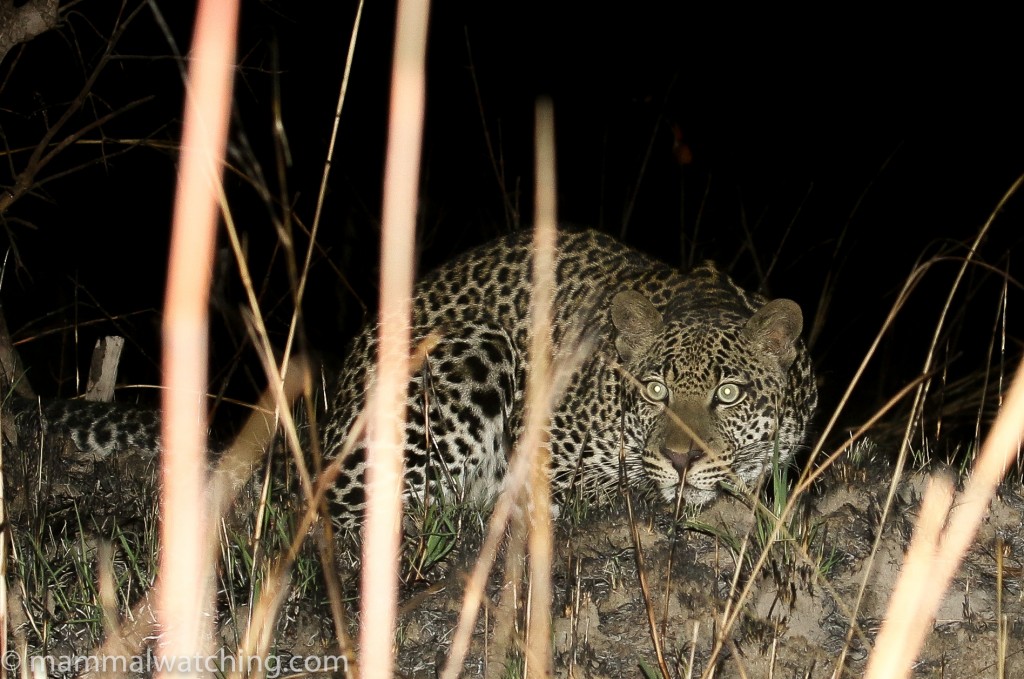
Leopard, Panthera pardus
A pair of animals and cubs had arrived in Lope about the same time we did and were hanging out along the road and apparently trying to eat Mandrills. We saw animal(s) three out of four nights. These were the first Leopards David Lehmann had seen in the park and he thought their presence had caused his Mandrill troop to divide in two.
24. Marsh Mongoose, Atilax paludinosus
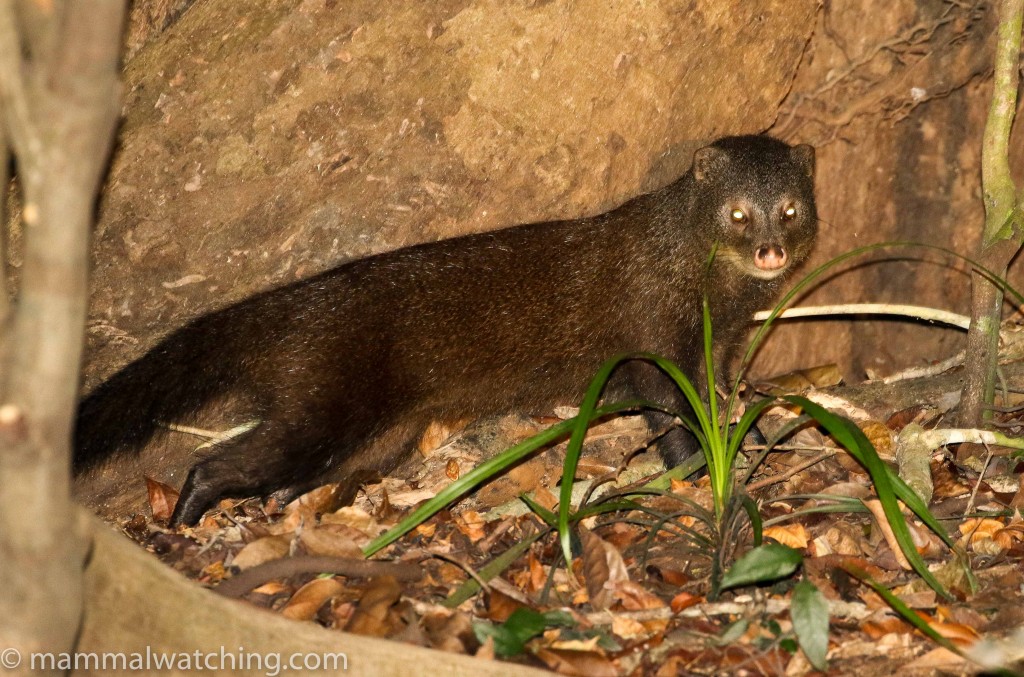
Marsh Mongoose, Atilax paludinosus
Many of us saw a Marsh Mongoose briefly in Lope running through the savanna one night. We also had fabulous and prolonged looks at one close to the water’s edge during a Tsam Tsam night boat tour: my first good look at this species. We also saw what was probably another animal during our other night boat trip.
25. Egyptian Rousette, Rousettus aegyptiacus
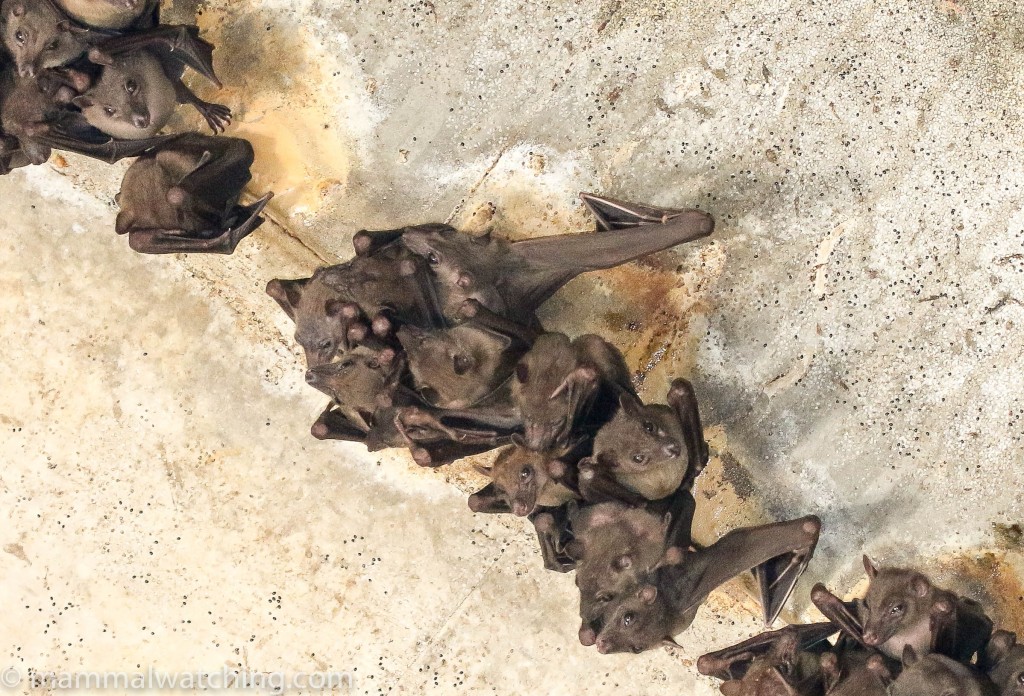
Egyptian Rousette, Rousettus aegyptiacus
A large colony under the bridge at Lambarene, and an even larger colony in a well-known cave near the Lope Hotel. We also saw a few at night feeding around Tsam Tsam lodge.
26. Hammer-headed Fruit Bat, Hypsignathus monstrosus
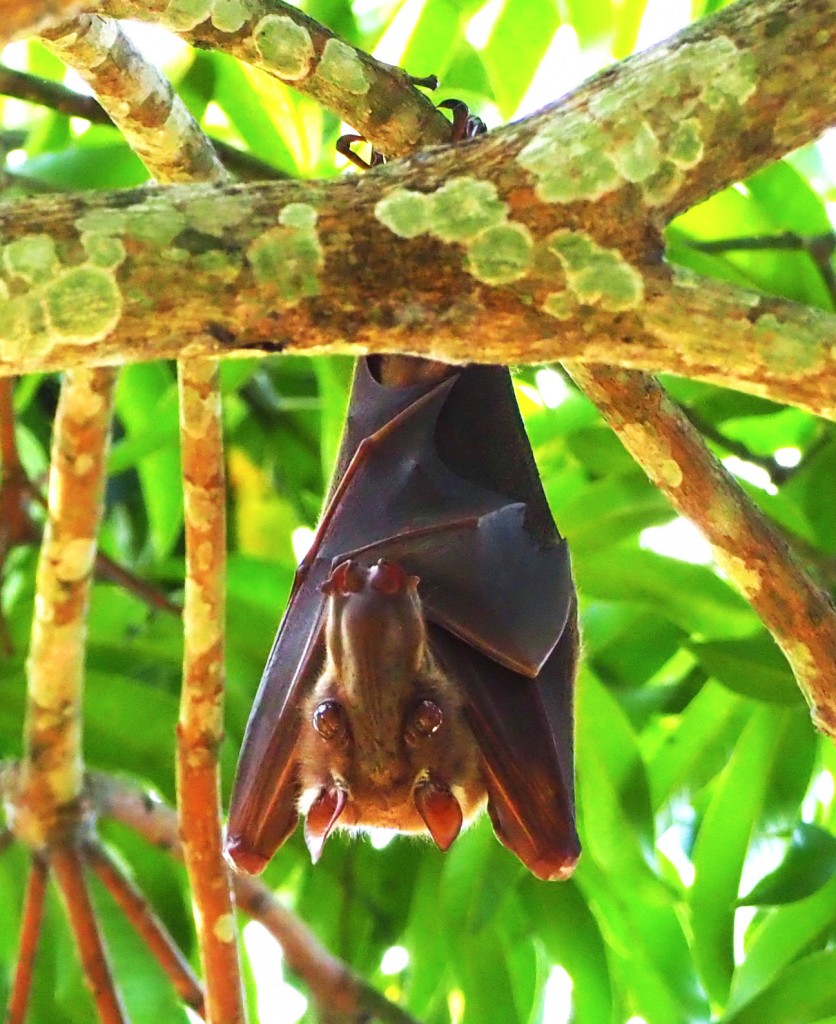
Hammer-headed Fruit Bat, Hypsignathus monstrosus. Photo Venkat Sankar.
We saw at least one in the forest at Lope (David said they were annoyingly loud by his house in Lope most nights). Another (above) was roosting in the day time at the hospital in Lambarene. They were common around the lodge at Tsam Tsam.
27. F Franquet’s Epauletted Bat, Epomops franqueti
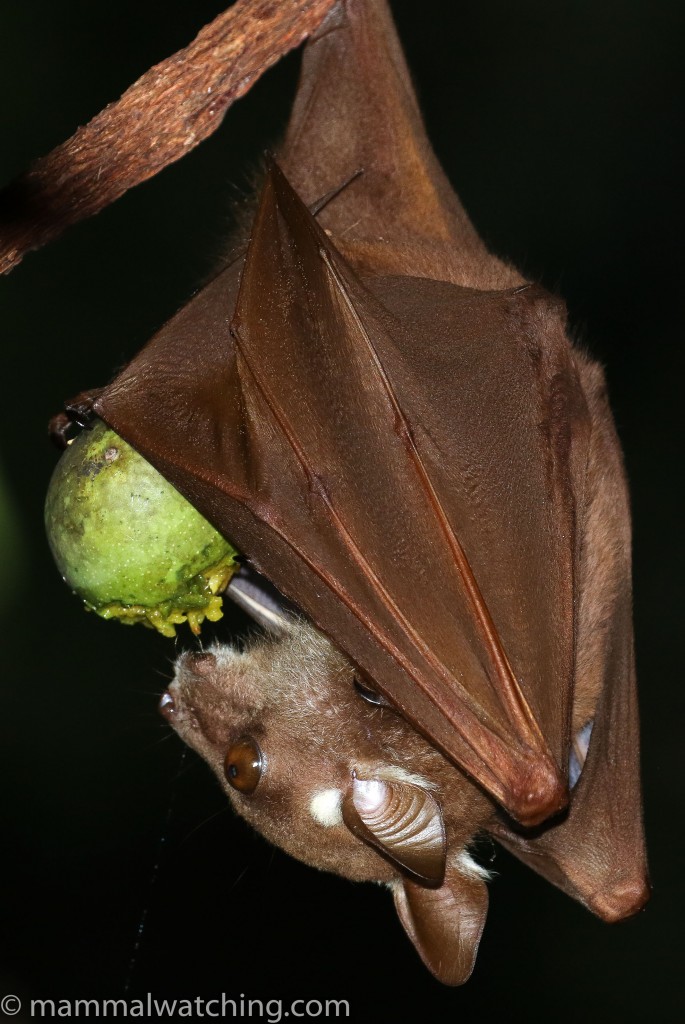
Franquet’s Epauletted Fruit Bat, Epomops franqueti
Great views of an animal feeding in a forest patch at Lope (with the ID confirmed by Afribats). Venkat saw another in Mikongo near camp.
28. F Peters’ Dwarf Epauletted Fruit Bat, Micropteropus pusillus
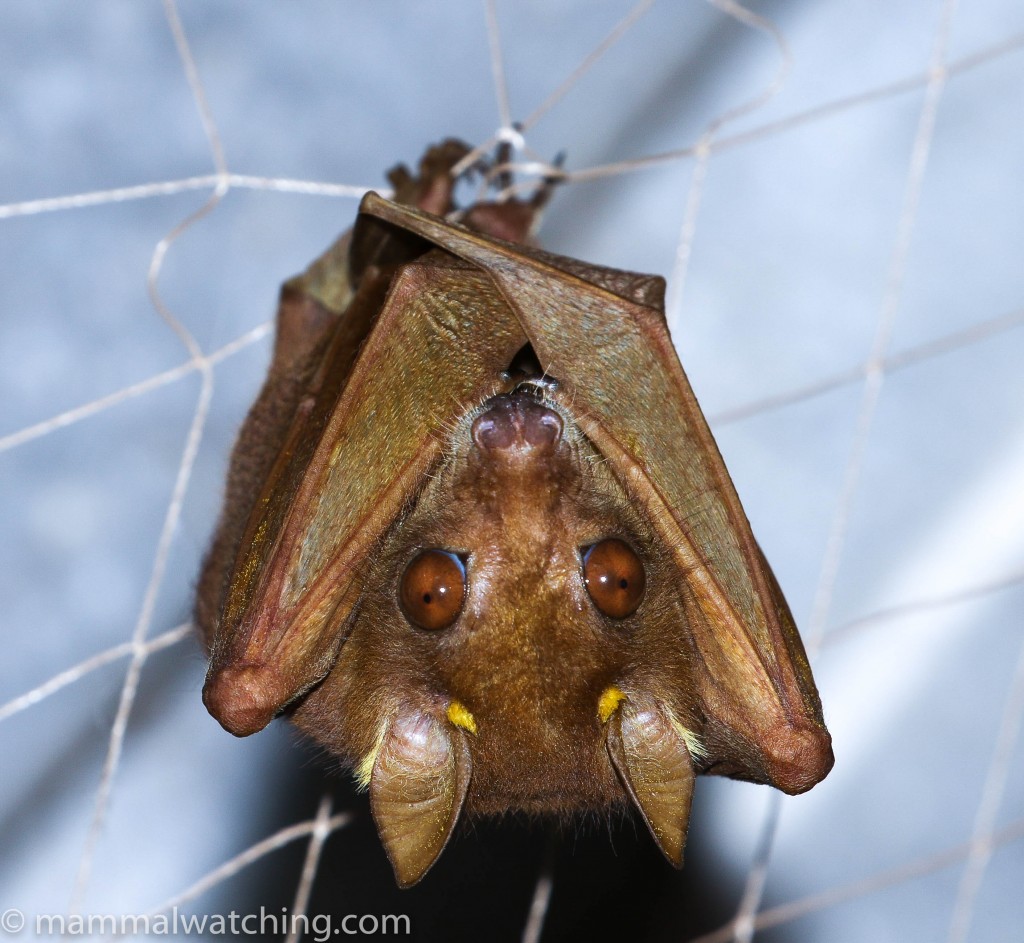
Peter’s Dwarf Epauletted Fruit Bat, Micropteropus pusillus
These small bats are common at the Lope Hotel where they hang from the ceiling of the dining room and under most of the eaves of the rooms. ID confirmed by Afribats.
29. F Benito Roundleaf Bat, Hipposideros beatus
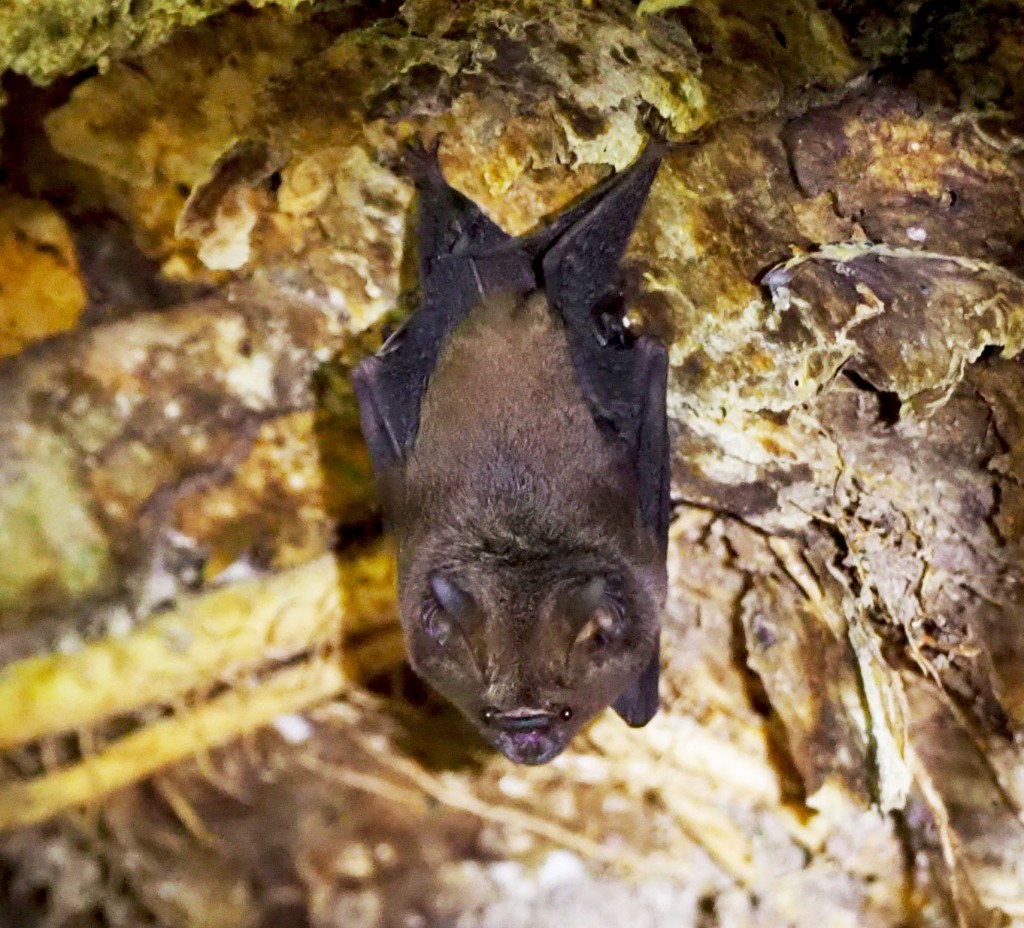
Benito Roundleaf Bat, Hipposideros beatus, Photo Venkat Sankar.
Most of the group saw a couple of these bats roosting inside a hollow tree in Lope. Smaller than the Cyclops Roundleaf Bat and typically roosting alone or pairs. ID confirmed by Afribats.
30. F Cyclops Roundleaf Bat, Hipposideros cyclops
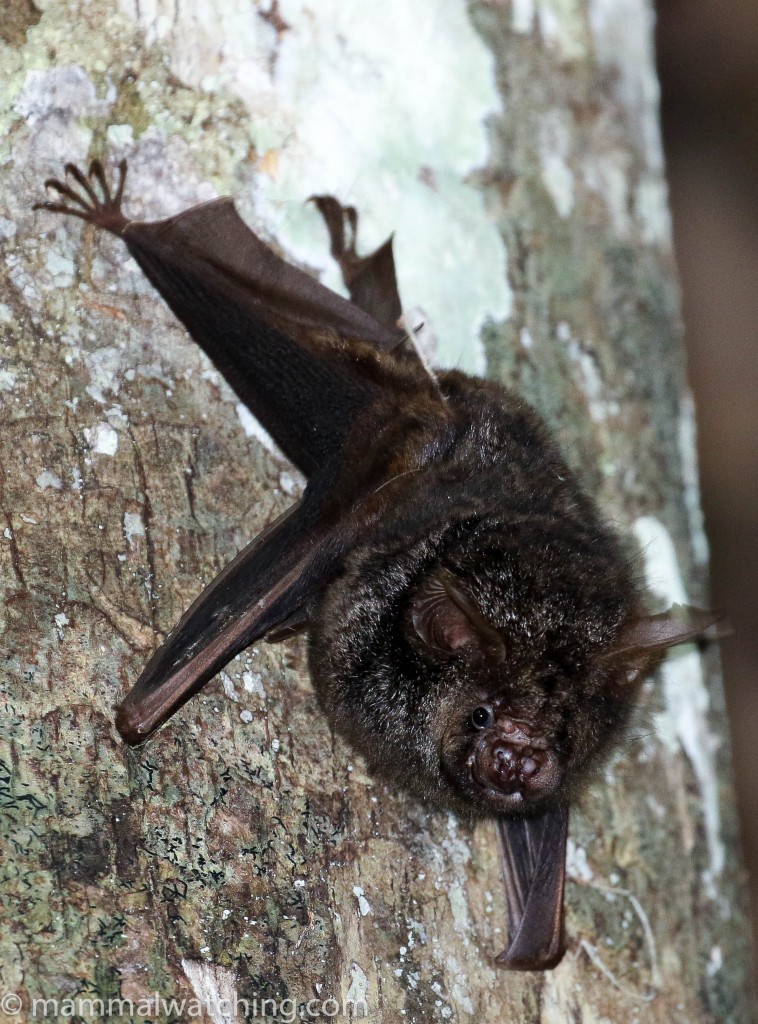
Cyclops Roundleaf Bat, Hipposideros cyclops
We spotted one of these large hipposideros bats with the heat scope perched on a tree trunk at night in Lope and found small colonies inside hollow trees in both Lope and Mikongo (though I would have sworn some animals were much smaller than others). ID confirmed by Afribats.
31. Slit-faced Bat species
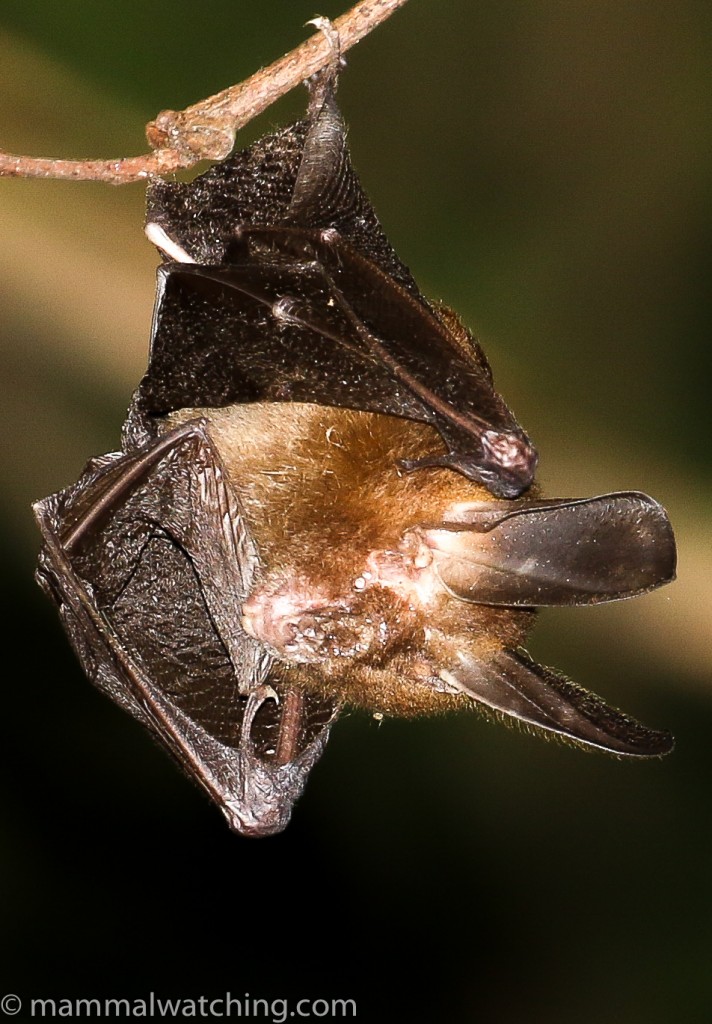
Slit-faced Bat, Nycteris species, Mikongo Camp.
One animal (above) hanging from a branch in Mikongo at night near camp, and others (a different species I suspect) roosting in a hollow log at Lope (below), and high in a hollow tree at Tsam Tsam. Unfortunately we were not able to ID them to species level without precise measurements.
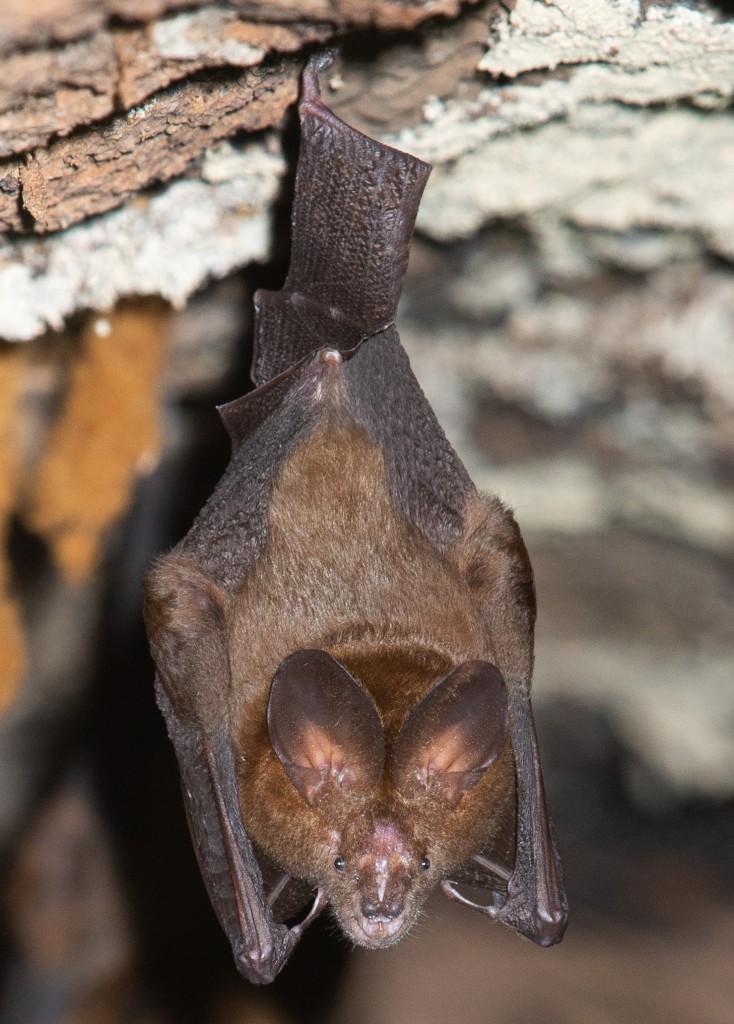
Slit-faced Bat, Nycteris species, Lope National Park. Photo Paul Carter.
32. F Mops Freetailed Bat Species
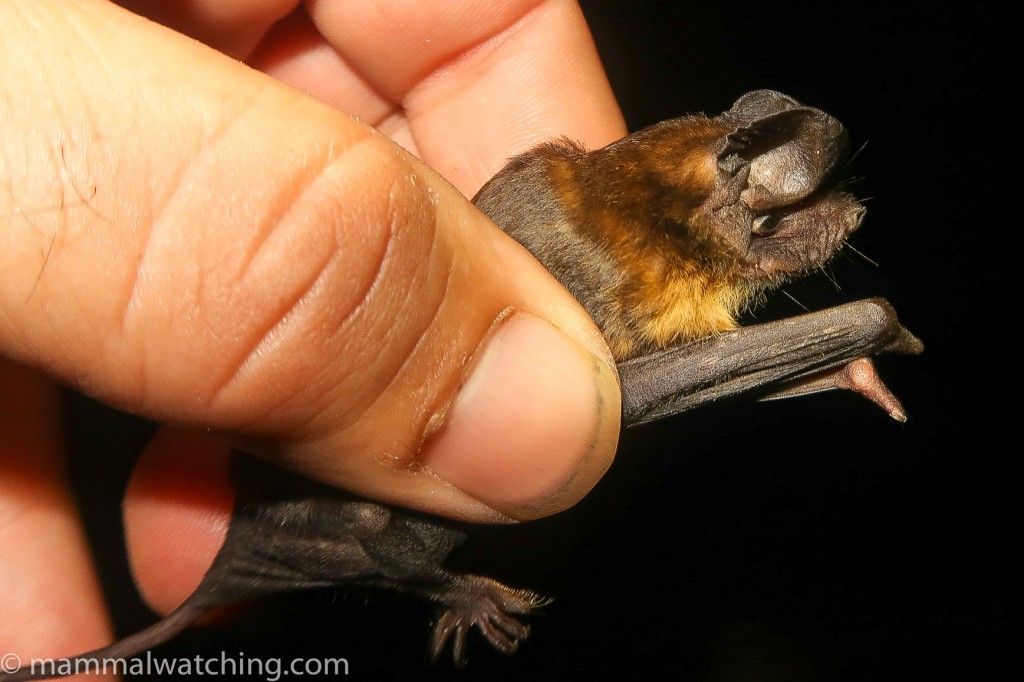
Freetailed Bat, Mops species
We caught this colourful freetailed bat at Mikongo It had a forearm of 38mm. But even with measurements the ID could not be confirmed by Afribats (we would need to have taken detailed measurements of gaps between various teeth to have been sure). It was likely either a Railer Freetailed Bat (Mops thersites) or a Sierra Leone Freetailed Bat (Mops brachyprterus). As I have seen neither I claimed a lifer.
33. Milne-Edwards’s Potto, Perodicticus edwardsi
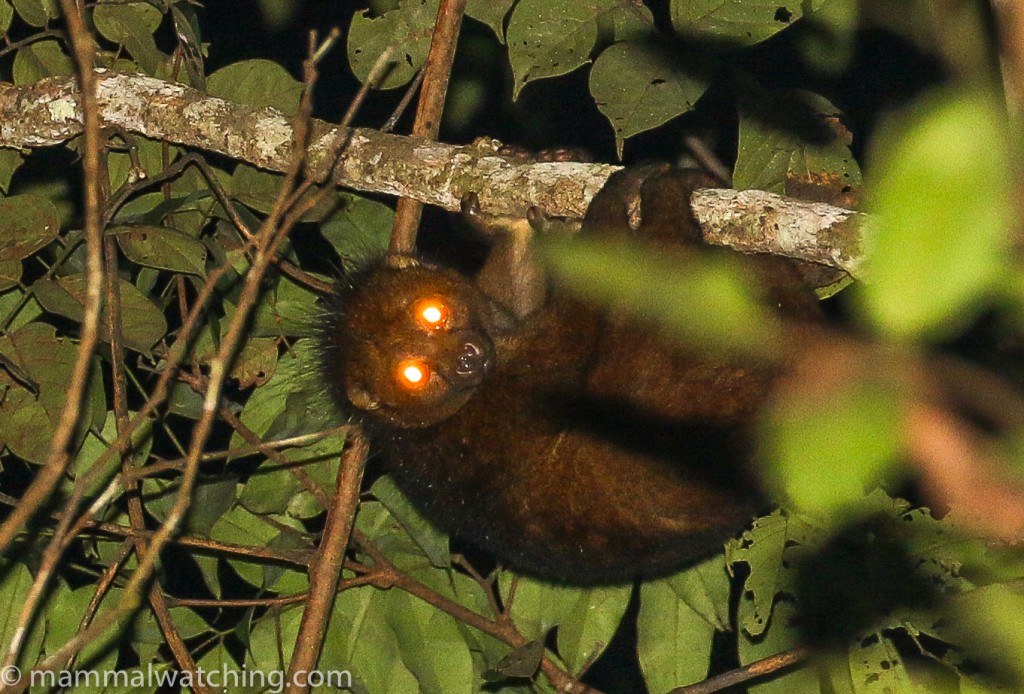
Milne Edwards’s Potto, Perodicticus edwardsi
We saw pottos twice at Mikongo along the trail to the river.
34. F Makandé Squirrel Galago, Galago makandensis
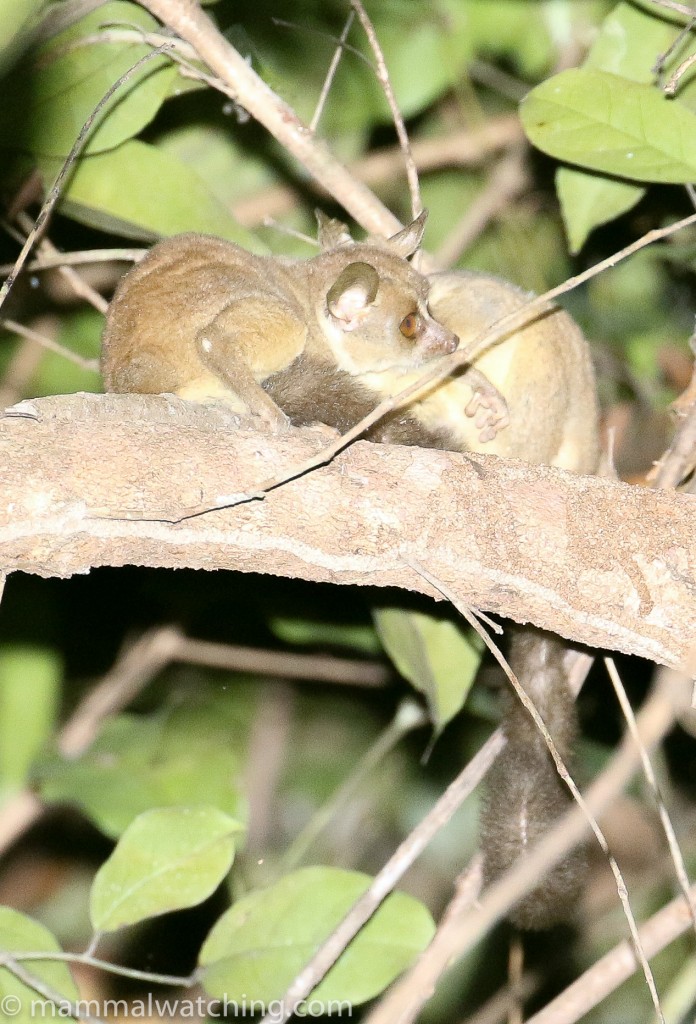
Makandé Squirrel Galago, Sciurocheirus makandensis
We saw squirrel galagos twice in Lope during night drives. One night we had a family group huddled up on a branch not long after sunset (above). On another night we watched several moving through the trees. They move quite differently to Demidoff’s Galago. Squirrel Galagos move like squirrels (no shit)… Demidoff’s leap so fast they appear to be able to teleport. This species is a recent split from the larger, more brightly coloured Gabon Squirrel Galago.
35. Demidoff’s Galago, Galagoides demidoff
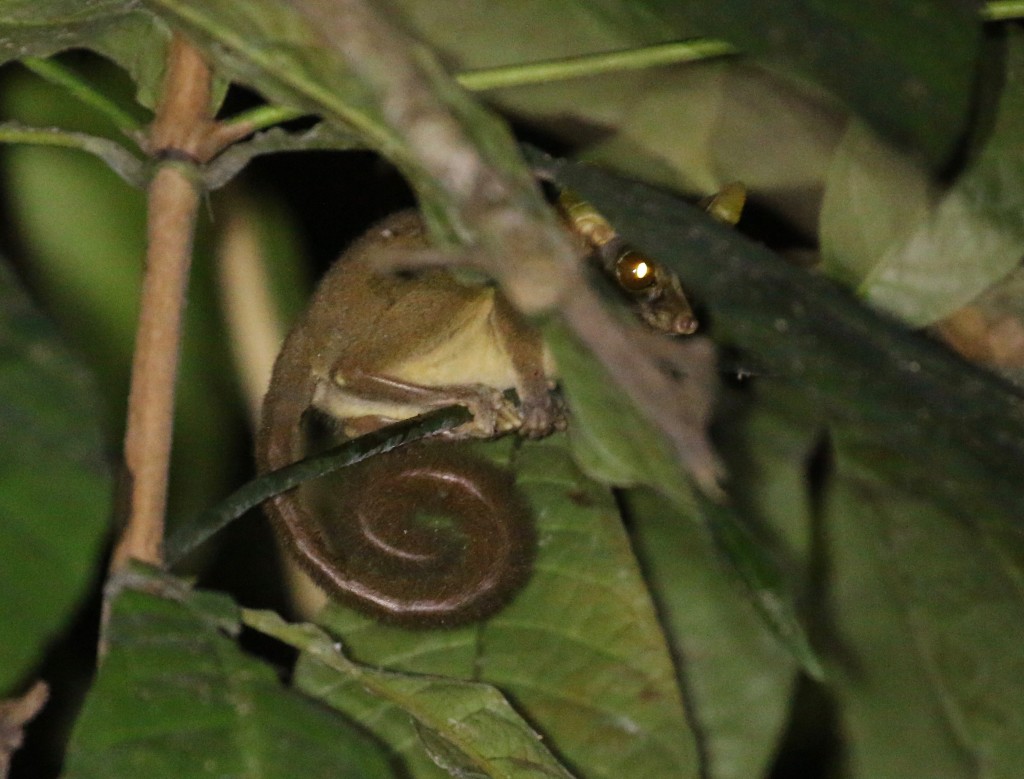
Demidoff’s Galago, Galagoides demidoff. Photo Sjef Ollers.
Seen twice in Lope during night drives. Once in Tsam Tsam from the boat at night. Presumed to be this species, rather than the very similar Thomas’s Galago because they were low in the canopy. I don’t remember hearing them call which is a more reliable diagnostic between the two species.
36. F Black Colobus, Colobus satanas
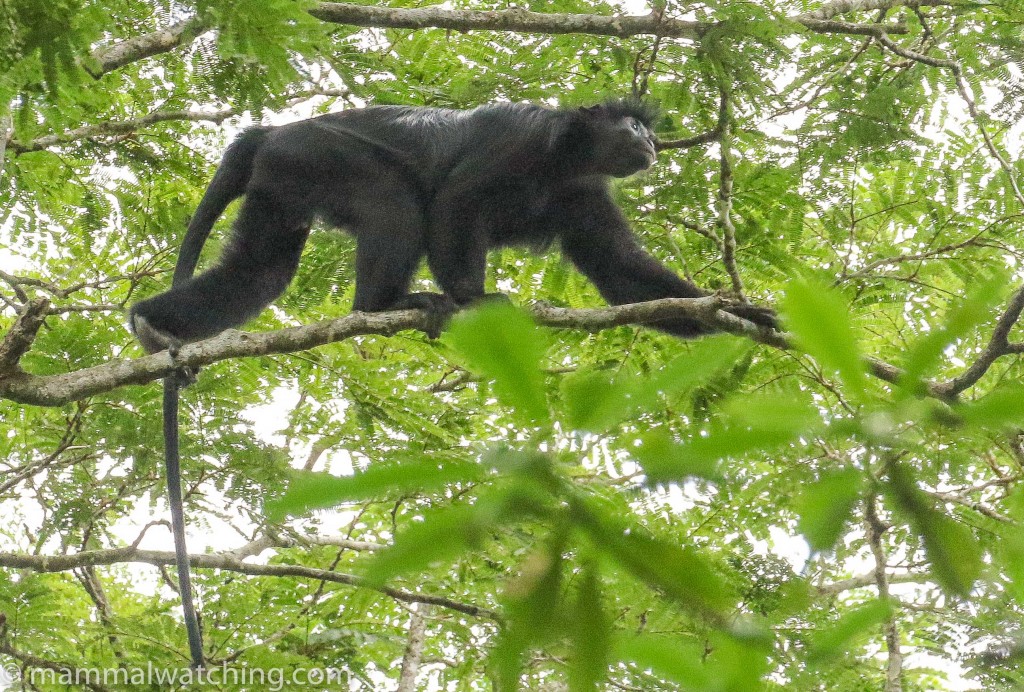
Black Colobus, Colobus satanas
Quite common in Lope and Mikongo: we saw them most days, though often hard to get good looks at. A peculiar looking primate and one that is apparently now very rare outside of Gabon.
Their faces are a mixture of Dobby the House Elf and a psycho clown.
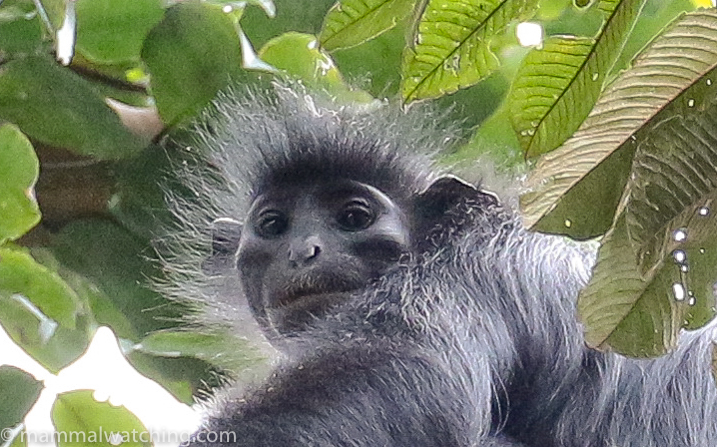
Black Colobus, Colobus satanas
37. F Mandrill, Mandrillus sphinx
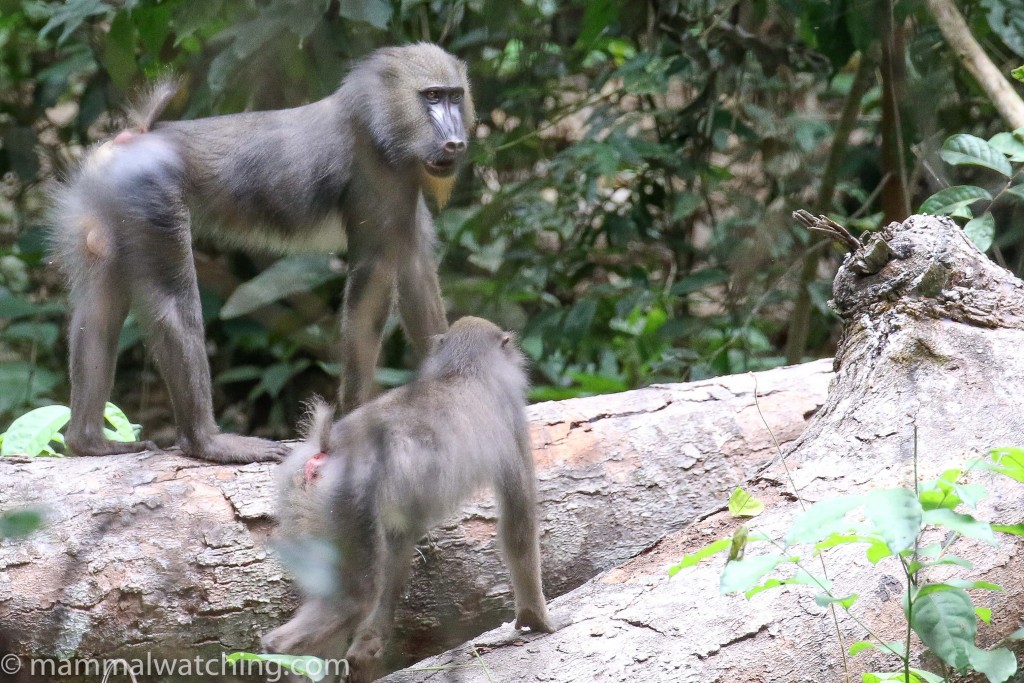
Mandrill, Mandrillus sphinx
Pretty much guaranteed at Lope if you go out radio tracking with David Lehmann. Though there are tens of thousands of others in the park beyond his troop of 1000+ animals. We saw more Mandrills on the side of the road near Mikongo Village. But they disappeared very quickly when we stopped the car and tried to follow them on foot.
38. F Red-capped Mangabey, Cercocebus torquatus
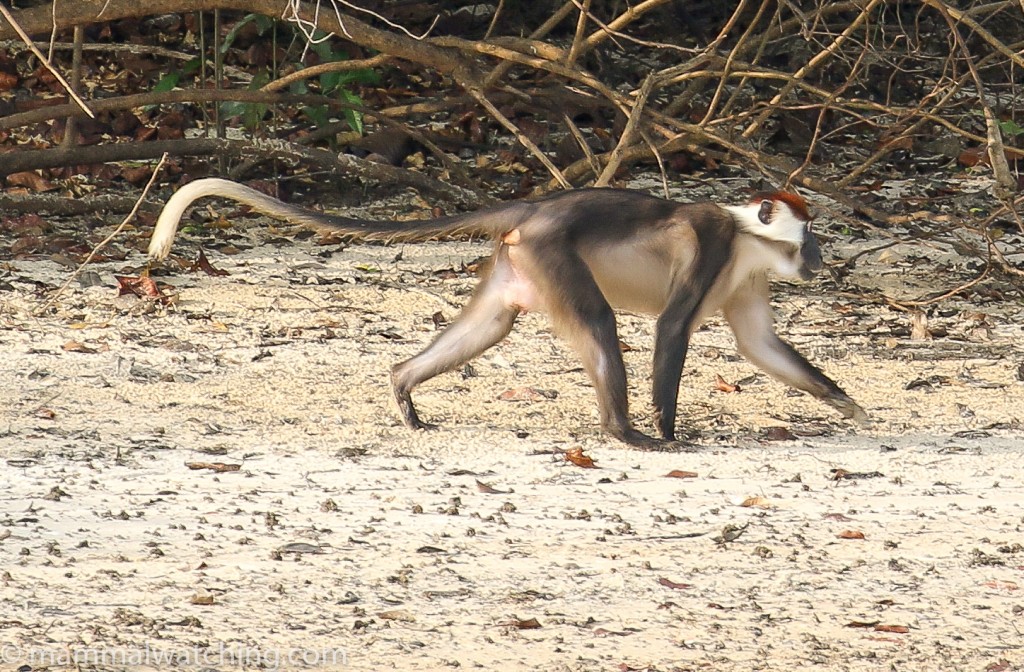
Red-capped Mangabey, Cercocebus torquatus
It took us 24 hours to see one at Tsam Tsam, though we should have seen them more quickly given how common they are there, particularly along beaches in the late afternoons.
39. Grey-cheeked Mangabey, Lophocebus albigena
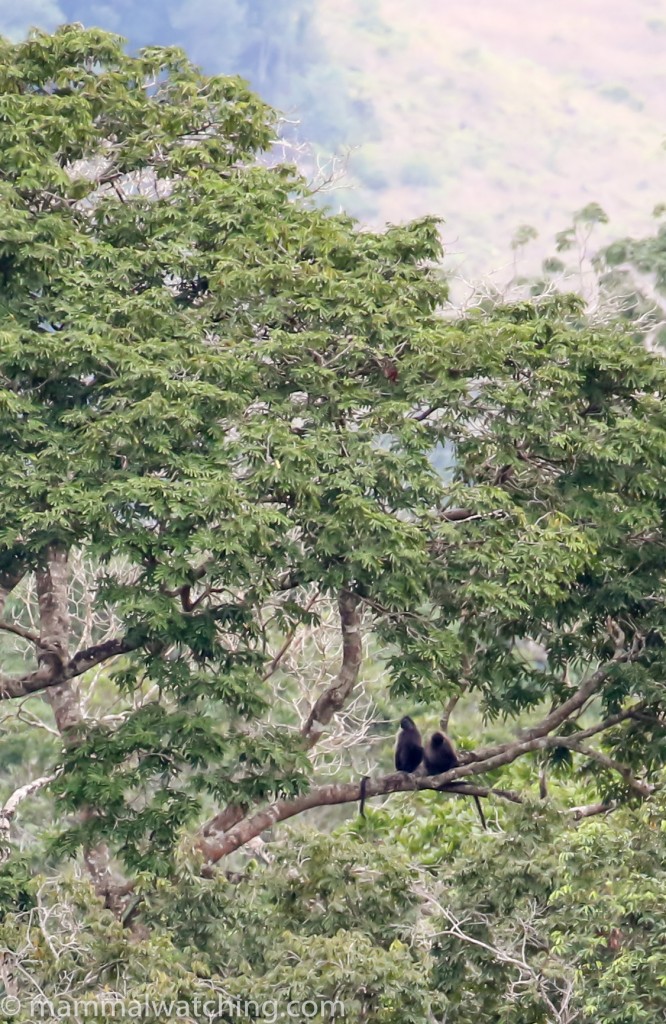
Grey-cheeked Mangabey, Lophocebus albigena
Seen nearly every day in Lope and Mikongo though usually quite distantly.
40. Moustached Monkey, Cercopithecus cephus
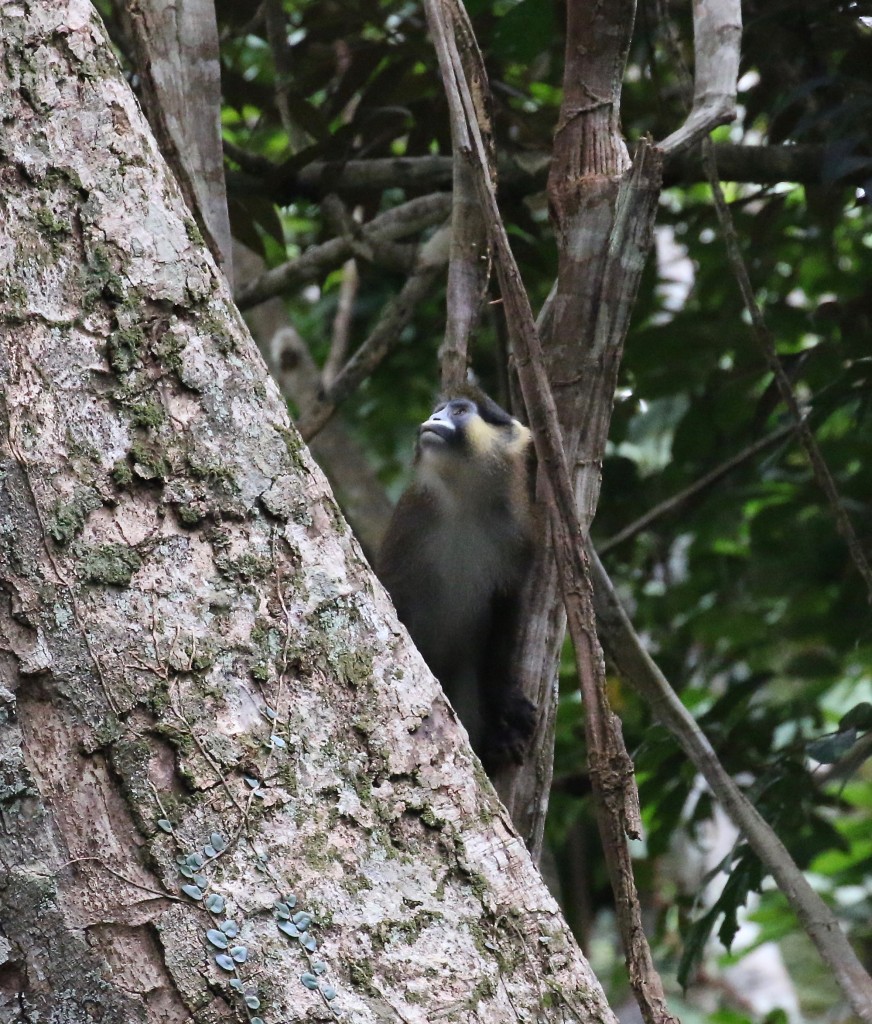
Moustached Monkey, Cercopithecus cephus. Photo Sjef Ollers.
The most commonly seen primate of the trip and I guess the most often seen mammal. Seen just about every day everywhere.
41. Greater Spot-nosed Monkey, Cercopithecus nictitans
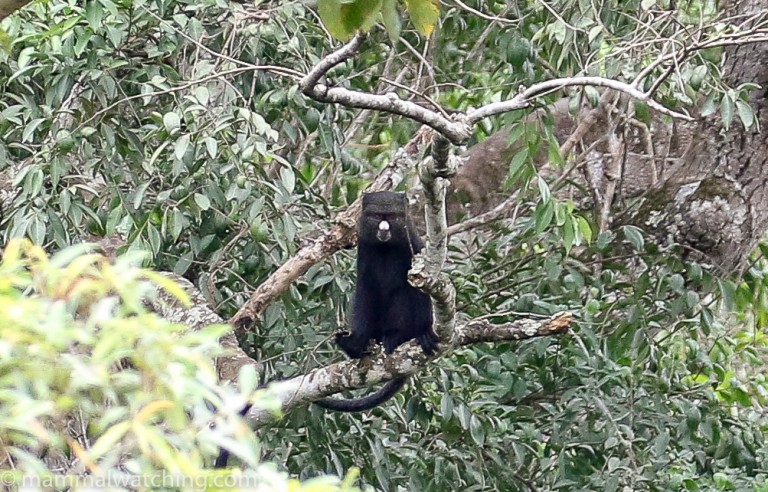
Putty-nosed Monkey, Cercopithecus nictitans
Another commonly seen species that we saw nearly every day in Lope, Mikongo and Tsam Tsam.
42. Crowned Monkey, Cercopithecus pogonias
This was one of the harder monkeys to see. They are quite scarce in Lope and we didn’t see them there. We did see them along the road at Mikongo and again – for longer – at Tsam Tsam.
43. F Sun-tailed Monkey, Cercopithecus solatus

Sun-tailed Monkey, Cercopithecus solatus. Photo Sjef Ollers.
This was a nice bonus. Although they are not around Mikongo Camp they are quite common along the road south from Mikongo Village. We came close to seeing some while walking through dense bush, but I think driving the road is the best way to spot this shy monkey. They live close to the ground and seem to descend when nervous. We saw three or four groups in an hour while driving the road early one morning.
44. F Northern Talapoin, Miopithecus ogouensis
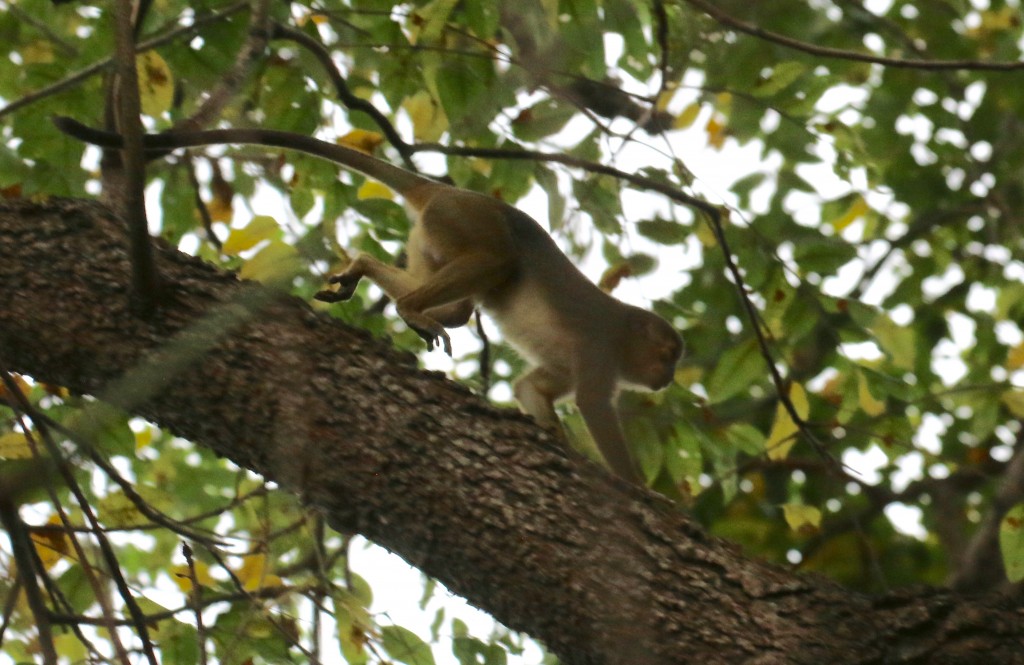
Northern Talapoin, Miopithecus ogouensis. Photo Sjef Ollers.
Another nice bonus. Reliably seen on a tiny island in Akanda National Park next to Libreville. A small inconspicuous monkey that must be very hard to pin down on anything larger than the minute island we had them confined to!
45. Chimpanzee, Pan troglodytes
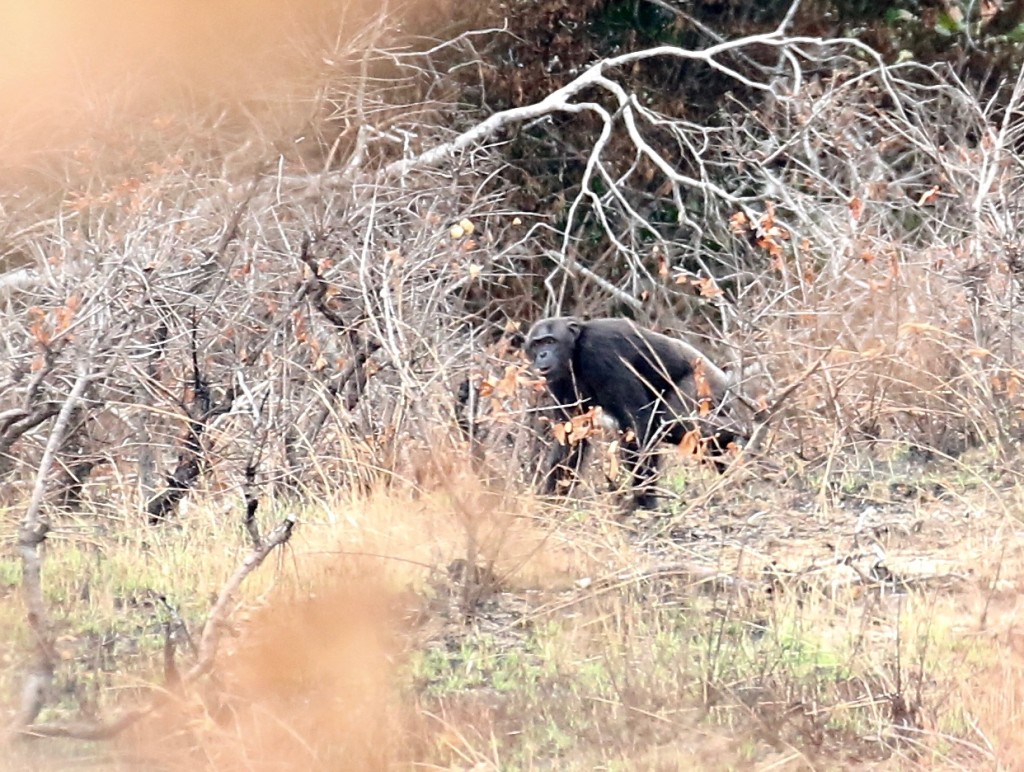
Chimpanzee, Pan troglodytes. Photo Sjef Ollers.
Fairly common in Lope and Mikongo. We made no special effort to see them but saw animals on two separate occasions: once in Lope and once in Mikongo (both times from the road).
46. Western Gorilla, Gorilla gorilla
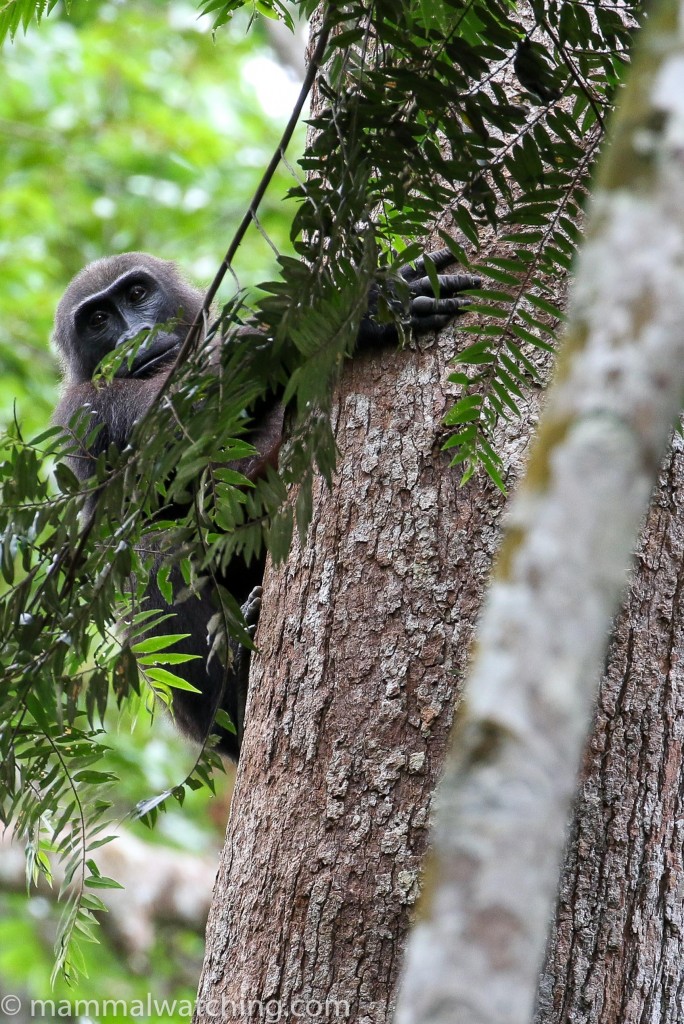
Western Lowland Gorilla, Gorilla gorilla
Another species we ran into twice without making a special effort to do so. In Lope we found a pair of youngsters high in the canopy in a forest fragment. In Tsam Tsam we saw two animals out on the edge of the Savanna (an unusual sighting at Tsam Tsam). We also heard animals right next to our camp at Mikongo which provoked an unplanned hike in search of them through the forest. Top Tip: no matter the urgency, do not hike through Mikongo in flip flops and shorts … it took six weeks for the bug bites to heal. We saw sign of Gorillas many times.
47. F Red River Hog, Potamochoerus porcus
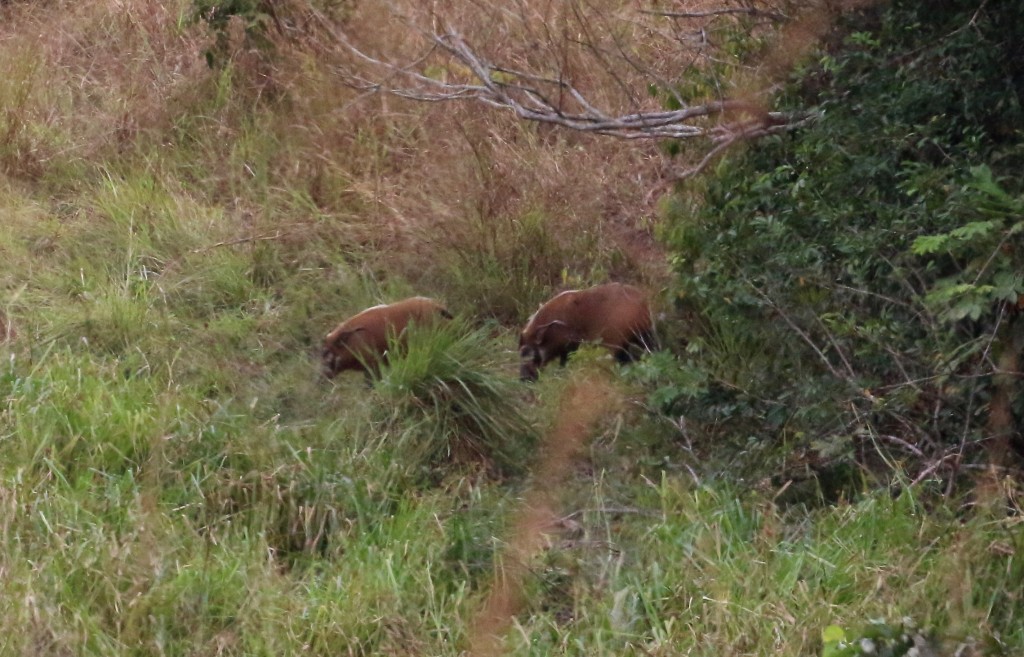
Red River Hog, Potamochoerus porcus. Photo Sjef Ollers.
Not uncommon in Lope or Mikongo but quite hard to get good views of. We saw them several times in the forest as a flash of stampeding pork. Slightly better views at night with the thermal scope. But great views out in the open one morning from the road in Lope. The pigs tend to stay in the cover of the trees but sometime feed in the open marshy areas early or late in the day. One of the mammals of the trip for me: truly – as many Gabonese coffee table tourism books say – “the world’s most beautiful pig”. Ivindo seems to be a better place to see this species.
48. Hippopotamus, Hippopotamus amphibius
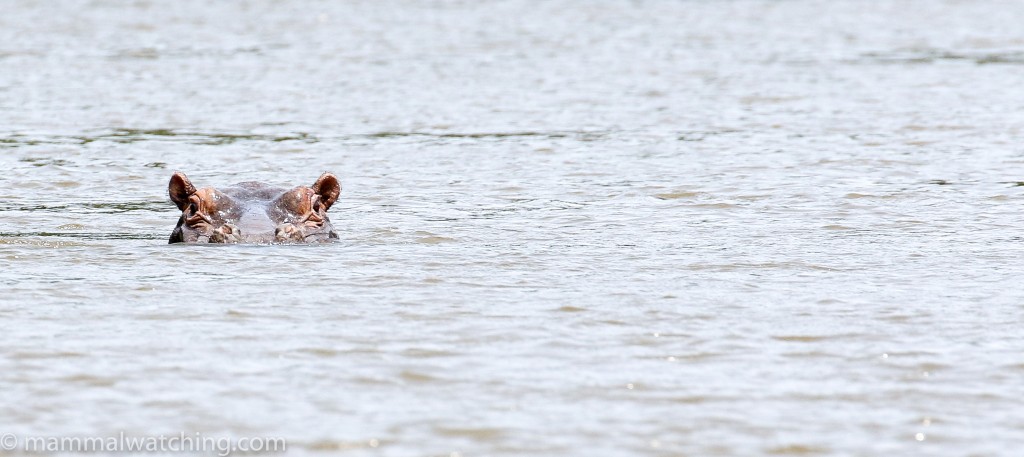
Common Hippopotamus, Hippopotamus amphibius
The river trip to Tsam Tsam was our only chance to see this species, now – through hunting and poaching – rare in Gabon.
49. Water Chevrotain, Hyemoschus aquaticus
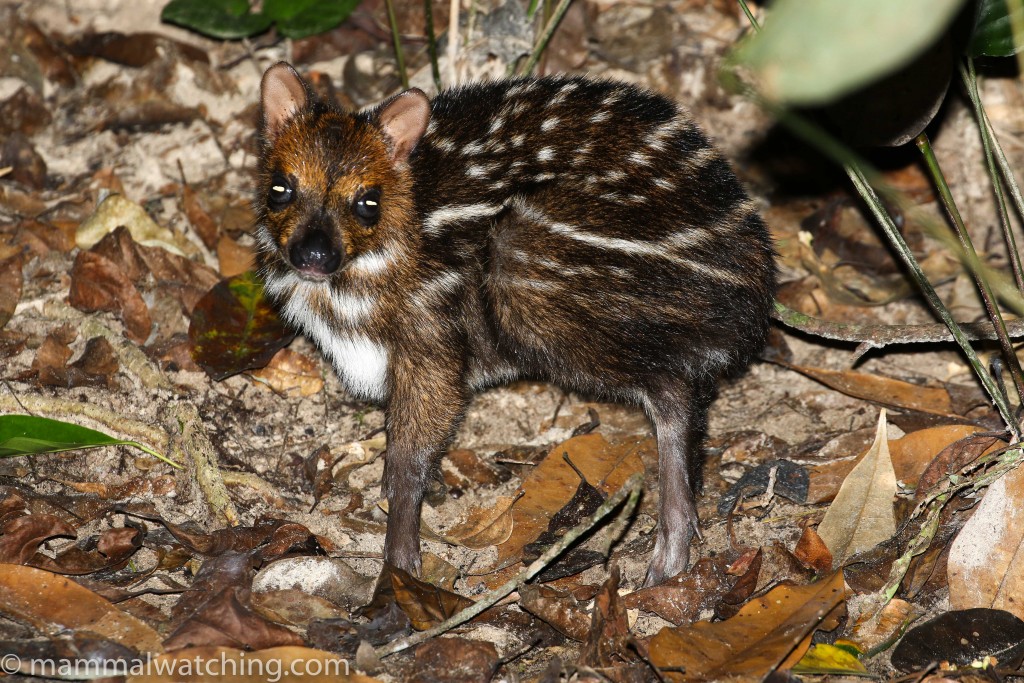
Water Chevrotain, Hyemoschus aquaticus
A stunning encounter with this beautiful mother and her fawn on the river bank opposite camp at Mikongo. We could approach within five metres and she froze at the edge of the river. She was there two nights running. Also quite common at Tsam Tsam near camp we were told.
50. African (Forest) Buffalo, Syncerus caffer
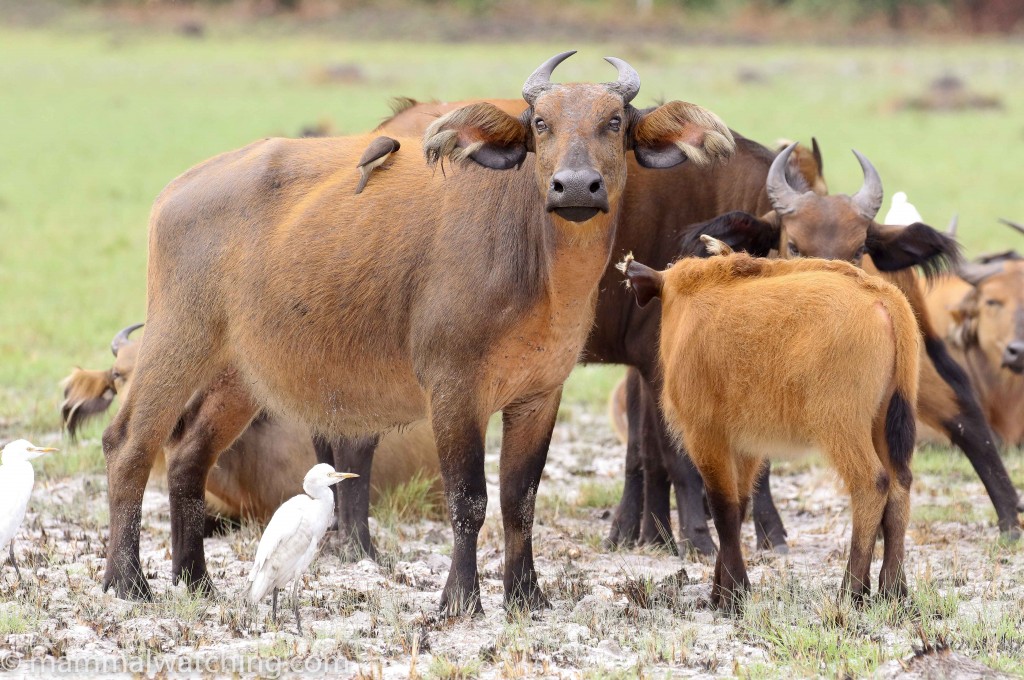
African (Forest) Buffalo, Syncerus caffer
Very common in Lope and Pongara National Parks. Not seen elsewhere.
51. F Western Bushbuck, Tragelaphus scriptus
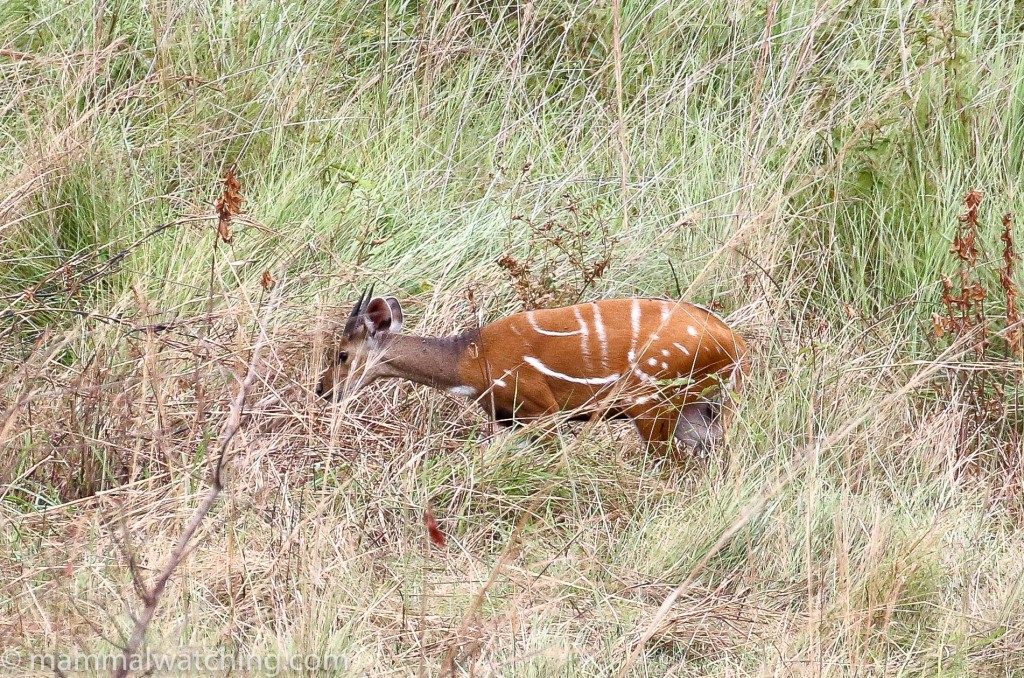
Western Bushbuck, Tragelaphus scriptus
We saw a few in savannah areas of Lope.
52. Sitatunga, Tragelaphus spekii
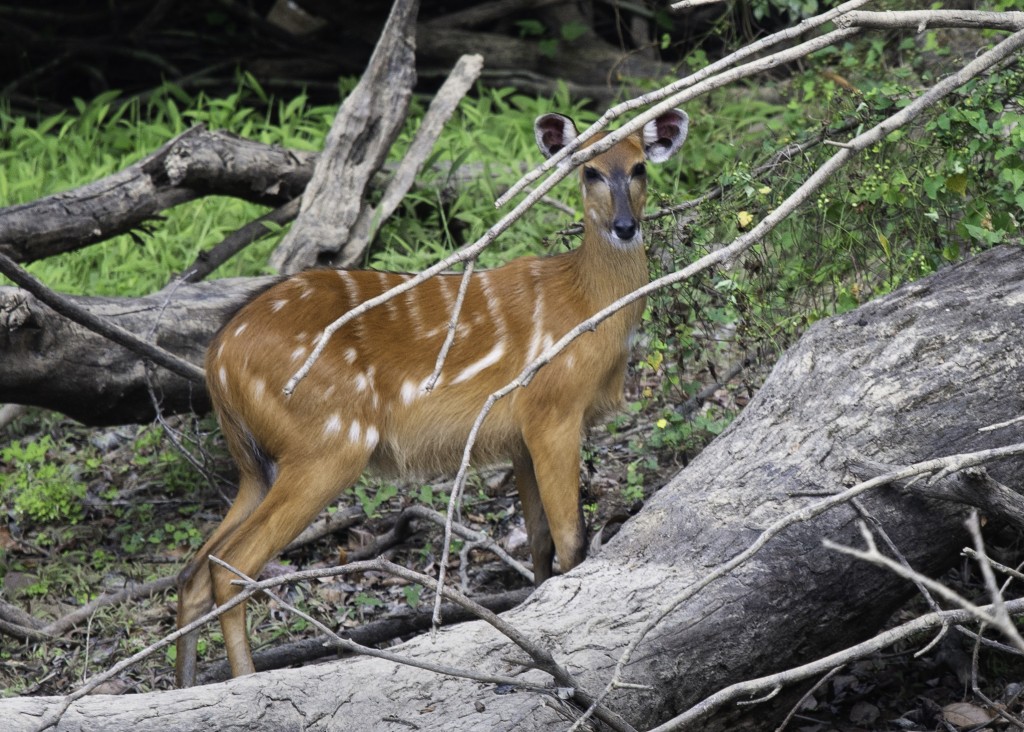
Sitatunga, Tragelaphus spekii. Photo Paul Carter.
We saw two or three from the river at Tsam Tsam.
53. F Peters’ Duiker, Cephalophus callipygus
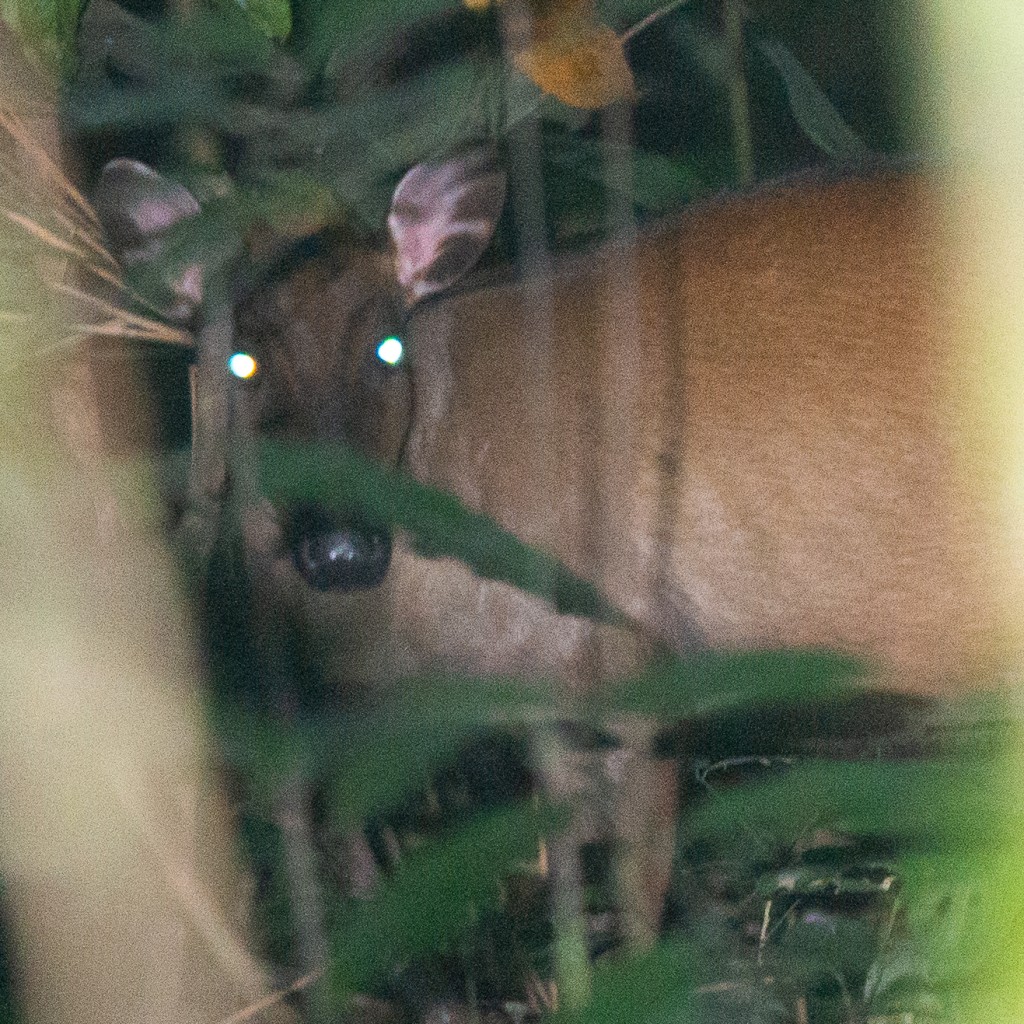
Peters’ Duiker, Cephalophus callipygus. Photo Paul Carter.
It was often hard to get good enough views of duikers to confirm the species, but the thermal scopes helped get onto animals more quickly and even grab (an often bad) photo. We had at least one Peters’ Duiker: notably duller than the richly coloured Bay Duiker and with darker legs than Ogilby’s Duiker.
54. F Bay Duiker, Cephalophus dorsalis
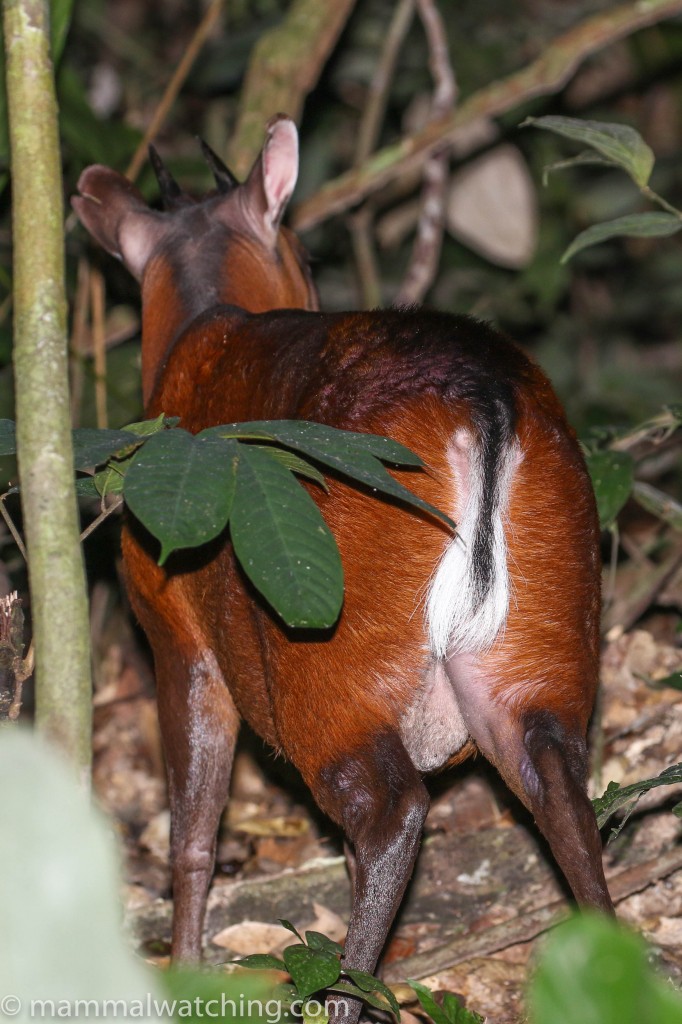
Bay Duiker, Cephalophus dorsalis
We saw several in both Lope and Mikongo, some of which posed long enough for photos such as this one at night in Mikongo. Fabulously coloured.
55. Blue Duiker, Philantomba monticola
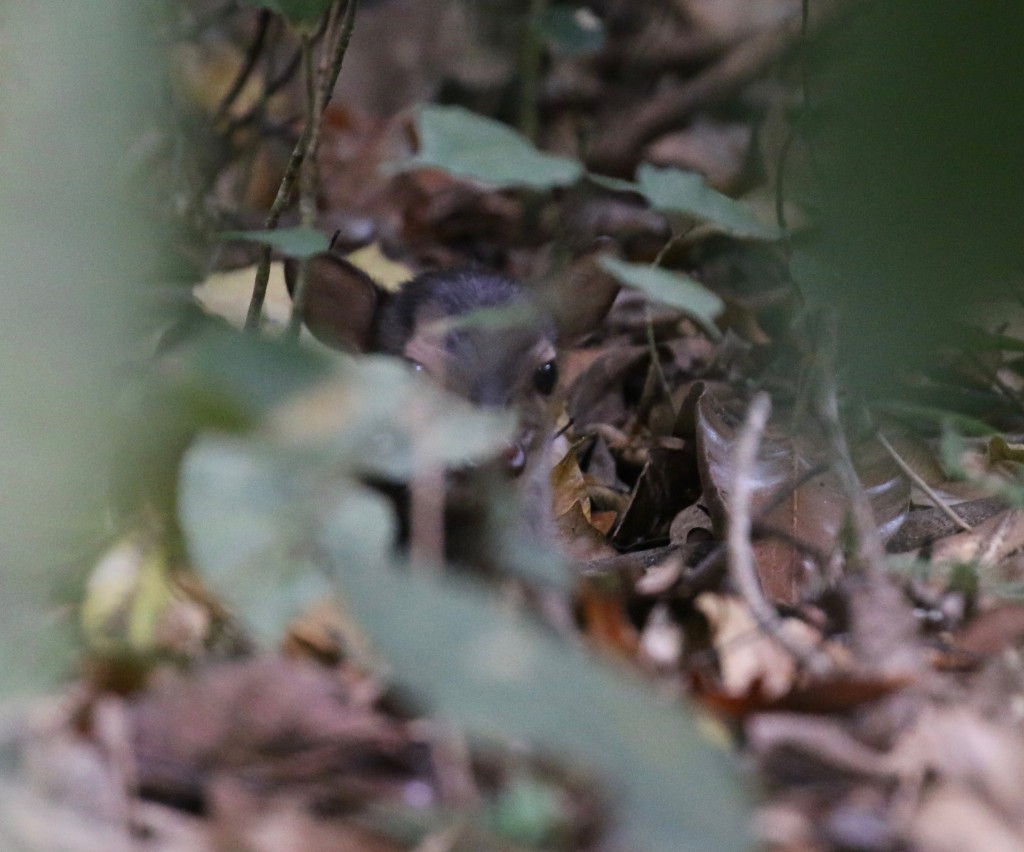
Blue Duiker, Philantomba monticola. Photo Sjef Ollers.
Very common in Lope: using thermal scopes we were spotting 10 – 15 in a mile alongside some stretches of road in Lope. Also quite common in Mikongo. Duiker dung in both parks was everywhere.
56. F Ogilby’s Duiker, Cephalophus ogilbyi
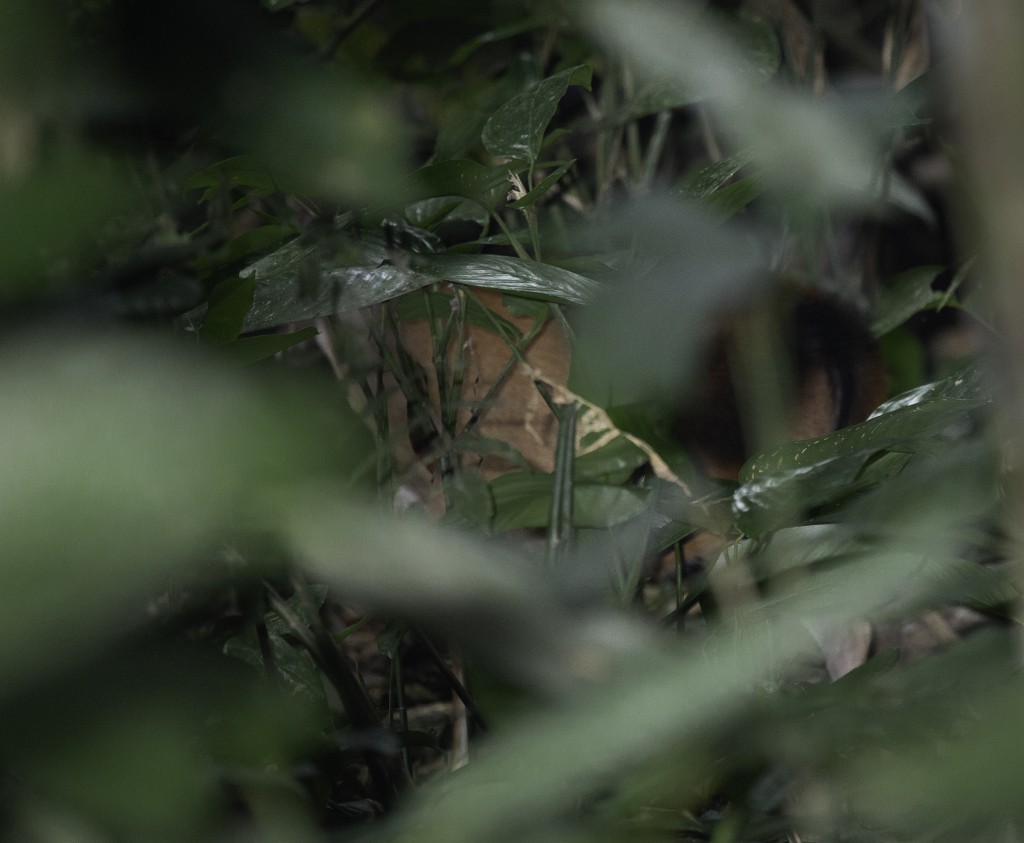
Ogilby’s Duiker, Cephalophus ogilbyi. Photo Paul Carter.
Ogilby’s and Peter’s Duikers both seem less common – or less often seen – than Blue and Bay Duikers in Lope and Mikongo. We only had one confirmed sighting of this species (along the road in Lope at night). The picture, while obviously not great, does at least show the pale inside legs – front and rear – of an Ogilby’s Duiker, along with a pale throat. Pictures, no matter how bad, can be very useful in allaying concerns about the species actually seen. Concerns that keep me up at night!
57. Yellow-backed Duiker, Cephalophus silvicultor¹
One group of Mandrill trackers had a good look at this species in among the Mandrills. David Lehmann said he saw them quite often.
58. African Forest Elephant, Loxodonta cyclotis
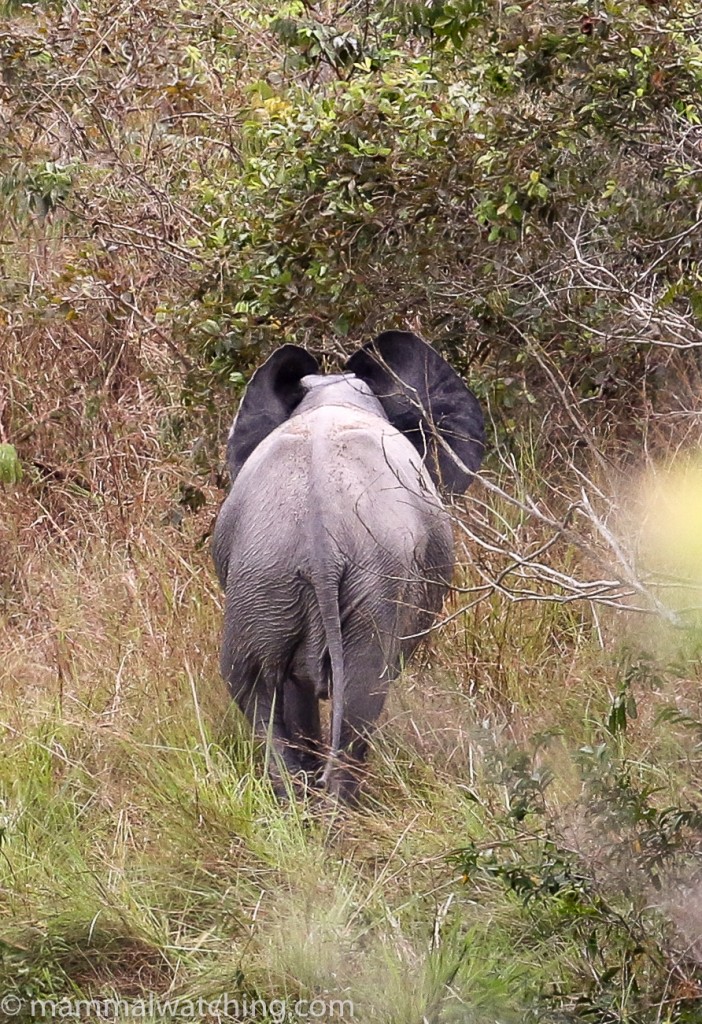
African Forest Elephant, Loxodonta cyclotis
Common in Lope and an animal to be cautious of when walking there in the forest. David Lehmann said he had close encounters with elephants at least once a week, including the day I went Mandrill tracking when we found ourselves within 10 metres of an elephant… cue very hasty retreat. Not seen elsewhere, though we saw sign in both Mikongo and Tsam Tsam.
Species marked with an F (23) were lifers for me. Species with a ¹ were not seen by me. Species with a ² are probable.
Final Thoughts and Stuff We Missed
This trip was a lot more successful than I had hoped. My companions and guides aside (see below) I credit a decent chunk of our success to having four thermal scopes and knowing how to use them. Taking pictures at speed also helped, as did checking hollow trees: about half of which contained bats I’d say. Perhaps more than anything, Gabon is just a great place for mammals with a very high mammalian biomass compared to most forest. One species we looked for and missed – but I think could have seen with a little more time and a favourable tide in Akanda National Park – was West African Manatee.
One species of note that we had our eyes open – but not optimistically open – for was a Golden Cat. These might be slightly easier to see in Gabon than some other places, but they are still very rarely spotted here: despite spending two years in Lope, in the field every day, David Lehmann has never seen one. Though, having said that, the guy who drove us from Lope to Mikongo has seen a small brown cat on the drive into Mikongo Camp the night before we arrived that might have been one. It would also have been cool to have seen an Otter Shrew. But none of the guides I spoke to had ever seen one.
I was envious to miss three animals that others on the group saw. The Dwarf Anomalure and Brush-tailed Porcupine would have been lifers for me. And I have only had a glimpse of a Yellow-backed Duiker before. But really I was just mildly envious. Most other times I could have been overcome with bitterness to have missed out. It was that kind of a trip.
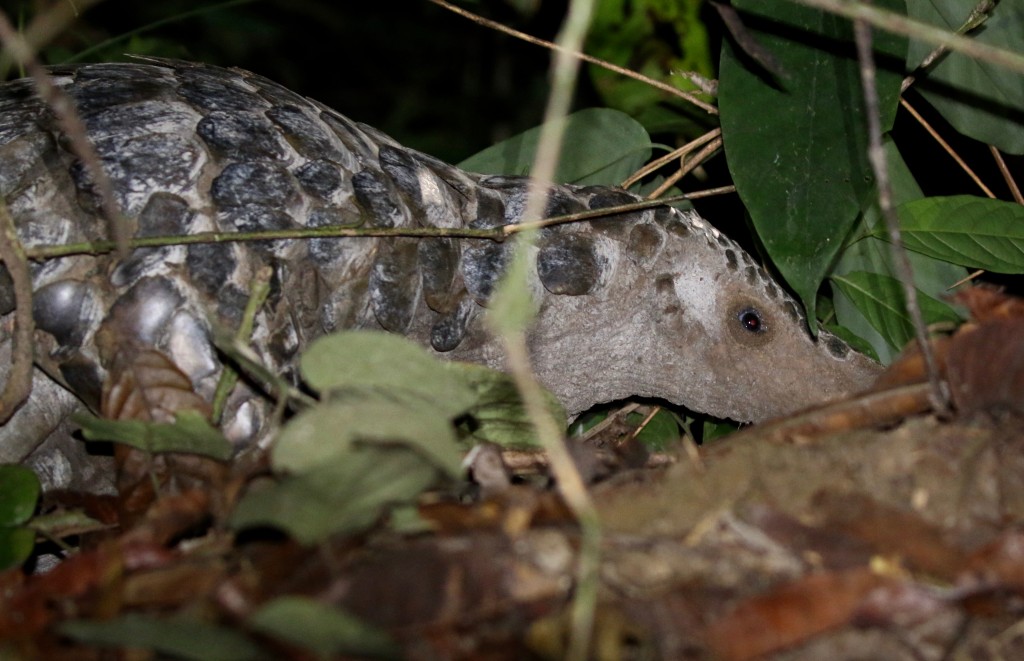
Giant Pangolin, Smutsia gigantia. Photo Sjef Ollers.
Thanks and Birds and Birders
First a massive thank you to my fellow travelers. Hour for hour it is hard to imagine any group putting in more effort and dedication. They were also a remarkably patient, tolerant and quiet bunch, even when dealing with the Lope Hotel dining room.
Second, thank you so much to all our guides. In particular Vianet was faultless both in organisational skills and temperament. And Ghislain – in Mikongo – was also fabulous. I hope a lot more business comes their way. David Lehmann in Lope was also great company – and a real expert – to be in the field with.
And thank you also to Guillermo from Middle Africa. I cannot really imagine how complicated it must be to organise a trip like this, but he did it, and did it with a smile on his face.
Thank you to Jakob Fahr from Afribats, Louise Emmons from the Smithsonian, and everyone else I will pester in future to try to get an ID on the small mammals we saw.
And finally an official commendation for the part-time birders in the group. This was, of course, a mammal trip and any birder knew what he or she was getting into. But that doesn’t make it easy. I know if I was with a group of birders on a birding trip and heard a mammal I wanted to see I would be near unstoppable. Yet Sjef and Kevin – the most birdy of our bunch – were paragons of understanding. So much so that I began to feel like a tyrant. If they so much as paused to look at a bird – even an interesting one – they would apologise for losing focus. Sometimes I felt I had almost to force them to stop for a minute to take a look at something I knew was a lifer for them. Even I got a kick out of the Vermiculated Fish Owl. So a big thank you to their focus and mammal dedication in the face of wicked temptation.
“Kevin and Sjef”, I said at lunch on our last day “should be named Goodwill Ambassadors for the Birding Movement.”
Charles responded, “God knows they need some”.
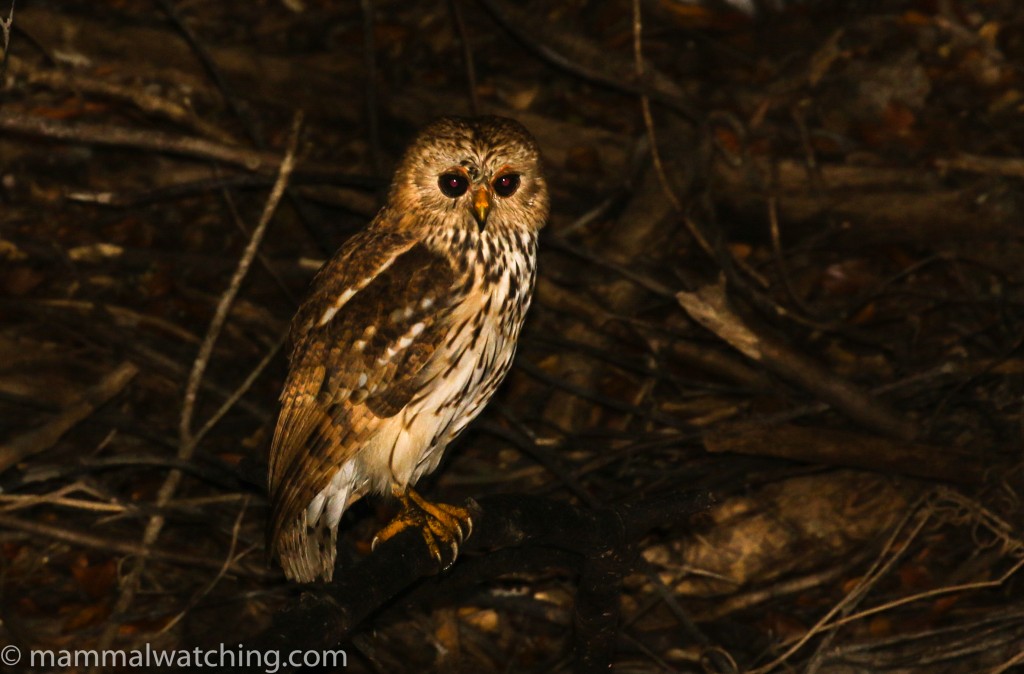
Vermiculated Fishing-owl, Scotopelia bouvieri
We – well they – saw over 180 birds, some of which would be considered good. A totally subjective Top 15 – prepared by Kevin and Sjef – is: Black Guineafowl, Bates’s Nightjar, African Finfoot, Green Turaco, Grey Pratincole, Vermiculated Fish Owl, Ayres’s Hawk Eagle, Long-tailed Hawk, Eastern Long-tailed Hornbill, Rosy Bee-eater, Rufous-sided Broadbill, Rufous-bellied Helmetshrike, Yellow-bellied Wattle-eye, Rufous-vented Paradise Flycatcher and Golden Greenbul.
They also prepared a full birdlist and short report which is here. I still don’t know what “vermiculated” means.
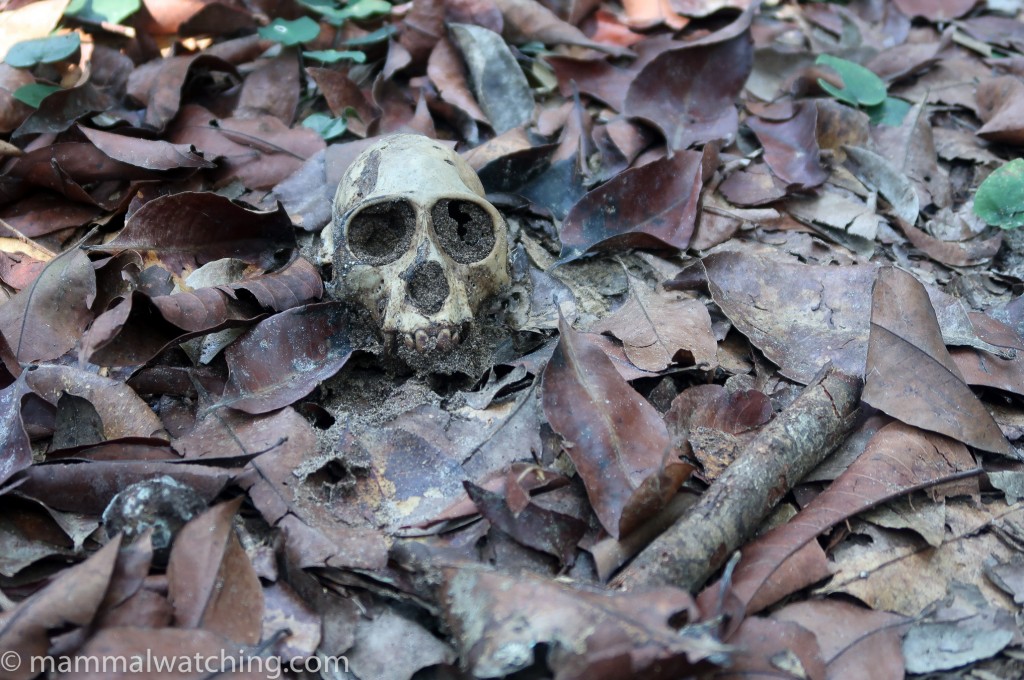
Chimp skull, Mikongo
18 Comments
-
-
Paul Carter
Thanks Jon for the report and organising the trip – it was indeed a great trip to have been on. Paul
-
Vladimir Dinets
Ever since I got a thermal imager I have a nagging feeling that I need to re-visit all places I’ve already been to…
Anyway, congratulations on a great trip! I certainly have to get to Mikongo Camp.
If you have insect bites that are still itching, they are almost certainly from chiggers. My method of avoiding them is to make DEET rings on my legs above ankles, around knees, and just above the lower end of the shorts. Taking shower with soap after every forest walk also helps, but isn’t always practical or possible.-
Jon Hall
That would have helped.. though in this case I got bites on my toes and fingers so I am not sure what bit me… and then the bits got infected. It was a bit of a worry when I showed infected finger to my Dr, he decided to send a swab to the lab for analysis and avoided shaking my hand to say goodbye!
-
Vladimir Dinets
If it’s toes and fingers it’s probably sand fleas. https://www.fleabites.net/sand-flea-bites-on-humans-pictures-treatment-and-prevention/
-
-
-
Vladimir Dinets
BTW, stopping for birds during forest walks actually increases your chances of seeing mammals. Birds often attend fruiting trees, mob concealed predators, move in front of army ant columns, or gather at ant/termite swarms. Also, bird flocks are often joined by squirrels or followed by small ungulates.
-
tomeslice
Wow – an absolutely fascinating trip report!
Giant pangolin aside (not that we can put it aside, but I think all the obvious remarks have been said), seeing chimps and gorillas anywhere “without any special effort” shouldn’t be overlooked! And then of course the mandrills, red river hogs and flightless anomalure..
It seems that Gabon is truly a virgin-y place, and one that needs to be explored before it’s too late.I also really liked your story about the birds, and I couldn’t agree more… Recently, in Central Sumatra, I was a little too bird-happy, when an explosion of colorful lifers appeared before me everywhere I looked. And thus, I may have rested a little too little during the day, and spent a little less time at night than I probably should have, resulting in, actually none of my most sought-after mammal species. In my defense, I did take a bit of a gamble with the location I chose, knowing how difficult and unpredictable the rare mammals of Sumatra are (you know as well as anyone). This lead me to remember that I’m much more insterested in mammals, and so for my next trip to the region (19 days of mammal watching on Borneo next Oct) I will: a) bring a heat scope, and b) only concentrate on mammals!!! 🙂
Anyway, good report as always.
Cheers! -
Samuel
OMG !! What a wonderful trip report to read. Probably one of the best I have ever read on MammalWatching. Thanks Jon for sharing it to our community.
Being also a keen birder myself and looking at the bird list of your trip, I’m also amazed by how many bird species you saw although not focusing on them and personnally I would have put in the Top 15 list Black Bee-eaters rather than Rosy bee-eaters 🙂
Now I have a question for you Jon: being interested in going to central Africa that I don’t know at all, what would you recommend me to visit first for a great mammalwatching experience between Dzanga Sangha area and Gabon?-
Jon Hall
Thanks Samuel – glad you enjoyed it. It is a difficult question to answer. The two places are very different. For out and out adventure then Sangha is hard to beat… the bai there is unparalleled and the lodge is really really great. But you would likely see a bigger diversity of species in Gabon. I’d be inclined to go to Sangha first … so when you go to Gabon later you can still see some new stuff. But go to Sangha in April when you have your best bet for Bongos (which you won’t see in Gabon and which I still haven’t seen yet)
-
tomeslice
Jon, I was wondering what you were going to reply for this question 🙂
Don’t forget that while in Sangha lodge you were just with Jean-Michele, and 0 heat scopes, in Gabon you were with about 9 others and 4 heat scopes! I wonder if you had visited Sagha lodge with the heat scope, if you would have doubled your list of species…?
-
-
tomeslice
You’re probably right.
And still, 30% could be a big difference… Even if you just took your list and added bongos, red river hogs, white-bellied pangolin, flighless anomalure and/or a flying mouse, brush-tailed porcupine, a couple more duiker species (which are totally possible with a heat scope, no?), and a tree hyrax, it would jump straight up towards the top of your mammal destinations, it sounds like. But we’re just guessing… I guess we’ll never know.
Well, until mammal watchers with heat scopes start showing up, that is. I’m looking forward to reading reports from there 🙂
-
-
-
-
-
-
Matt Miller
Fantastic trip report, Jon. You are really getting these mammal trips dialed in, even to areas where wildlife spotting is challenging. I have colleagues who have visited Gabon who consistently report how difficult it is to see mammals.
This isn’t the Serengeti with wildlife cavorting everywhere across the plains. I know a mammal list like this only possible due to your logistical planning, field skills, intense focus and sleep deprivation. Well done.
-
Jon Hall
Thanks Matt. Yes, true on all counts (especially sleep deprivation – though I got off lightly compared to those hardy souls who got up early most mornings to go birding!). Having such a talented and dedicated group really helped. In the places we went there were a lot of mammals. I would love to explore the rest of the country though surely it cannot all be so good.
-
Leave a Reply
You must be logged in to post a comment.


JoEllen Arnold
What a trip! Wonderful trip report—a delight to read!